- Subscribe Digital Print

- KOBAYASHI PHARMACEUTICAL
- Noto earthquake
- LDP scandal
- Latest News
- Deep Dive Podcast
Today's print edition
Home Delivery
- Crime & Legal
- Science & Health
- More sports
- CLIMATE CHANGE
- SUSTAINABILITY
- EARTH SCIENCE
- Food & Drink
- Style & Design
- TV & Streaming
- Entertainment news

Japan to tighten borders for travelers from China on Dec. 30
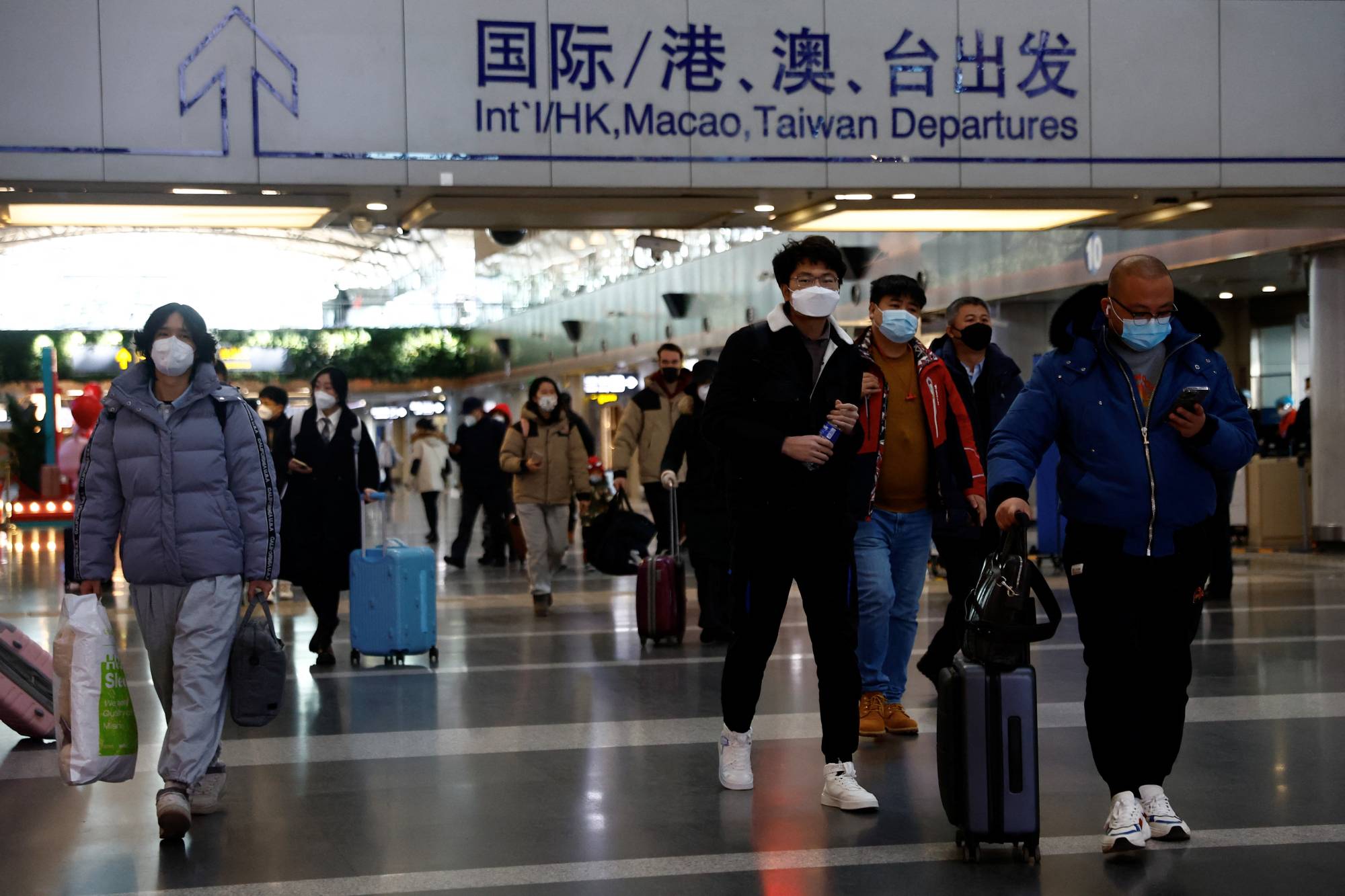
Japan will tighten its border controls for travelers from China on Friday, as the latter nation is seeing a surge in COVID-19 infections, Prime Minister Fumio Kishida said Tuesday.
Kishida’s abrupt announcement comes only a day after news that China will scrap its quarantine for incoming travelers from Jan. 8, one of the country’s most significant steps since it effectively abandoned its two-year “zero-COVID” policy.
All travelers from China, including Japanese citizens and returning foreign nationals living in Japan, as well as those who have been to China within the previous seven days will be tested for COVID-19 upon their arrival in Japan. Those who test positive will be required to quarantine at designated facilities for seven days.
The quarantine period for those who test positive is expected to be seven days if they have developed symptoms. For those who are asymptomatic, the period will be shortened to five days if they test negative on the fifth day, according to the health ministry.
The number of flights from China will also be limited to guard against a sudden increase in COVID-19 infections in Japan, Kishida told reporters at the Prime Minister’s Office. Arrivals from China, Hong Kong and Macao will be limited to four airports: Narita, Haneda, Kansai International and Chubu.
“It is difficult to grasp the situation in China because the information on infections differs between the central and regional governments, as well as between the government and the private sector,” Kishida said. “People in Japan are getting worried because of that.”
Kishida also stressed that the latest measure is temporary and that the government will do its best not to stop cross-border travel.
Before the pandemic, Japan’s tourism sector was reliant on foreign travelers, especially those from China, with the government pushing to increase inbound tourists to 60 million by 2030. In 2019, such visitors hit a record 31.9 million, of which 9.59 million, or about 30%, were Chinese.
Tourists from China often went on shopping sprees in Japan, dubbed “explosive shopping” in Japanese, with their spending amounting to 36.8% of the ¥1.77 trillion that came from all tourists in 2019, according to government data.
Foreign tourists were not allowed to travel to Japan for a long stretch of the pandemic. But even since Japan has reopened its borders, Chinese visitors have been scarce due to the COVID-19 restrictions in their country . In November, there were only 21,000 visitors from China, about 2% of all foreign visitors to Japan, according to the Japan National Tourism Organization.
China is currently experiencing an explosive growth in new COVID-19 infections, with some reports saying that 250 million people, or 18% of the population, have been infected with the virus in just the first 20 days of this month.
U.K.-based health data firm Airfinity, meanwhile, said Wednesday that, based on regional data, China is likely now seeing over 1 million cases and over 5,000 deaths a day, in stark contrast to official data showing 1,800 cases and only seven official deaths over the past week.
What’s driving the surge in cases in China is BF.7, short for BA.5.2.1.7, which is a sublineage of omicron subvariant BA.5, experts say.
Compared with the BA.1, BA.2 and BA.5 subvariants detected in the past, omicron BF.7 is better at evading the immune system and has a shorter incubation period and faster transmission rate, according to a Chinese medical expert quoted by China’s Global Times.
But while Japan’s latest border control measures seem to reflect concerns over this new type of the virus, some experts are calling for a more measured response.
“Japan will definitely see a further increase in the number of new cases,” said Tetsuya Mizutani, professor of virology at the Tokyo University of Agriculture and Technology. “But all of the recent new types that we are seeing worldwide are offshoots of BA.2, BA.4 and BA.5.
“As long as the virus keeps mutating within that range (of the omicron family), we shouldn’t worry much, though we should not be overly optimistic, either.”
Many experts have said the situation in China is being exacerbated by its lack of approval for the messenger RNA vaccines developed by Western firms.
“The Chinese vaccines were (marginally) effective for the original coronavirus strain coming out of Wuhan, China,” said Tetsuo Nakayama, a project professor at Kitasato Institute for Life Sciences.
But as the virus mutated, the Chinese shots — which are inactivated vaccines using coronavirus particles that have been killed, and as such are different from the mRNA vaccines developed by Pfizer and Moderna — lost their effectiveness, despite claims by manufacturers that they work against the omicron variant and its subvariants, he said.
Nakayama added that Japan should closely monitor infection trends, especially on how the virus is mutating, regardless of what border control measures are in place.
“Border controls cannot keep cases out,” he said. “As Japan’s COVID cases are also rising, we should watch out for new variants and evaluate their characteristics, including how pathogenic they are.”
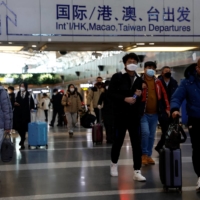
In a time of both misinformation and too much information, quality journalism is more crucial than ever. By subscribing, you can help us get the story right.
Japan to relax border controls for passengers from China from Wednesday
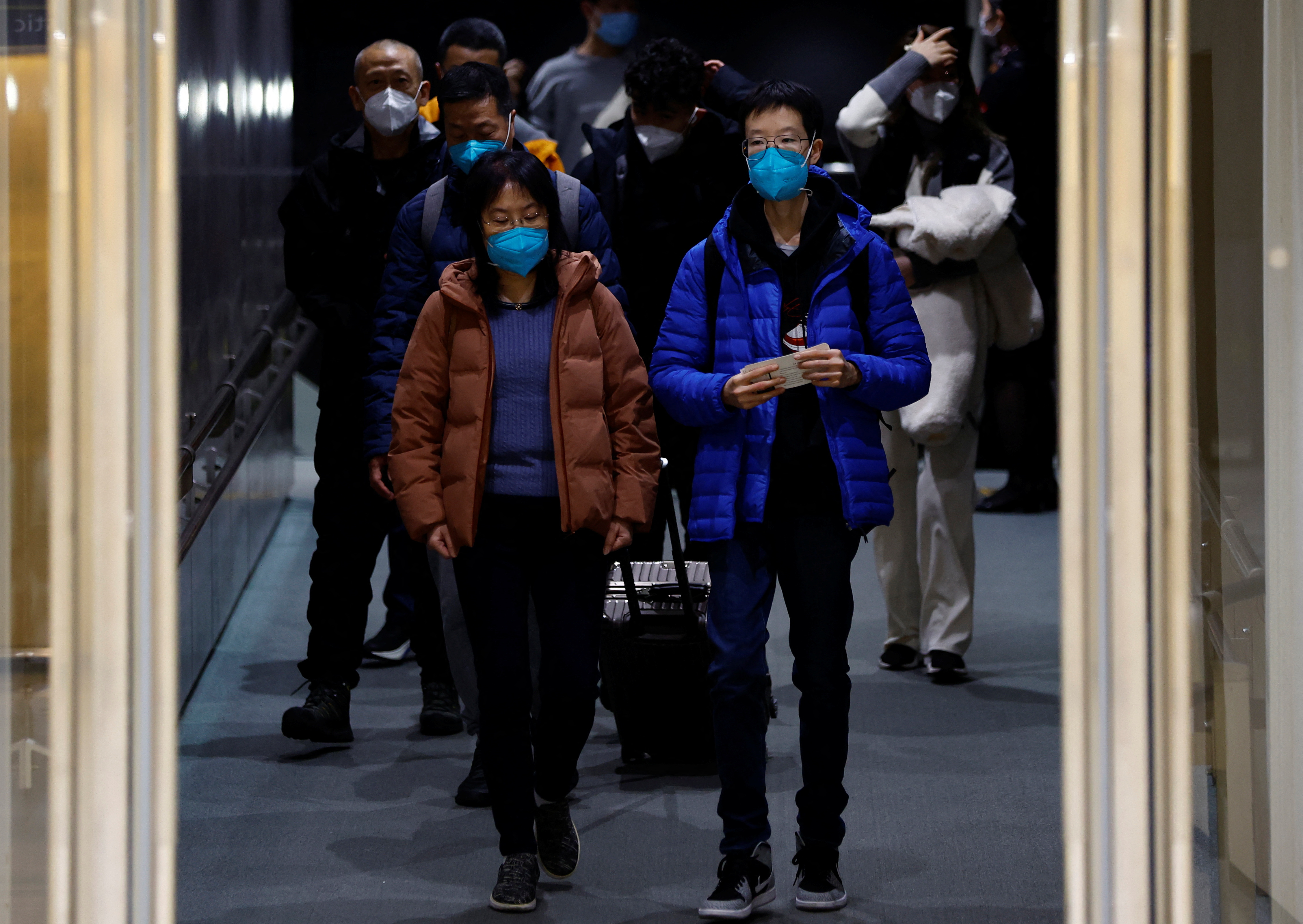
The Reuters Daily Briefing newsletter provides all the news you need to start your day. Sign up here.
Reporting by Kantaro Komiya and Eimi Yamamitsu; Editing by Himani Sarkar, Robert Birsel
Our Standards: The Thomson Reuters Trust Principles. , opens new tab

Thomson Reuters
Kantaro writes about everything from Japan's economic indicators to North Korea's missiles to global regulation on AI companies. His previous stories have been published in the Associated Press, Bloomberg, the Japan Times and Rest of World. A Tokyo native, Kantaro graduated from DePauw University in the United States and was the recipient of the Overseas Press Club Foundation 2020 Scholar Award.

A military base in the capital of army-ruled Myanmar came under attack by drones on Thursday, the shadow government and local media said, an attack a local armed resistance group claimed responsibility for.

A former U.S. Marine Corps pilot facing extradition to the United States from Australia will argue he was no longer a U.S. citizen at the time of two of the alleged offences, which include training Chinese pilots, a Sydney court heard on Thursday.

A Singapore court on Thursday jailed a second defendant in its biggest-ever money laundering probe, news outlet The Straits Times reported, a case that has seen the seizure or freezing of $2.2 billion of assets.
- Account details
- Newsletters
- Group subscription
After zero-COVID, Chinese tourists only trickle into Japan
Full recovery remains doubtful amid toughened entry restrictions
TOKYO -- The end of China's zero-COVID policy signaled the possibility of a renewed influx of Chinese travelers to Japan, but it appears traffic will not recover anytime soon as numbers at airports and tourist spots remain light.
Flights from mainland China to Narita International Airport serving Tokyo early this week remained about 80% below pre-pandemic levels, according to data from the airport's operator.
Flight constraints expected to weigh on China travel rebound
China crests first infection wave since abandoning zero-covid, analysis: china's elderly pay ultimate price for covid missteps, hotels, theme parks rush to open in asean as tourism rebounds, china slams who for doubting 'transparent' covid data, japan asks drugstores to prevent medicine hoarding by tourists, china suspends visa issuance for south koreans and japanese, china's new year travel set to double to 2bn trips after zero-covid easing, osaka, other japan cities offer subsidies to boost covid-hit tourism, ghibli park tickets go on sale for overseas visitors from tuesday, china's new year travel shows signs of recovery as restrictions ease, latest on travel & leisure, macao horse racing ends as casino income hits post-covid high, japan's kawasaki heavy offers helicopter trips to attract tourists, peninsula hotels group says $130m myanmar project still stalled, sponsored content, about sponsored content this content was commissioned by nikkei's global business bureau..
Nikkei Asian Review, now known as Nikkei Asia, will be the voice of the Asian Century.
Celebrate our next chapter Free access for everyone - Sep. 30
Japan or China: Where to travel next?
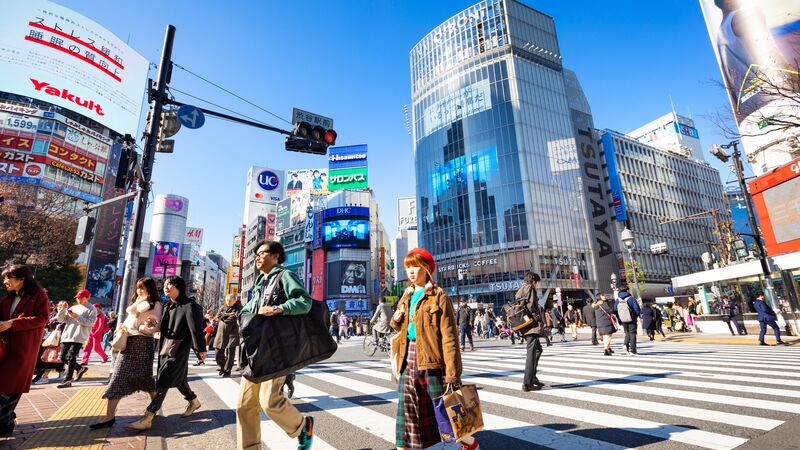
Because sometimes the hardest part of travelling is choosing where to go. ..
If you’re anything like me (and have an ever-growing bucket list), then it’s not easy choosing where to travel next. Especially when it’s between Japan and China. Both countries are steeped in history and boast incredible landscapes, world-class cuisines and more adventures than you can poke a chopstick at. Sigh .
If you’ve hit a brick wall, fear not. We’ve put together a handy guide comparing all the top considerations to help you out – we’re talking culture, food, cities, landscapes and weather. Failing this, you can always flip a coin.
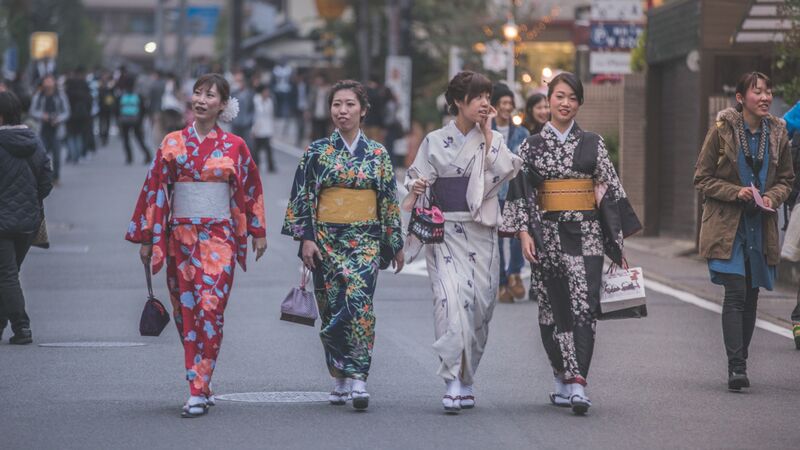
Japanese culture is a fascinating mix of old and new. On the one hand, there are thousands of years of traditions influenced by Shinto, Buddhism and Confucianism, but on the other is a trailblazing society setting trends in tech, fashion-forwardness and architecture. Sleek bullet trains whoosh past centuries-old temples and tea houses, and you might see geishas using state-of-the-art vending machines selling everything from lettuce to lobsters (only in Japan!).
Although the younger generations continue to push the cultural boundaries, social harmony is the pillar of Japanese society, and traditional values like saving face, humility and respecting your elders are just as important today. Ancient Japanese philosophies are also integrated into daily life, including ikigai (reason for being), omotenashi (providing impeccable hospitality without expecting anything in return) and kaizen (continuous improvement).
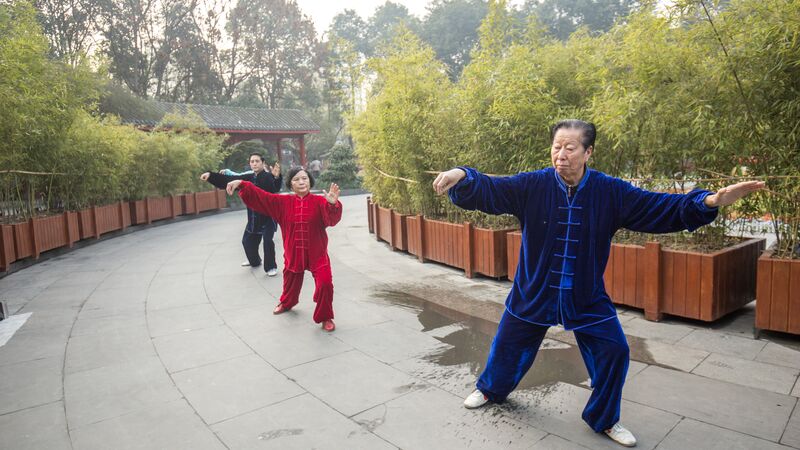
As one of the world’s oldest civilisations, China has an intriguing history of dynastic rule and ancient cultures influenced by Confucianism, Taoism and Buddhism. Relics of China’s dynastic past are littered throughout the country, including the iconic Great Wall and the Forbidden City. China has also gifted the world with many cultural riches including martial arts, Chinese medicine, kungfu, tai chi and Chinese calligraphy.
With 56 ethnic groups (the largest being the Han), modern Chinese culture is rich and complex. Though China continues to grow and change at a rapid pace thanks to a booming economy, centuries-old philosophies are interwoven in daily life – including the theories of the five elements and yin-yang – and traditional values such as family, social harmony and loyalty remain at the heart of society. This contrast between the ancient and the modern is particularly strong in cities like Shanghai where giant skyscrapers loom over traditional lilong houses.
SEE THE HIGHLIGHTS OF CHINA
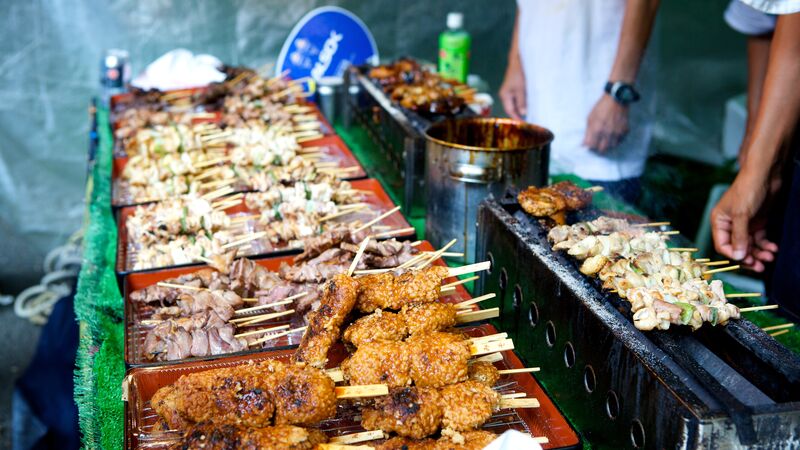
Japan brought sushi, ramen and tempura to the world (and for that, I’ll be eternally grateful), but there’s so much more on offer. Japanese cuisine is renowned for its fresh, seasonal produce and meticulous preparation. Most dishes comprise rice or noodles, a few side dishes and soup. Meat is a popular ingredient, though seafood is where Japan shines (hello, sashimi). Popular dishes include unagi (grilled eel), takoyaki (octopus dumplings), karaage (Japanese fried chicken), yakitori (meat skewers) and shabu-shabu (Japanese-style hot pot).
Feeling thirsty after all that soy sauce? Quench your thirst with a cold beer or glass of sake. Or swap your morning coffee for a matcha latte or antioxidant-packed green tea. Tea is a big deal in Japan, and if you attend a traditional Japanese tea ceremony you’ll never look at a cuppa in the same way again.
GO ON A REAL FOOD ADVENTURE IN JAPAN
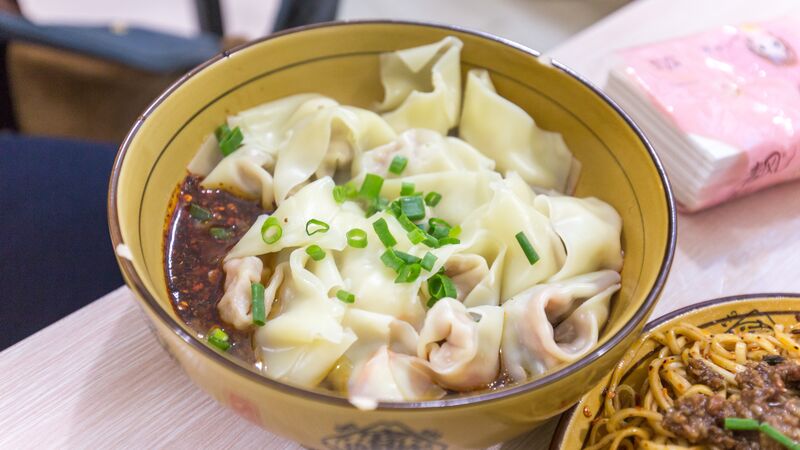
China is massive – and so nearly every region has its own cooking style. Generally, Chinese food tends to be heavier than Japanese with more spices, chilli and oil. It’s also meatier with lots of beef, pork and duck, though seafood and tofu are also popular. Famous dishes to try include kung pao chicken, Peking roast duck, Mapo tofu and char sui. A word of warning: it can be hard to find vegetarian and vegan food in China, but it can be done.
If you like it hot, then Sichuan is calling your name. This province is known for the fiery, sweat-inducing Sichuan pepper, which, according to ancient Chinese medicine, helps the body to expel dampness and prevent disease. You’ll definitely sweat after slurping on a Sichuan hot pot!
If you need to quench your thirst after all that pepper, try a refreshing beer (Snow and Tsingtao are two of the most popular brands), a baijiu cocktail or a glass of mijiu (a sweet, slightly bitter wine made from glutinous rice). Stay hydrated throughout the day with green, white or black tea – like Japan, tea is an integral part of Chinese culture.
GO ON A REAL FOOD ADVENTURE IN CHINA
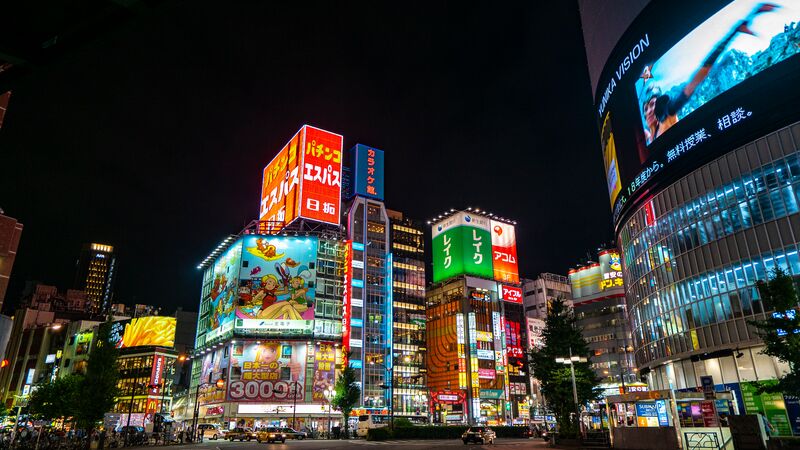
It’s impossible to deny the allure of Japan’s cities – even if you’re more of a nature lover than an urbanite. Tokyo is known as one of the coolest cities in the world with a fusion of futuristic technology and ancient landmarks. Get lost in the neon-lit streets, sip matcha in a quirky café in Harajuku or scramble your way through the famous Shibuya Crossing.
If you’re looking for culture, head to charming Kyoto to discover hundreds of colourful shrines and temples, relax in serene gardens and walk through Gion, Kyoto’s famous Geisha district. To get under the skin of Japan, head to Matsumoto to explore impressive castles, traditional storehouses and amazing soba noodles. History buffs should also go to historic Hiroshima to discover its shrines, peace parks and sizzling food scene.
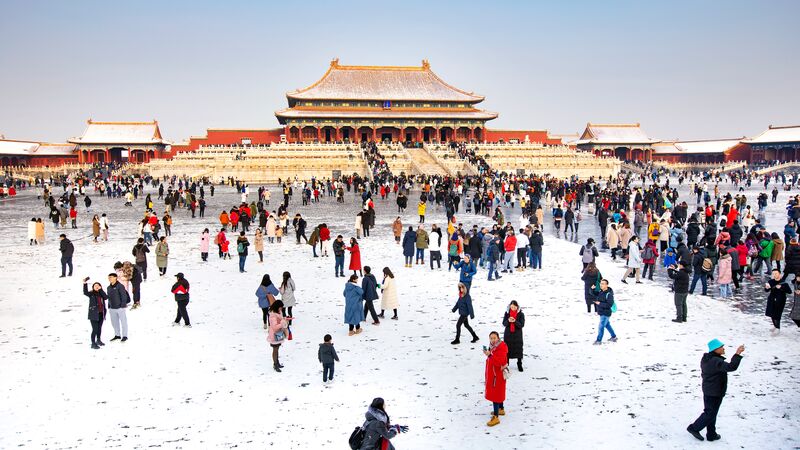
China has some of the oldest and biggest cities in the world. They might be crowded and chaotic, but they’re littered with landmarks that reveal China’s fascinating past. For culture, head to the sprawling capital of Beijing to visit seven UNESCO World Heritage sites, wind through a labyrinth of hidden hutongs, stroll along a section of the Great Wall and watch a dazzling Chinese opera show.
There’s also the frenetic Shanghai with its intriguing blend of cultures and architecture (think art deco buildings and lantern-lit canals hidden among towering skyscrapers). Enjoy the city’s eclectic food scene, see the Tudor mansions of the famous Huaihai Road or take a short train ride to Xitang – a charming water town that was once a hub for 19th-century trade.
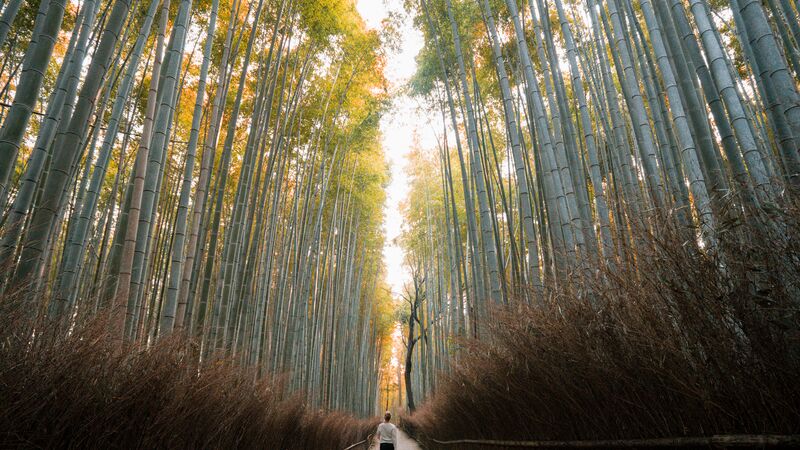
Japan has been blessed by Mother Nature in many ways with a diverse landscape of towering peaks, dense forests and pristine coastline. It’s also home to more than 100 volcanoes, including the majestic Mt. Fuji, due to its location on the Ring of Fire. Even in major cities like Tokyo and Osaka, you’re only ever a short train ride away from a beautiful nature escape.
If you like hiking, tackle one of the many trails of Mount Takao or head to Arashiyama Bamboo Grove in Kyoto to walk among towering bamboo. For water-based pursuits, cruise through the stunning Takachiho Gorge in Miyazaki or soak in Hokkaido’s mineral-rich onsens. It’s also worth visiting Miyajima Island off Hiroshima to meet some of its four-legged residents (spoiler alert: they’re deer).
HIKE, BIKE AND KAYAK THROUGH JAPAN
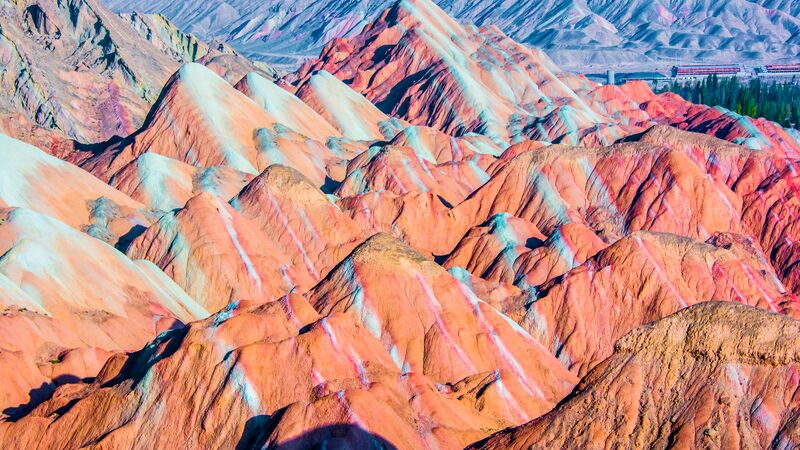
China is the third-largest country in the world and so the landscapes are incredibly diverse. In fact, China is a ‘megadiverse’ country with over 550 species of mammals, 1200 species of birds, 31,000 types of flora and 27,000 species of fungi. From beautiful wetlands to vast plateaus, and sweeping deserts to cascading rice terraces, there are breathtaking scenes to explore in every province.
Make your way to Guilin to admire karst hills from the picture-perfect Li River, witness the remarkable colours of the Rainbow Mountains in Zhangye Geopark, hike to the Golden Summit of Mount Emei to stand above the clouds or discover the floating peaks of Zhangjiajie (you might even recognise this scene from the iconic movie, Avatar ).
RELATED: 6 SURREAL LANDSCAPES TO EXPLORE IN CHINA
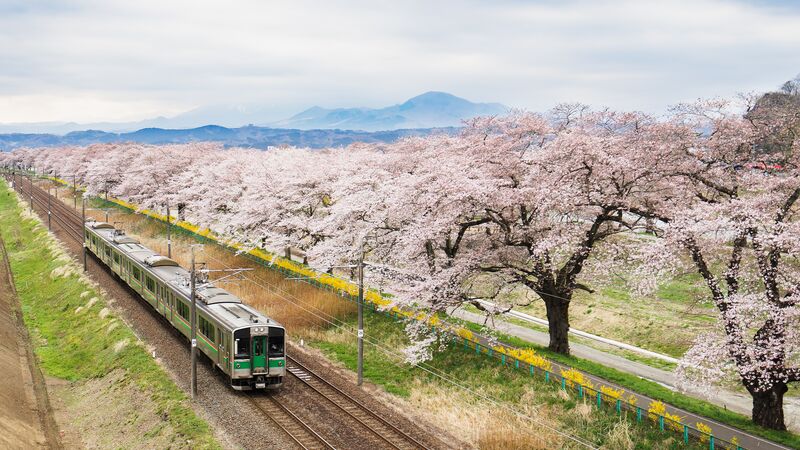
When it comes to weather, Japan has it all. Most regions sit in a temperate climate zone with four distinct seasons. There’s never a ‘bad’ time to travel to Japan, but spring (March to May) is one of the most popular seasons when the stunning cherry blossoms are in full bloom. There’s no sight quite like it!
September to November is also a fabulous time of year when the landscapes turn red, orange and gold with autumn foliage. Winter is mild in places like Osaka and Tokyo which get a light dusting of snow, while northern Japan gets dumped with powder – this means one thing: hit the slopes! Winter is the quietest time of year, but perfect if you want to explore the usually busy streets in solitude. Plus, a piping hot bowl of ramen hits differently when it’s cold outside.
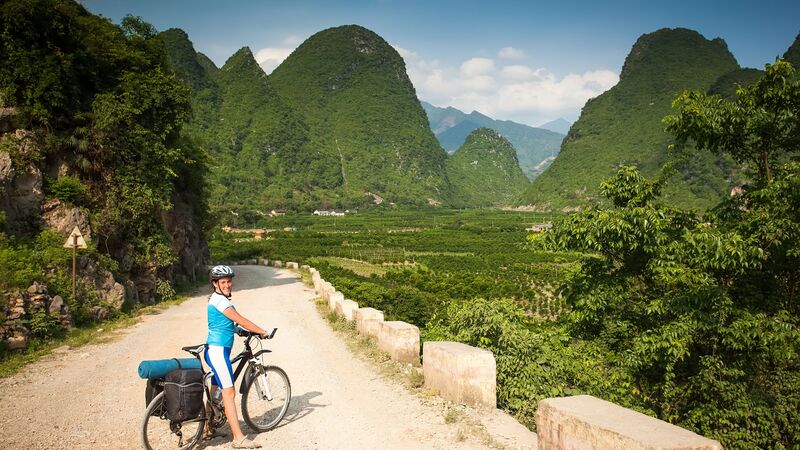
With so many climate zones, the weather varies a lot in China. Depending on when and where you visit, you might experience intense heat and humidity in summer and thick blankets of snow in winter. China’s northern regions have hot, dry summers, while destinations along the eastern coastlines and in the south are more humid. Snow is possible in winter in many regions, but especially in the northern reaches.
Hiking and outdoor activities are best in summer and autumn, though tourism usually peaks between June and August so bear this in mind if you want to dodge the crowds. Winter is the low season, but it’s a fantastic time for cultural festivals with the Harbin Ice and Snow Festival and Chinese New Year. For mild weather and smaller crowds, a shoulder month like October or May might suit.
RELATED: BEST TIME TO VISIT CHINA
The verdict
This one’s a solid draw. Both destinations promise to deliver with delicious food, culture, history and breathtaking landscapes. Japan is smaller than China and so it might be easier to cover more ground and experience more culture in a shorter space of time, but you’re bound to have an unforgettable adventure no matter which country you choose.
Feeling inspired? Check out Intrepid’s small group tours in China and Japan .
Feeling inspired?
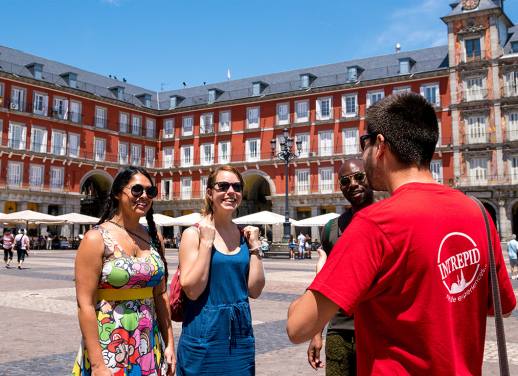
Cliona Elliott
Originally from Jersey (the tiny island in the English Channel), Cliona now lives in Melbourne, Australia. When she's not writing about all things travel for Intrepid, you'll find her chasing flavours, getting lost in local markets or waking up at a ridiculous time to watch the sunrise from the top of a mountain.
You might also like
5 reasons to visit sri lanka in the..., why 2024 is the best year to see..., 6 unique experiences you can have in el..., from delhi to udaipur, here are the five..., cinque terre vs amalfi coast: which destination to..., love at first bite: 10 famous sandwiches from..., galapagos or madagascar which unique destination should be..., central vs south america: how to plan your..., why road-tripping is the best way to see..., lessons learned on intrepid’s sabah adventure, travelling to chile here’s the best time to....
- Philippines
- New Zealand
- Netherlands
- United Kingdom

Asia has long been regarded by travelers from all over the world as one THE best continents to visit. Southeast Asia in particular is an incredibly popular region, but we think the somewhat overlooked (and magical countries) of East Asia deserve to be on your bucket list too! China and Japan are two of the most well-known countries in the area and while they are relatively close to each other, each has its own individual charm.
We totally get that not everyone has the time or budget to go galavanting around the globe, so every once in a while, you may find yourself torn between two awesome destinations. In this case, China or Japan? We’re going to be straight with you, it is not an easy choice! Both countries have delicious food, breathtaking landscapes, and are a LOT of fun… all the hallmarks of a great vacation (how will we ever choose???).
If you’re pulling your hair out because you simply can’t decide, worry not, because we’ve got you covered! Keep reading as we compare attractions, accommodation, food, nightlife, and more, to see which country comes out on top as our overall winner!
Table of Contents
China vs Japan: Accommodation

You will find some seriously great places to stay in both China AND Japan. However, Japan overall has more choice. There are roughly 26,000 properties listed on Booking.com for Japan, whereas in China, there are only around 12,250 properties. Both countries have one to five-star hotels available, but China has a lower proportion of one-star hotels and a much higher proportion of five-star hotels.
Find A Travel Buddy!
There is a range of property types in both countries. You’ll find beach resorts by the ocean, high-rise hotels in big cities, and guest houses in smaller towns. Overall, the selection is great in both places. Japan is famous for its uber-cool and futuristic capsule hotels. They contain pods that act as self-contained hotel rooms, with a bed, lights, and maybe even a TV if you’re lucky. This one in Tokyo is giving us some serious sci-fi vibes and is worth checking out!
China has its fair share of unique properties too. This property in Hunan Province has an incredible clear dome for rent which sits on a private platform in the forest canopy (#goals). If that wasn’t baller enough, it is right on the doorstep of Zhangjiajie National Forest Park, the location that inspired the movie Avatar’s “Hallelujah Mountains” *jaw drops*
Winner: Draw – It’s a tie! Even though China has fewer choices, both countries have a wide range of properties to choose from, as well as some unique ones to make your getaway extra memorable.
China vs Japan: Food

Food, food, glorious good. It’s safe to say that you will NOT go hungry in either China OR Japan, and nor will you be disappointed by the local cuisine. Both Chinese and Japanese food are famous worldwide for being mouth-wateringly delicious, so, you can’t really go wrong with trying some authentic dishes, can you? Different regions in Japan and China are famous for different dishes. For the best Peking duck, head to Beijing and more specifically Beijing Da Dong. Tokyo is the most famous place in Japan for what’s considered the “original” style of ramen, but if you love miso-broth ramen as much as we do, then you should head to Sapporo.
In China, you will be able to find vegetarian and vegan-friendly food. A proportion of the population is Buddhist and many practice vegetarianism or veganism. However, you will still have to look a little harder than in Western countries. Be prepared to eat a LOT of tofu, since they don’t have the vast number of meat-free alternatives we are used to in the West. Japanese diets are heavily centered around seafood, so while you can easily avoid meat and dairy, finding vegetarian or vegan dishes will be more difficult. Even meals that seem free of meat and other animal products, can have non-vegetarian/vegan-friendly stocks and sauces, so be wary.
Winner: Draw – What can we say, it’s another draw folks. Both countries have ridiculously awesome food, BUT, if you’re a vegetarian or vegan, China may just sneak ahead to take first prize!
China vs Japan: Price

Sadly, for most of us, price plays a huge role in where we decide to go on vacation. Of course, if you’re a massive shopaholic and love eating out at fancy restaurants, your holiday will definitely cost more. But what about those on a budget? Which is cheaper, China or Japan? Japan already has a bit of a reputation for being pricey, especially in Tokyo, so it may not be the ideal place to go if your purse strings are tight.
According to budgetyourtrip.com, the average tourist spends 130 USD a day in Japan, compared to 72 USD a day in China! That means a one-week vacation in Japan will set you back over 900 USD, whereas a similar trip in China will cost just over half of that at around 500 USD.
One of the main reasons why Japan is so expensive compared to China is its location. Japan is a group of islands so many of its everyday goods are imported, raising the prices. Furthermore, the Tokyo Metropolitan Area is also one of the most densely populated metropolitan areas in the world! So, this explains the steep rental prices and maybe the popularity of capsule hotels.
Winner: China – China is our hands-down winner when it comes to price, we love you Japan, but why do you have to be so hard on our wallets???
China vs Japan: Getting around

When it comes to getting around China and Japan, there are some similarities, but there are some differences too. China is a hell of a lot bigger than Japan. Simply put, it’s MASSIVE. Not so simply put, China covers an area of just under 9.6 million km². Japan on the other hand is just under 378 thousand km², although its various islands should be taken into consideration, as this makes getting around more complicated.
Due to its sheer size, the best and most convenient way to travel long distances in China is by airplane. But, if you’re on a budget or have a little more time, bullet trains are also a great way to travel between cities. In Japan, traveling by train is by far the most popular option. They also have bullet trains (or Shinkansen) linking major cities, but their other rail services are comfortable, clean, and can go through some very scenic routes *cue Studio Ghibli background music*.
For longer journeys, like Tokyo to Sapporo, they also have overnight sleeper trains! To reach farther-flung destinations or islands like Okinawa air travel is definitely the way to go, but booking in advance will save you a lot of money, so some degree of planning is required!
Winner: Japan – We just can’t get the image of a cute little train bumbling through the Japanese countryside out of our heads.
China vs Japan: Climate

China is HUGE (read: above), which means the country has a wide range of climates. There’s even a freaking desert in China, yep, a desert! Generally speaking though, winters in China are freezing in the north, and much more mild in the south. The entire country, except for mountain peaks and highlands, is hot over the summer and summer is by far the rainiest season! Japan follows a very similar pattern, in that wintertime is cold, snowy, and icy in the north, temperate in the center, and subtropical in the far south. The whole country is prone to the monsoon season which brings torrential rains in summer and fall.
Both countries have areas that experience snowfall in winter, and skiing is a popular past-time for locals and tourists, with numerous ski resorts available to choose from. China and Japan also have sub-tropical/tropical climates in the south, with some amazing beaches and coral reefs too!
Winner: Draw – It has got to be a draw. We’re talking about TWO countries where you can ski in the winter and snorkel in the summer. It doesn’t get much better than that…
China vs Japan: Top attractions

It’s time to talk TOP attractions, and if our decision wasn’t already hard enough… both China and Japan have some once-in-a-lifetime sights! These include historical and natural attractions, with a bonus furry, little (or should we say… giant ) friend! One of THE top things to see in Japan, and its most famous landmark is Mount Fuji. It is recognized worldwide and in summer, over one million people climb to its summit as a pilgrimage of sorts. To rival this, China’s most well-known landmark is the Great Wall of China. It hardly needs an introduction, but the wall spans over 6,000 kilometers with some parts dating as far back as the 7th century BC. Now that’s old.
However, without a doubt, one of our favorite must-sees in China is the giant pandas! The Sichuan Giant Panda Sanctuaries are home to over 30% of the world’s population and the Chengdu Giant Panda Breeding and Research Base is a top place to see these amazing creatures while supporting their conservation. Our “thing you cannot miss” in Japan, is the iconic sakura or cherry blossoms. In springtime parts of the country are transformed into a sea of pink as the cherry trees bloom. It’s a truly magical time, but prices can skyrocket so beware!
Winner: China – Boy it was tough, but the giant pandas definitely pushed China towards victory!
China vs Japan: Nightlife

Neither China or Japan is particularly well-known in Asia for their nightlife . However, just because the after-hours scene is a little different from what we’re used to, doesn’t mean it should be overlooked!
Drinking and eating are an important part of Japan’s nighttime culture, with many people heading to an izakaya, the country’s version of a British pub or Spanish tapas bar, after work. They tend to serve small, inexpensive dishes like edamame or grilled meat to be eaten alongside beer, sake, umeshu (plum wine), and shochu (a local spirit). For a more lively night out, you can head to a karaoke venue (karaoke was invented in Japan), or check out museums, aquariums, and theme parks, many of which stay open until 9 or 10pm!
In China, aside from a normal “night out”, you can also enjoy something a little different when it comes to evening entertainment. You could find yourself spending the evening at the colorful Chinese opera, watching an acrobatic performance, or like in Japan, singing your heart out at karaoke! Eating is also a big deal in Chinese nighttime culture, and there are plenty of fantastic night markets all over. The Donghuamen Night Market in Beijing is even considered one of the best night markets in the world!
Winner: Draw – They both sound hella fun tbh…
China vs Japan: Capital cities

Beijing or Tokyo… Now that is the question. Both of these cities have got to be amongst some of the liveliest in the world. They’re rich in history, culture, and house some of the country’s top attractions. Beijing is cheaper than Tokyo, with a meal at a mid-range restaurant for two costing on average 40 USD in Beijing versus 53 USD in Tokyo. However, if we remove price as a factor, both cities have a lot going for them and are equally matched.
Beijing houses the Forbidden City, the Summer Palace, and the Great Wall which is easily accessible from the city. It also has the biggest tea market in north China on Maliandao street. Over 900 vendors sell pretty much any type of tea imaginable, if you’re a tea-lover, it’s a MUST. Tokyo on the other hand not only has historical buildings like the imperial palace but has several famous districts known for their weird and wacky culture! Harajuku is a renowned fashion district and is an insight into Japanese pop culture, with kawaii fashion stores, manga shops, and cute cafes. Shibuya is one of the most well-known shopping areas and is home to the Shibuya Crossing which is famous worldwide.
Winner: Tokyo – it’s wacky, it’s wonderful, we love it.
China vs Japan: The final verdict
You’ve made it this far, and now for our final verdict… Drum roll pleaaaaase… It’s a draw ! Yes, that’s right, we simply cannot decide. Both countries are so full of life, culture, and not to mention have GREAT food. Whether you visit China or Japan, you’ll have a blast. Although, if Japan was a little cheaper, it may have just nabbed the top spot!
Destinations
- North America
- South America
- Group Tours
- Cookie Policy
- Privacy Policy
- Terms & Conditions
© 2022 Journeying The Globe. All Rights Reserved.
Got a Travel Question?
Ask questions, get inspired, and plan your next adventure with us! Join our free Facebook group for travelers and connect with a global network of passionate explorers.
JOIN FOR FREE
- TRAVEL BLOG
- TravelSites
Japan vs China! Which is best to travel?

Leisure travel to the Asian subcontinent is becoming a much more popular option these days compared to the usual holiday choices like Hawaii or Jamaica. Research studies and statistics show that many travelers are heading east and exploring the lands of Asia. There are many Asian countries to explore and enjoy. Choosing between them can be a big challenge. Many Asian countries share some similarities, yet they all have their own unique lifestyles, cultures, and identities.
For an unforgettable Asian experience, Japan vs China is two terrific countries to visit . They both have a lot to offer, with each one having its advantages. If you’re trying to choose between them, we’re here to help. This guide will look at key aspects of China and Japan travel to help you make the right choice.
Key Takeaways from the article “Leisure Travel: Japan vs China – Which is the Better Country to Visit?” are:
- Rising Popularity of Asian Subcontinent: Leisure travel to the Asian subcontinent is becoming more popular compared to traditional holiday choices like Hawaii or Jamaica. Many travelers are exploring countries in Asia, with an emphasis on Japan and China.
- Diverse Asian Countries: There are many Asian countries with unique lifestyles, cultures, and identities. Choosing between them can be a challenge as they offer both similarities and differences.
- Japan vs China Travel: Japan and China offer unique experiences, and both have their own advantages. The article provides a comparison of various aspects of travel in these two countries to help readers make an informed choice.
- Population and Size: China is the world’s most populous country, with over 1.4 billion people, while Japan has about 125 million people. China is also much larger in terms of physical size.
- Attractions in Japan: Japan is known for its historic temples, modern cities like Tokyo, and diverse landscapes, including beaches and snow-capped mountains. It offers a blend of tradition and modernity.
- Attractions in China: China boasts iconic landmarks such as the Great Wall and the Terracotta Army, along with a rich cultural heritage, diverse regional cuisines, and picturesque landscapes.
- Travel Costs: China tends to be more budget-friendly for travelers , with lower daily travel costs compared to Japan. Accommodation , food, and transportation are generally cheaper in China.
- Accommodation: Accommodation options in China include budget hotels and hostels , with a variety of choices in big cities. Japan offers a mix of traditional and Western-style accommodations, including ryokans and hotels.
- Weather and Best Time to Visit: China’s vastness allows for diverse climates, with warm and sunny regions in the south and cold winters in the northeast. Japan has four distinct seasons, with cherry blossom season in April being popular but crowded.
- Public Transportation: Japan is known for its efficient public transportation , including bullet trains, while China has both conventional and high-speed trains, as well as cheap domestic flights.
- Beautiful Places: Both countries have beautiful natural and cultural sites to explore. Japan offers serene temples, iconic Mount Fuji, and bustling Tokyo. China features water towns, the Huangshan Mountain, and the Great Wall.
- Safety: Both countries are generally safe for travelers, with low tourism-related crime rates. Japan has a lower overall crime rate compared to China.
- Cultural Immersion: Both countries offer unique cultural experiences. China’s vastness provides diverse cultural encounters, while Japan’s smaller size allows for a deeper dive into specific aspects of its culture.
- Festivals: Both countries have vibrant festivals. In Japan, the Gion Matsuri and Sapporo Snow Festival are notable, while China’s Chinese New Year celebrations and Lantern Festival are must-see events.
- Language and Communication: English is spoken in major tourist areas in both countries, but learning basic local phrases can enhance your experience.
- Packing and Cultural Etiquette: Each country has its own customs and traditions to be aware of, such as blowing your nose in public being considered rude in Japan. Packing for weather variations and respecting local customs is important.
- Overall Budget and Value: China tends to offer better value for travelers on a budget, with lower costs for food, accommodation, and activities compared to Japan.
- Choosing Between Japan and China: The decision between Japan and China as a travel destination depends on personal preferences, interests, budget, and the type of experiences you seek.
Remember that the choice between Japan and China ultimately depends on your individual preferences and what kind of travel experience you’re seeking. Both countries offer unique and enriching opportunities for exploration and discovery.
What are some similarities and differences between China vs Japan?
China is the world’s most populous country. It’s home to an astonishing total of over 1.4 billion people. Japan, meanwhile, is home to about 125 million people. China is about 25 times larger than Japan in terms of physical size.
This means that there’s a lot more ground to cover and places to explore in China. But size isn’t everything. Japan might be smaller, but it’s still an extraordinary place. Known as ‘The Land of the Rising Sun’, Japan is home to historic temples and modern cities.
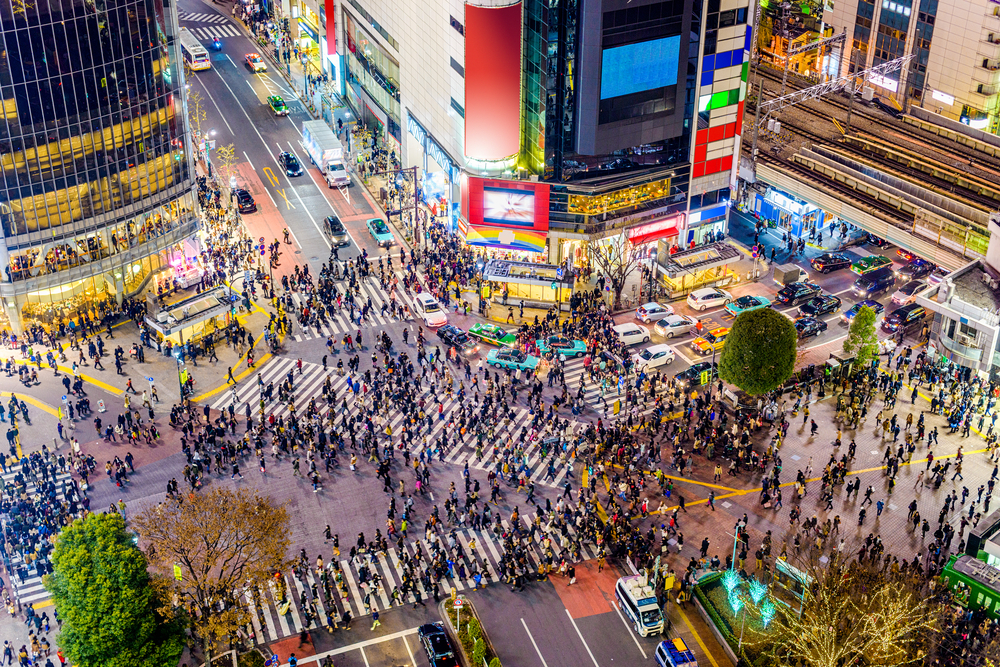
Japan, is home to about 125 million people
Sitting in the Pacific Ocean and made up of several islands, Japan is a rich, varied, vibrant destination. It’s a place where you can feel like you’ve teleported into the future as you explore the streets of Tokyo. The very next day, you can travel back to the past and take a tour of the country’s old shrines and castles.
China is also a place that fuses both the old and the new. It has some of the oldest and most awe-inspiring temples and ancient sites around. Equally, it has lots of modern, almost futuristic cities like Shanghai and Beijing.
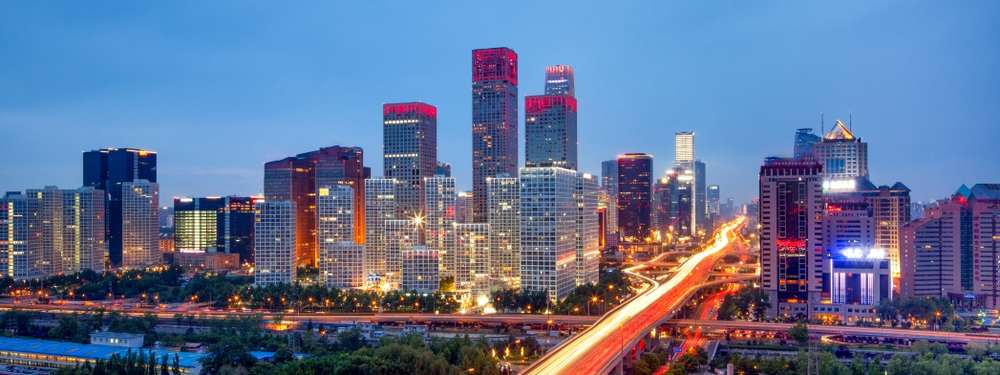
China is the world’s most populous country
Both of these countries share some similarities. They both honor the past and embrace the future. They can both appeal to a wide range of travelers. And they can both make your nomadic vacation dreams come true.
How much would it cost to travel to Japan vs China? Is Japan expensive? Is China expensive?
The first thing many people think about when planning a trip is the budget. For some, money is no object. But for most people, money matters when traveling. Many people need to plan vacations with care to ensure they can afford everything. So how do Japan vs China compare when it comes to costs?
Well, if money is the number one factor for you, China is the best choice. Japan is quite an expensive place to travel to. In fact, general daily travel costs in Japan can be about twice as high as what you would expect to pay in China.
Accommodation is more expensive in Japan, with minimum hotel rates of around $60 per night. In China, you can find a hotel at half that price. Food is also more expensive in Japan on average. However, both countries have a lot of street food vendors offering cheap and tasty treats.
A bottle of water costs almost twice as much in Japan and public transport is more expensive too. All in all, average daily costs in Japan are upwards of $100 per traveler. In China, you can probably spend about $50-60 per day and still have a great time.
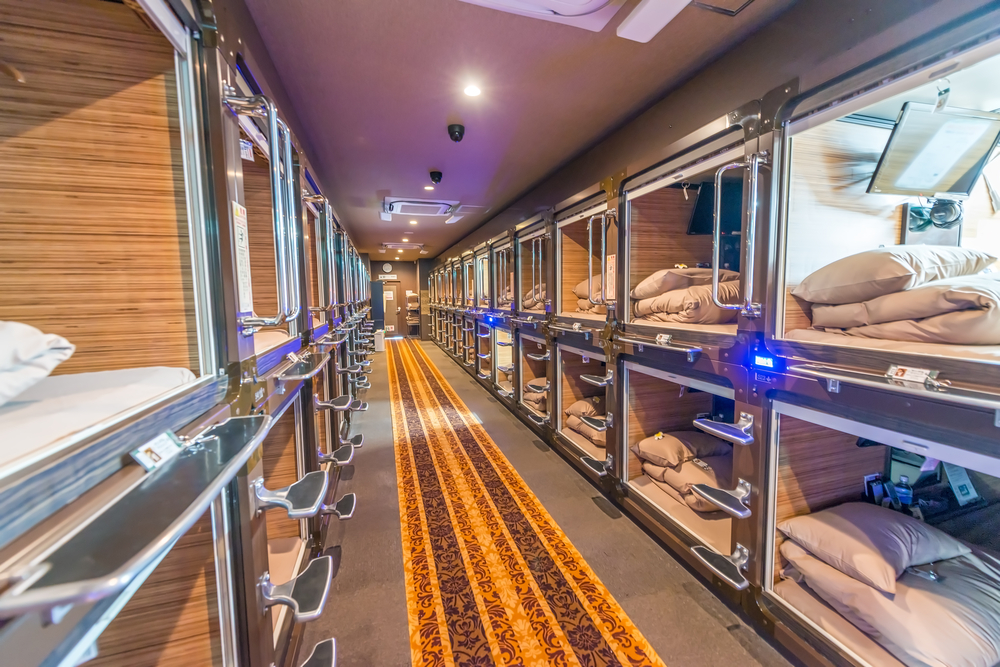
Are hotels nicer in China vs Japan? Are hotels more cost-effective in China?
For starters, China has a lot of basic, budget hotels. These places will typically offer quite small and simple rooms. They usually have Wi-Fi access and basic amenities.We’ve seen that accommodation is cheaper in China. But how do the countries compare in terms of accommodation quality and options?
There are also lots of hostels around China for young travelers or those on a budget. The big cities offer more options in terms of high-end hotels. If you’re visiting the rural regions of China, they often don’t offer a lot of choices.
Japan is more of a ‘westernized’ nation with more options in terms of accommodation. You’ll find a lot of private rentals around big cities like Tokyo. These places allow you to stay in a real local home and enjoy all the usual comforts.
For hotels, there are both Western-style and Japanese, traditional options. Standard Western-style hotels offer great amenities and large rooms for travelers.
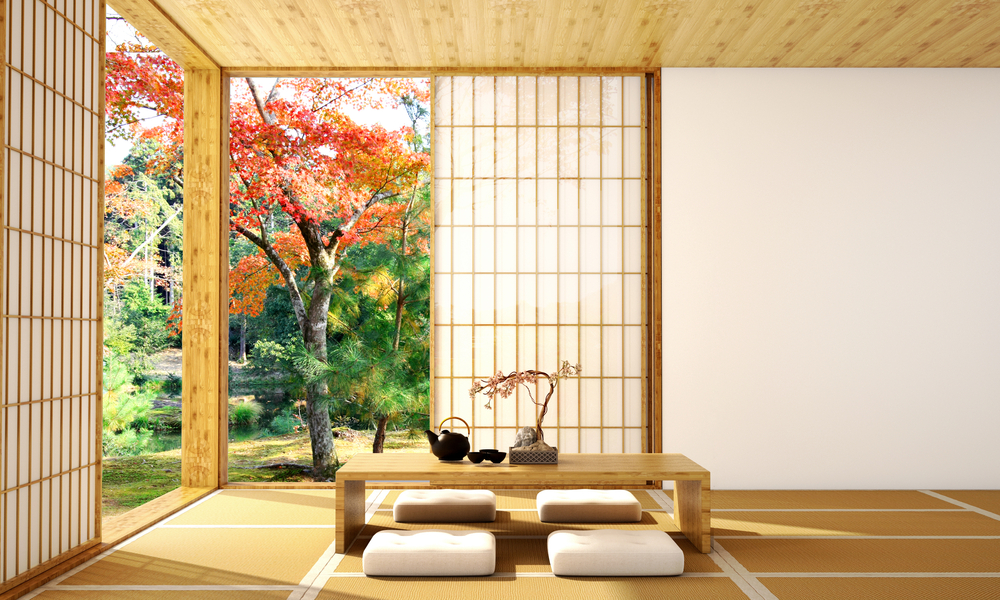
Accommodation is more expensive in Japan
The Japanese options like Ryokan and Minshuku are usually family-run places. They usually provide breakfasts and dinners with your room fee. They also feature typical Japanese elements like sliding doors and tatami flooring.
Japan also has its famous ‘love hotels’ as well as themed hotels. There are also capsule hotels with very small sleeping pods in Japan. You can find a few of these pod hotels in China too. Overall, Japan has more options but higher prices.
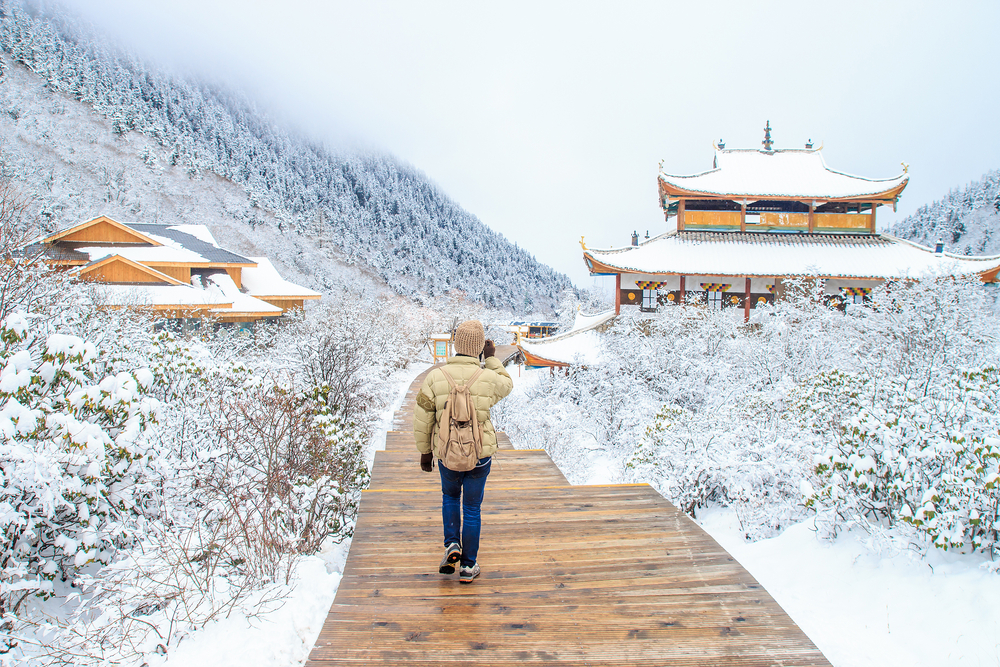
Snow season, China
What’s the weather like in Japan vs China and when is the best time to visit these countries?
Sometimes, we have to plan our vacations at certain periods of the year. This can be due to a variety of reasons like school and work. It can affect the destinations we choose, as the weather conditions can vary a lot throughout the year.
One advantage of China is its size. Since it’s such a large country, you can always find warm and sunny places. Southern China is always sunny, with lots of hot days and summer-style activities. If you prefer cooler weather, the northeastern part of the country has cold, snowy winters.
There are even special winter and ice festivals in the northern regions of China. So, there’s never really a bad time to visit. Plus, with China being so vast, you don’t need to worry about huge crowds of tourists everywhere. You can always find a place that is less busy than the others.
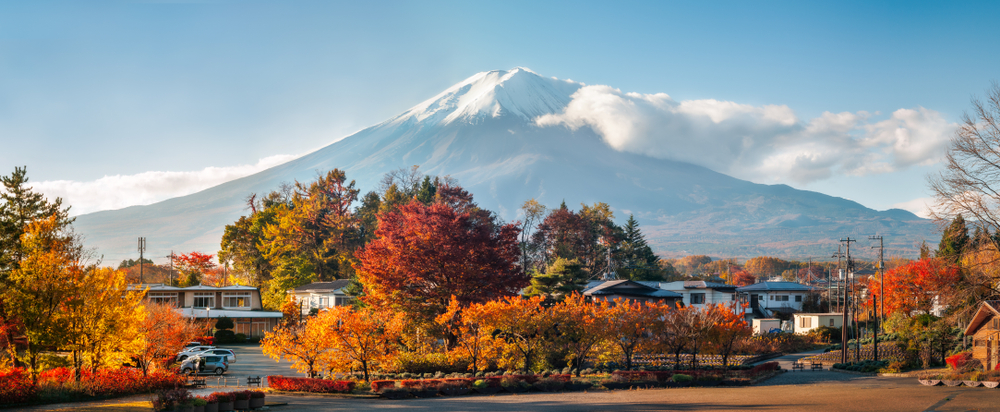
In Japan, it’s a bit of a different story. Japan is much smaller than China and mostly has the same weather all over. It has four distinct seasons like many other countries. In winter, Japan can have a lot of snow and quite cold temperatures.
Springs and falls are quite mild in Japan. Summers can be warm, but not especially hot unless you’re visiting the southern parts. Many people flock to Japan during the ‘shoulder months’ on either side of the summer-like April, May, September, and October.
April is very popular in Japan. This is when ‘cherry blossom season’ occurs in which Japan’s famous cherry trees blossom beautifully with lots of pink petals. This is a great time to visit, but it’s very busy. If you want to avoid the crowds and still get mild temperatures, May and early fall are the best moments.
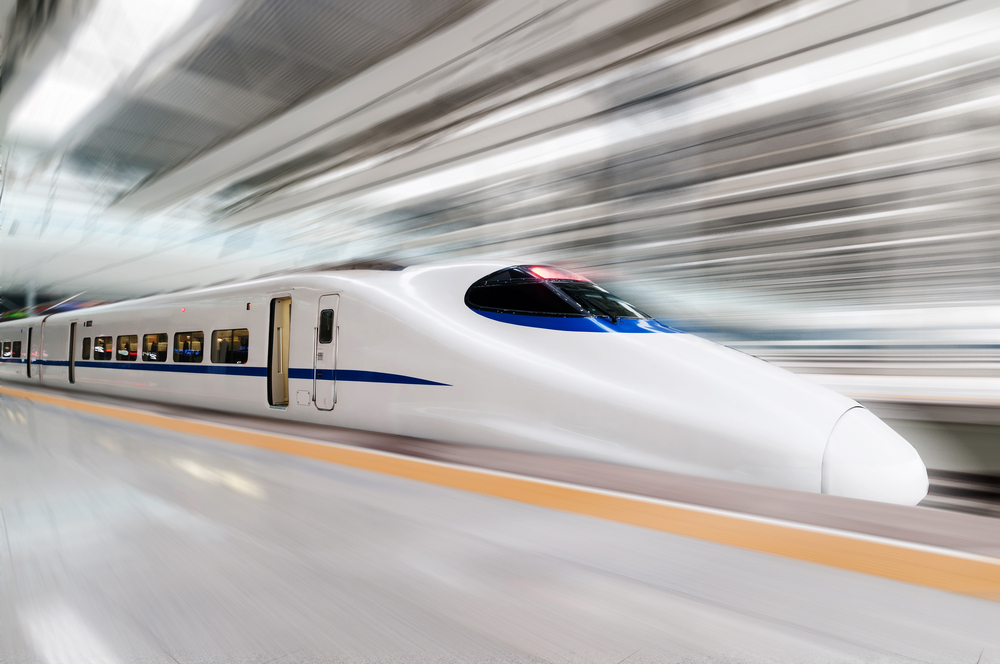
Japan leads the world in its public transport
What’s the best way to get around when visiting China or Japan? How good is public transportation in each country?
Japan leads the world in its public transport. The nation is famous for its ‘bullet trains‘. These trains are the fastest in the world. They move at incredible speed and they’re always on time. This makes getting around Japan very simple. You can travel between cities and even hop around the different islands with ease.
In cities like Tokyo, the metro systems also make it easy to get around. You need to be careful on the streets, however. Jay-walking is often punished and the streets can be super busy. The rules are strict and there are even special agents to push people into trains during rush hour periods. This means that getting around Japan is easy but can be quite stressful.
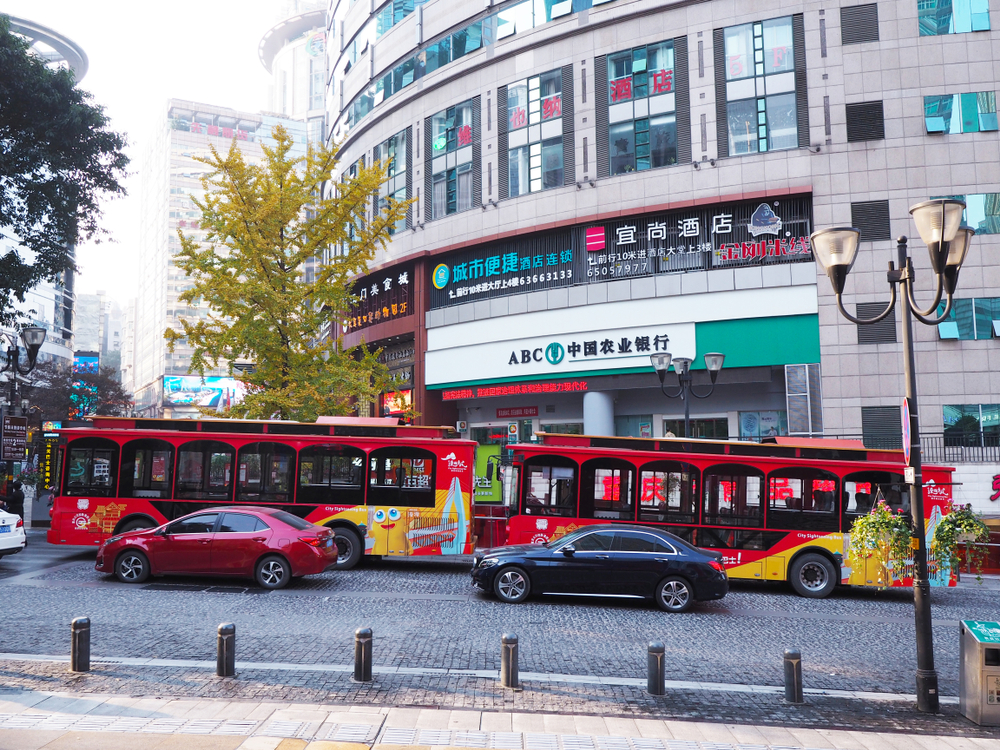
China public transport
In China, things are much more relaxed. Since the country is a lot bigger, journey times are longer. You might not be able to hop around and see all the cities you want to see during just a one or two-week trip. However, if you do choose to travel, the trains are reliable. They’re quite old and conventional, lacking the modern amenities of modern alternatives.
There are, however, new Chinese bullet trains that are helping to speed up transport across the nation. You can also find cheap domestic flights between big cities around China too. Also, the rules for walking around are more relaxed. You won’t get stopped or punished for jay-walking in China. People move more freely and casually around the cities. This helps to provide a more laid-back pace of life.
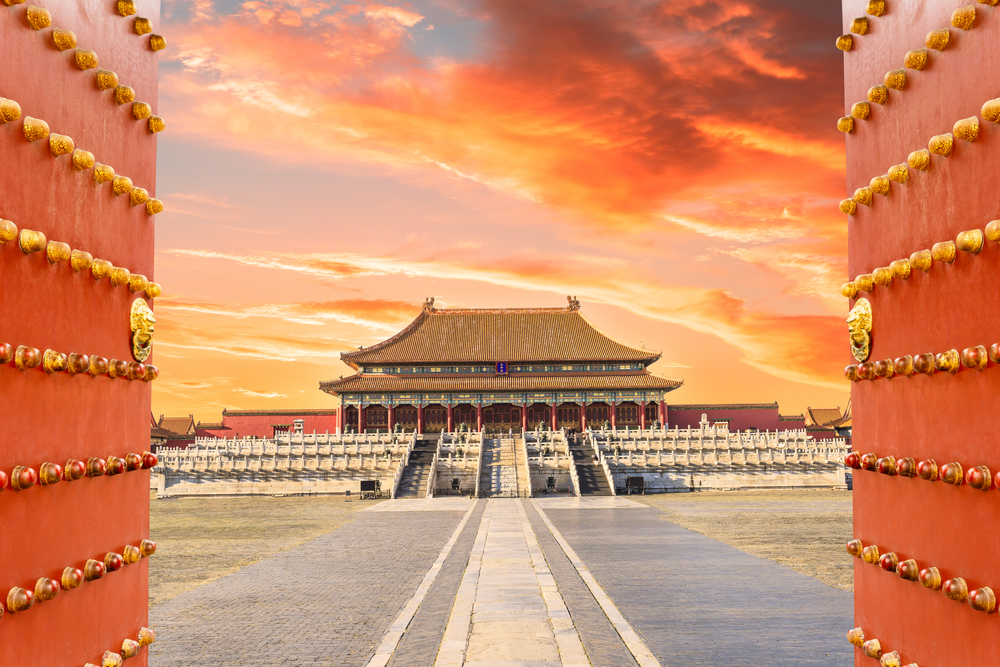
Forbidden City in Beijing, China
What are the most beautiful places in Japan vs China (other than the obvious Beijing or Tokyo)?
China and Japan have unique features and experiences to offer their visitors but both are equally as beautiful a destination as one might expect.
For a small nation, Japan has some strikingly diverse landscapes ranging from golden-sand beaches lined with palm trees to snow-capped mountains that tower high into the sky. If you’re looking to spend your time in a picturesque village that transports you to another era, then Hida-Takayama or “Little Tokyo” as it is lovingly called, is the place for you. Oozing with old-fashioned Japanese charm, this mountainside destination houses a historic district lined with traditional-style wooden buildings. You can walk through the riverside market located on the foothills of the mountainside or relax with some sake in a classic Japanese-style inn. If you’d like to spend time outdoors but away from the hustle and bustle of the city, then head to the rolling forest landscape of Kamakura . Less than an hour’s drive away from Tokyo, Kamakura has everything you need for a quick getaway. You can spend your time there relaxing on sandy beaches, wandering through old wooden homes filled with charm, or taking in all of the centuries-old Buddhist temples and historical shrines and museums scattered around the city. Other not-so-obvious places of interest that are worth exploring in Japan are the lavender fields of Furano, the active volcano in Kagoshima, and the hot springs of Hakone.
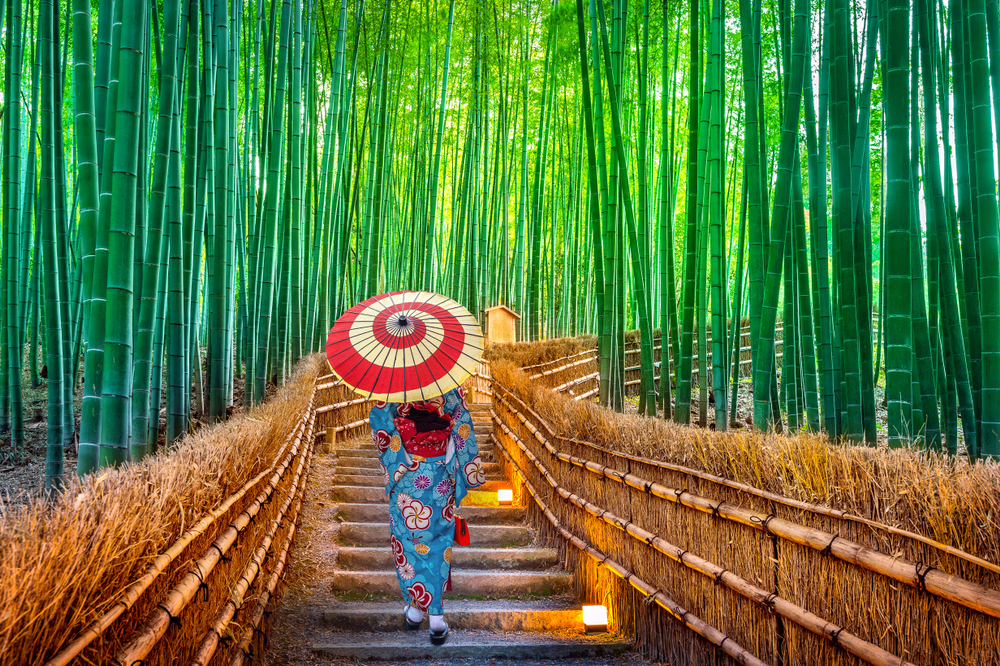
Arashiyama forest
China is about 25 times bigger than Japan, meaning there is much more land to explore. Each corner of the land is different and diverse and offers so much variety for tourists. Zhouzhuang is a beautiful water town that is often considered the “Venice of the East”. The 900-year-old town is filled with pretty waterways and charming stone bridges and let’s not forget historic attractions like Zhang Ting – a sprawling residence dating back to the Ming Dynasty with over 70 rooms and 6 courtyards. Afterward, spend your holidays in the mist-shrouded foothills of the Huangshan Mountain in the ancient Anhui village of Hongcun . You might recognize your surroundings from the famous Hollywood movie, Crouching Tiger , Hidden Dragon . Much of the village is recognized on the list of UNESCO World Heritage Sites; check out some of the finest examples of architecture dating back to the Ming and Qing Dynasty or take in the ornate stone and wood carvings at the Chengzi Hall Museum. Other places of interest in China to keep in mind include the Three Pagodas of Chongsheng Temple in Dali, the breathtaking coastline views of Gulangyu Island, and the idyllic town of Tongli.
Is China safer than Japan or vice versa?
China vs Japan is generally both very safe countries to visit and have never been recognized otherwise such as places like Brazil or Columbia. The chances of a traveler coming across any issues are extremely low and you’ll most likely enjoy your entire vacation without a single incident. Though tourism-related crime is very low in both countries, it is important to note that Japan also has a much lower crime rate in general and is safer overall.
Staying safe while traveling should be your number one priority and both China and Japan have proven to be amazing destinations of choice. While visiting either of these countries you don’t have to worry about your things being stolen, your hotel room being broken into, or anything drastic like being mugged or robbed. Travelers have also shared how safe they feel walking alone in both the daytime and at night in several research studies.

Great Wall of China
Are there more fun things to do in Japan vs China? What are the best attractions in China and Japan?
So, what can you actually do in China vs Japan? The activities and attractions of these two Asian culture countries are very unique and special. China is home to one of the most iconic landmarks in the world: The Great Wall of China. A long, historic, incredible wall, the Great Wall is an amazing place to visit.
There are lots of temples and historic hotspots in China. The country has a lot of appeal for history buffs and culture lovers. You can check out the Forbidden City, Emperor Qinshihuang’s Mausoleum, the Temple of Heaven, and Tiananmen Square. So, what can you actually do in China vs Japan? The activities and attractions of these two countries are very unique and special. China is home to one of the most iconic landmarks in the world: The Great Wall of China. A long, historic, incredible wall, the Great Wall is an amazing place to visit.
You can also explore beautiful natural spaces like Jiuzhai Valley National Park and the Tiger Leaping Gorge. There are also some vibrant inner-city areas like Nanjing Road in Shanghai or Wangfujing in Beijing.
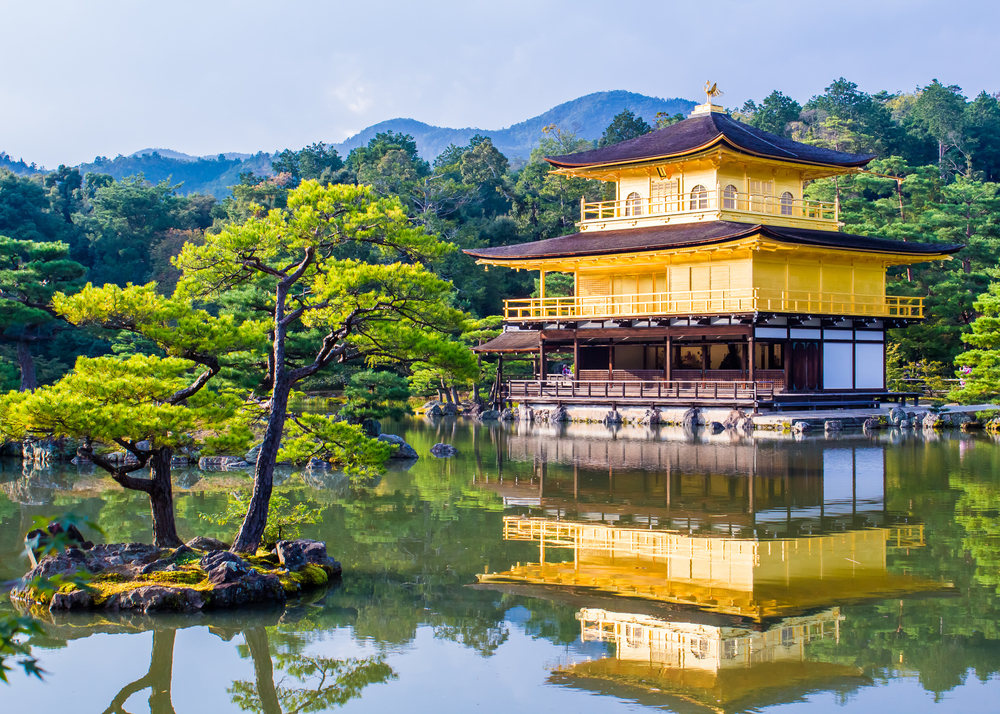
Kinkaku-Ji, Buddhist, Temple In Kyoto
Japan also has a lot of historic and traditional sites. Examples include the Fushimi Inari Taisha Shinto shrine and the Kiyomizu-dera temple. The Senso-ji temple is another popular site and Osaka Castle is a must-visit location.
Japan also has a lot of beautiful natural areas. Arashiyama forest is very famous for its monkeys and bamboo shoots. Travelers can visit Mount Fuji, snapping photos from afar or actually hike up the mountain with their friends.
The big city of Tokyo can almost be considered an attraction too. It’s a city like no other. It has its own Disneyland, entire neighborhoods dedicated to arcade games and anime, theme restaurants, and much more. You can visit old shrines one moment and modern skyscrapers the next.
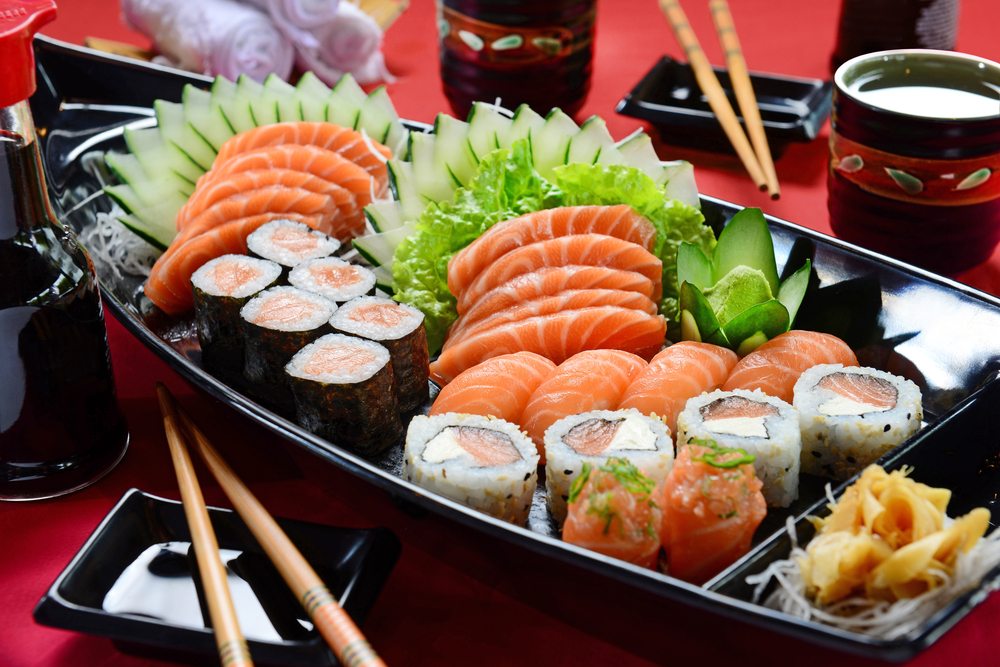
japanese food
What are the traditional foods and drinks you must try when in China vs Japan?
Many people travel to enjoy new foods and drinks. It can be thrilling to visit a different country and enjoy brand new flavors. It’s always exciting to try local delicacies and traditional dishes too. So how do the cuisines and culinary styles of Japan vs China stack up?
Well, we’ve already mentioned that food is cheaper in China. It’s also probably a little less healthy overall. A lot of Chinese dishes are prepared in woks and fried. They often involve a lot of oils and sauces. You’ll find almost everything served with noodles and rice in China.
Many people are familiar with Chinese foods in their own countries, so you can find dishes you know while exploring China. The quality can vary greatly, depending on where you dine. Out in the rural areas, you might discover local restaurants and unique traditional delicacies. The big cities have major fast food chains and restaurants of different styles. It’s not too hard to find amazing food in China.
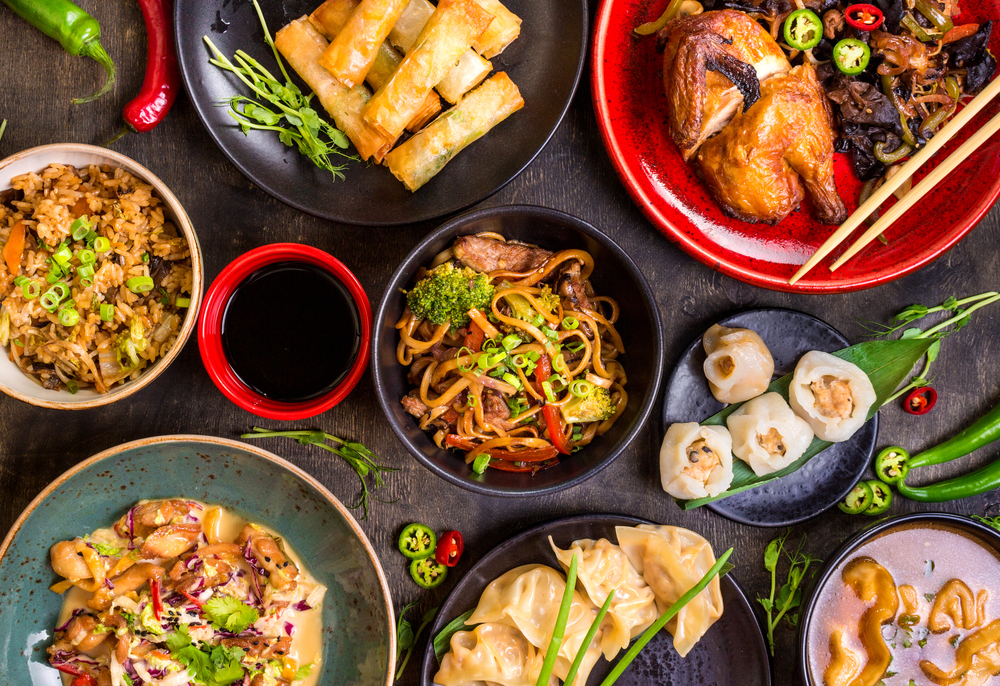
chinese food
The same can be said for Japan as well. Japanese cuisine involves less reliance on sauces and oils. Many foods are actually served raw in Japan. There’s a big focus on seafood. You’ll find lots of sushi and fish dishes in typical Japanese restaurants. Japanese chefs use special flat pans called teppans that allow them to grill food on the outside and keep it raw in the center.
This technique can create some really unique flavors. However, if you’re picky about food and don’t like eating things raw, you might not like Japanese cuisine so much. Fortunately, big cities like Tokyo have all kinds of restaurants offering Italian, French, American, Korean, and other styles of cuisine too.
What should I pack when going to China or Japan?
Other than the usual things you’d pack whilst traveling, there are some specific things to take to China vs Japan that will prove to be useful during your trip. One thing to remember while packing your clothes though is that washing machines are very common in China and Japan but dryers are harder to come by. Unless you’re staying at a place with full laundry facilities, you’ll want to pack clothes that air dry quickly. Also, if you’re going to China, you might want to keep in mind exactly where you’re going in the country. Because China is so large and expansive, you may come across freezing cold snowstorms and hot desert landscapes all in one 10-day-long holiday. There is a drastic difference in sizes compared to the United States and in China or Japan so pack everything you need clothes-wise; a medium in ladies’ clothes is probably a large or extra-large at shopping malls there.
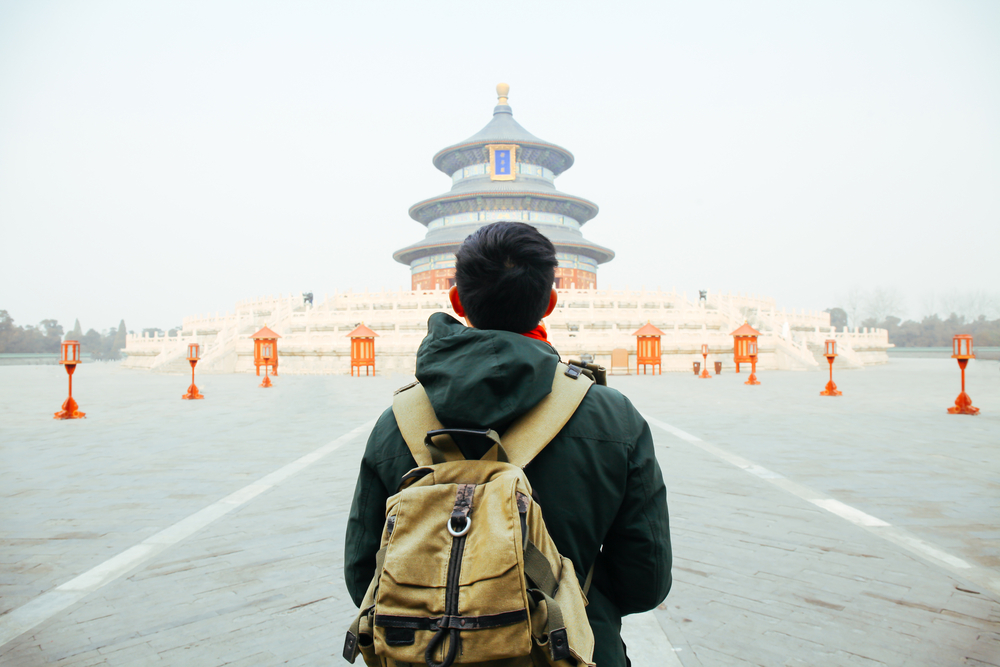
Major metropolises like Beijing or Tokyo are very westernized and fashionable when it comes to what you’d feel comfortable wearing in public. Though you will likely not be questioned no matter what you wear throughout the country, you may want to keep in mind that many distant villages are more modest in their clothing. This is especially true if you plan on visiting any religious historic sites or temples during your visit so you may want to make sure you have a long skirt wrap, pants, or a shawl to cover any bare shoulders while there. You may also want to pack warm pajamas since central heat won’t be found in many places.
Other general things to pack when visiting Japan vs China include a convertible charger, personal toiletries, and any medicines you need on a regular basis.
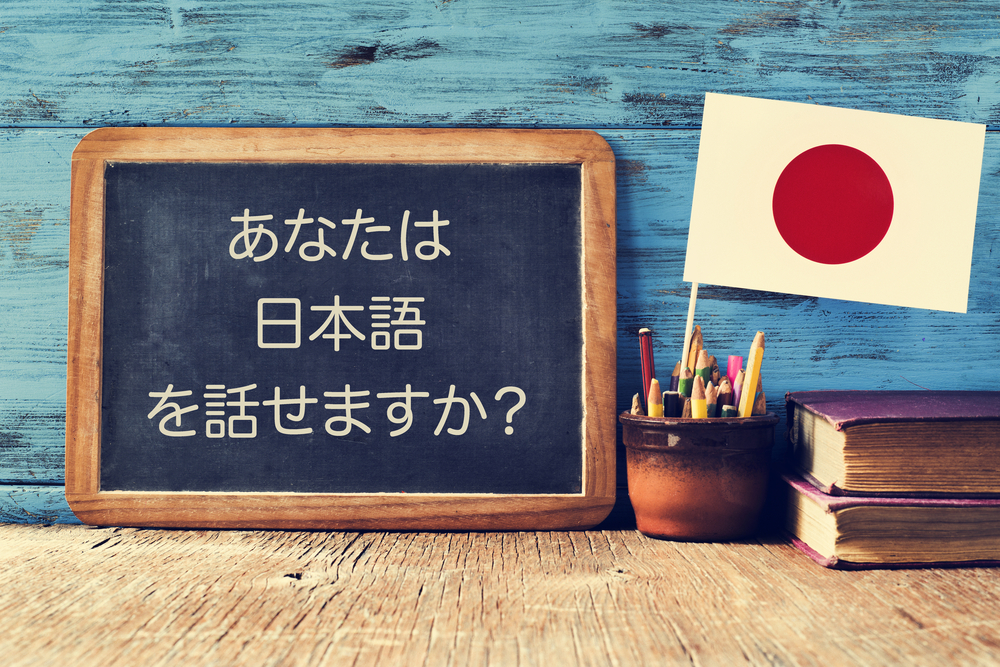
What languages will I come across in Japan vs China?
When in major cities, you will most likely be able to communicate with store vendors and others that you come across in English. Both countries have a strong focus on education and you’ll find that most people can speak English perfectly. That being said, it’s best to remember that you are the foreigner on their land and that you should respect whatever language locals choose to communicate in. In China, the official language is Mandarin and more than 70% of the population speak it. There are other major dialects you may come across like Hunanese, Cantonese, the Hakka dialect, or the Wu dialect.
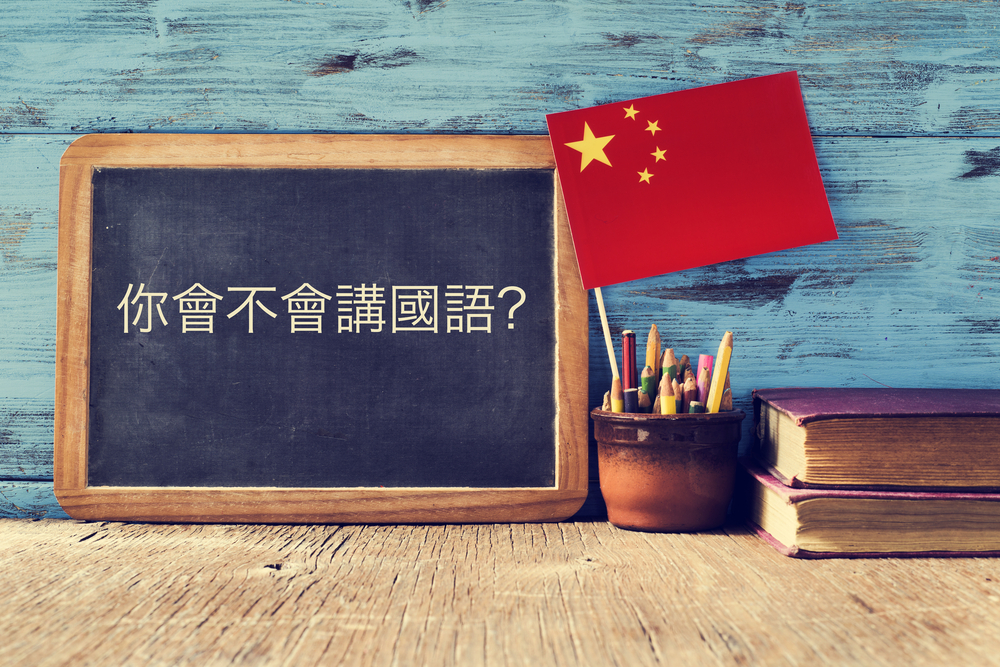
Japanese is the widely spoken language throughout Japan though there are many different dialects throughout; the dialect spoken in Tokyo is considered standard Japanese. You may also come across 14 different Ryukyuan languages spoken in Okinawa and neighboring Ryukyu islands.
Keep in mind that internet usage is restricted in both countries and that you may want to download a translator app before your travels to help you communicate what you need. You can use one of these many language learning apps that have been tried and tested by fellow travelers.
What unique customs should I be aware of while in China vs Japan?
There are certain Japanese vs Chinese customs that might shock foreigners but are considered the norm in that part of the world. It’s always best to know what you’re walking into before deciding which country you want to travel to.
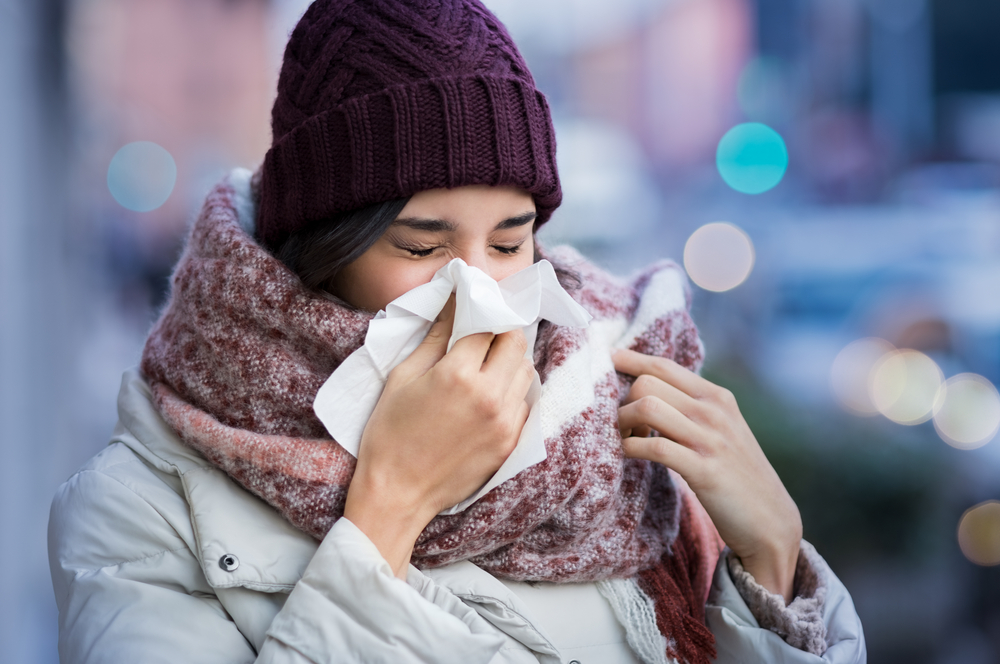
Japan it’s considered rude to blow your nose in public
For example, in Japan it’s considered rude to blow your nose in public – so if you’re usually a little sniffly, you may want to opt for China instead. You may also notice that you don’t come across the number 4 a lot. Many hotels don’t have a room number 4 or restaurants don’t have a table number 4. This is because many Japanese are highly superstitious and believe that the number four is bad luck – similar to how we view the number 13 in the United States. Speaking of restaurants, the Japanese believe that it is preposterous to pour your own drink – you just have to hope that the person or people you’re with (or the waiter or waitress) notice that your glass is empty and pour it for you.
There are some Chinese customs you’re sure to come across during your travels that will surprise you as well. For example, don’t be appalled when other diners let out a huge burp after a hearty meal – it’s considered a sign of gratitude and appreciation for the food that was served. While in a restaurant in China, know that it is inappropriate to place your chopsticks upright in a bowl of rice; similarly, don’t wave them around when making hand gestures. While tipping is common in major cities, it is considered impolite and offensive in other parts of the country.
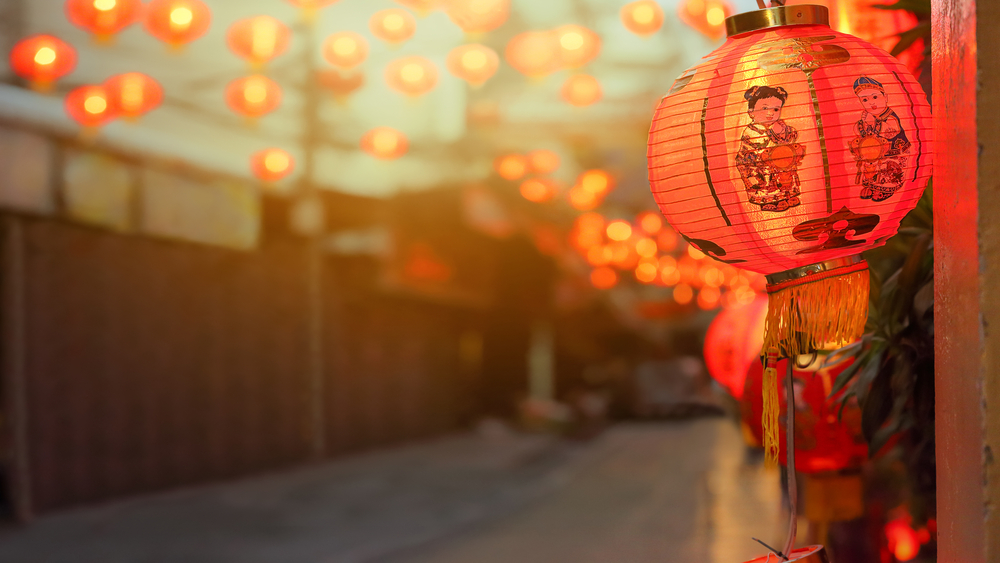
Which Japanese festivals should you attend? Which Chinese festivals are the most fun?
China and Japan are full of so much culture and tradition and being a part of it is an experience that visitors cherish for the rest of their lives. If none of the other aspects are deal breakers when choosing either one or the other, you may want to pick whether to visit China or Japan based on what festivities are occurring at the time.
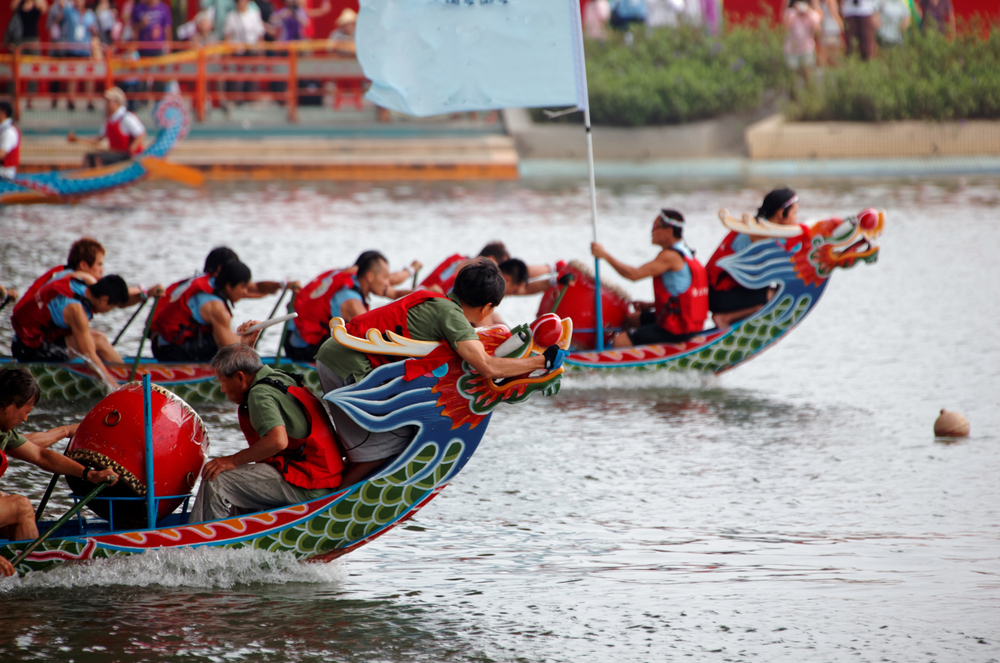
Dragon Boat Festival
In Japan you’ll want to attend the Gion Matsuri in July; the festival is considered the mother of all Japanese festivals and lasts the entire month. You’ll see float processions, parades in costume, and much more. Another Japanese festival you won’t want to miss is Yuki Matsuri, which is also known as the Sapporo Snow Festival and happens for an entire week in either January or February. There’s tons of cultural shows and concerts and an intricate snow and ice sculpture competition that attracts over two million visitors each year.
Whilst in China it’s the annual Chinese New Year celebrations that you’re not going to want to miss. It lasts around 15 days and has many activities like detailed fireworks displays, dragon dances, dumpling workshops and stands, and so much more. The Lantern Festival is traditionally held on the last day of the New Year and is something you’re going to want to schedule your travel decisions around.
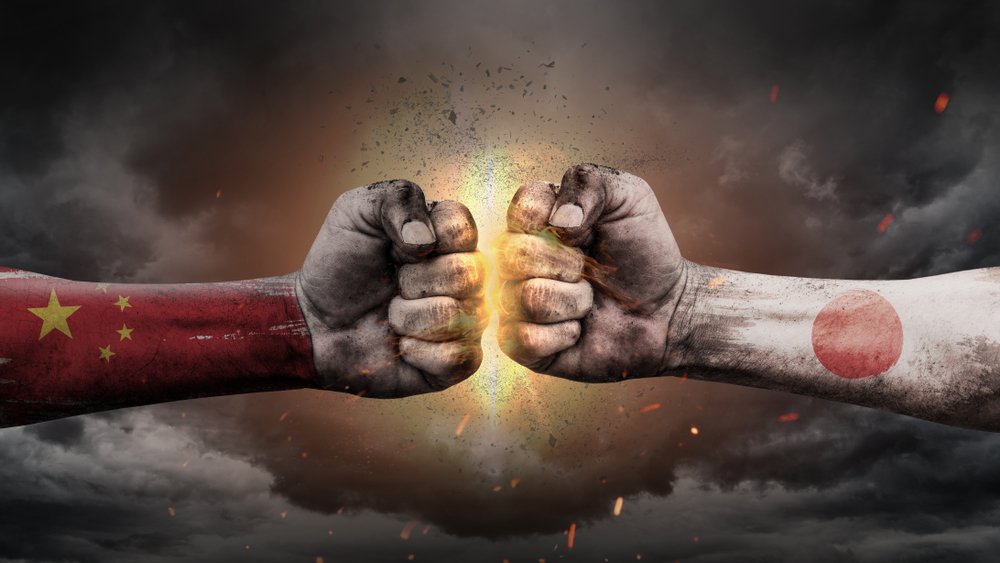
Final Verdict of China vs Japan – Is China or Japan the better country to visit?
Ultimately, both Japan vs China are amazing vacation destinations and travel sites . The right choice for you depends on your personal preferences and tastes. Your budget is also another big factor to consider. If you want to get the best value from your trip and make every dollar count, China is the best choice. Food, accommodation, travel, and activities are all cheaper in China.
China also has some truly iconic landmarks and monuments like its Great Wall. However, Japan has the thrilling metropolis of Tokyo and dozens of ancient temples too. The quality of life is also better overall in Japan. Many Westerners enjoy the high standards of public transport and dining in places like Tokyo and Kyoto.
China has the advantage of its size and weather. You can visit at almost any time of the year and have a terrific time. Japan is also enjoyable throughout the year, but tourists will need to cope with cooler weather and snow in winter. In the end, the choice is yours. Whichever country you choose, you can make a lot of happy memories there.
If you like this and you have some suggestions and advice on posts about Japan vs China let us comment below. 🙏
Short FAQ: Japan vs. China – Choosing the Best Travel Destination
- Japan or China – Which is a better travel destination?
Both Japan and China offer unique experiences, catering to different preferences. Your choice depends on what you’re seeking in a travel adventure.
- What makes Japan a great travel destination?
Japan boasts a rich cultural heritage, stunning landscapes, advanced technology, and a blend of old and new. From serene temples to bustling city life, it’s a perfect mix of tradition and modernity.
- What does China offer as a travel destination?
China is a vast country with diverse cultures, historical sites like the Great Wall and Terracotta Army, delicious cuisine, and picturesque landscapes, including the Yangtze River and the karst mountains of Guilin.
- Which country is more culturally immersive?
Both Japan and China offer unique cultural experiences, but China’s vastness lends itself to diverse cultural encounters, while Japan’s smaller size allows for a deeper dive into specific aspects of its culture.
- What are the must-see attractions in Japan?
Don’t miss Kyoto’s temples, Tokyo’s neon-lit streets, Mount Fuji’s iconic beauty, and Hiroshima’s Peace Memorial Park for historical significance.
- What are the iconic attractions in China?
The Great Wall, Forbidden City, Terracotta Army, Li River, and the vibrant city of Shanghai are some of China’s top attractions.
- Is safety a concern in either country?
Both Japan and China are generally safe for travelers. However, travelers should still exercise common sense and be aware of local customs and regulations.
- Which country is more suitable for food enthusiasts?
Both countries have rich culinary traditions. Japan is known for sushi, ramen, and delicate flavors, while China offers a vast array of regional cuisines, including Sichuan, Cantonese, and Peking duck.
- How accessible are these destinations for English speakers?
In major tourist areas, you’ll find English signage and some locals who speak English in both Japan and China. Learning a few basic phrases can enhance your experience in either country.
- What’s the best time to visit Japan and China?
Spring (March to May) and autumn (September to November) are generally pleasant times to visit both countries, with milder weather and colorful scenery.
- Can I experience traditional culture in modern settings?
Absolutely. Japan’s ryokans and tea ceremonies and China’s preserved ancient towns like Pingyao offer authentic cultural experiences amidst modern surroundings.
- How do transportation options compare between the two countries?
Both countries have efficient public transportation systems, including high-speed trains. Japan’s rail network is known for punctuality, while China’s extensive rail system connects major cities.
- Which destination offers more natural beauty?
Japan boasts cherry blossoms, hot springs, and lush gardens, while China’s diverse landscapes encompass deserts, mountains, and rivers.
- Are there hidden gems in both countries that are less touristy?
Yes, for example, Japan’s Tohoku region and China’s Yunnan province offer off-the-beaten-path experiences with stunning landscapes and authentic culture.
- What’s the overall budget range for trips to Japan and China?
Costs vary based on factors like travel style , duration, and location. Japan can be slightly more expensive due to its higher cost of living.
Remember, the “best” destination depends on your interests, preferences, and the experiences you seek. Both Japan and China offer remarkable journeys; your choice should be based on what resonates most with you!
And we suggest you read a very interesting comparison between two rival countries: Turkey vs. Greece: Which is best to travel?
Interesting infographic about Japan vs China:

Cancel reply
The Ministry of Foreign Affairs website uses JavaScript. Please turn on "JavaScript" and use it.

The JAPAN eVISA system (electronic visa)
Foreign nationals/people who wish to travel to Japan for tourism for a short-term period can apply for a visa online and receive an electronic visa (eVISA) through the JAPAN eVISA system. As of April 1, 2024, the JAPAN eVISA system is available for nationals/people residing in the following countries/regions.
Eligibility
- (1) China Nationals of China, who reside in China
- (2) Viet Nam Nationals of Viet Nam, who reside in Viet Nam and participate in a packaged tour organized by designated travel agencies
- (3) Hong Kong, India, Indonesia, Macau, Mongolia and the Republic of Korea All foreign nationals/people residing in Hong Kong, India, Indonesia, Macau, Mongolia and the Republic of Korea (except jurisdiction over the Consulate General of Japan in Jeju), except those who are exempt from short-term visa
- (1) JAPAN eVISA is available only to those who travel to Japan by plane.
- (2) During the application process, the applicant may be requested to appear in person at the Japanese overseas establishment with jurisdiction over the place of the applicant’s residence for an interview.
- (3) Only ordinary passport holder is eligible to apply through JAPAN eVISA website.
Types of visa
Single-entry short-term stay visa for the purpose of Tourism (for a period of up to 90 days) (Note). Electronic visas will be issued to those who applied through JAPAN eVISA website.
(Note: For nationals of China residing in China, electronic visas with a period of stay "15 days" or "30 days" will be issued. For nationals of Viet Nam residing in Viet Nam, the period of stay of electronic visas will be "15 days".) (Travelers with eVISA are required to display “Visa issuance notice” at the airport in the internet environment. PDF data, screenshot and printed copy will not be accepted.) If you wish to visit Japan for other purposes or for a long-term stay, please submit your application to the Japanese Embassy, Consulate General or Consular office with jurisdiction over your place of residence. (In some countries, applications must be made through travel agencies accredited by Japanese overseas establishment.) (For Taiwan, Taipei / Kaohsiung offices of Japan-Taiwan Exchange Association) In this case, you will have a visa sticker on your passport.
JAPAN eVISA website

- Please beware of fraud websites looking alike the JAPAN eVISA website.
- If your application is incomplete, we will cancel it without processing. Once cancelled, you are supposed to reapply (for your visa). Entering incorrect information and/or uploading incomplete/wrong documents could lead to a delay in examination or cancellation of your eVISA application, which may affect your travel plans.
How to display “Visa issuance notice”
Frequently asked questions about japan evisa.
- FAQ about JAPAN eVISA
Contact information for inquiries
Japan Visa Information Hotline: [email protected] (Available language: English) (Note1) Please mention your nationality or citizenship and place of your residence in your email. (Note2) This e-mail address is only for inquiries about JAPAN eVISA application procedures. For general inquiries, please contact the Japanese overseas establishment with jurisdiction over your place of residence.
- Website of Japanese Embassies and Consulates
- Consulates in Japan
Chinese Embassy in Japan

Consular Office of Chinese Embassy in Japan
Location: 4-6-6 Higashigotanda, Shinagawa Ward, Tokyo Tel: +81-03-6450-2196 Email: [email protected] Office Hours: 09:00 - 12:00, Monday-Friday (except public holidays)
Notice on Chinese Visa Application Service Center (CVASC)
However, for those who hold Diplomatic, Service or Official passports, or who want to apply for Hong Kong/Macau visa/entry permit, they should go to the embassy like before to submit the application directly.
Besides, the CVASC also provides document authentication at a certain cost.
Basic Information of the CVASC in Tokyo
Notice: If the applicant wants to use the express or rush service, the application should be submitted to the CVASV before 11:30am.
Visa Exemption
Consular districts of the embassy/consulate, china visa fees (in japanese yen).
Japanese
Citizens of Other Countries
Japan Profile
Capital : Tokyo Currency : Japanese Yen.
Language : Official language is Japanese. Service industry staff such as those working in hotels, restaurants, and stations are often able to speak some basic English. However, the general population rarely uses English. Population : 126 million (as of March 2021), with a population density that is the second highest in the world, at 7.5 times the average global density. The aging of the Japanese society is a serious issue, and Japan ranks first in the world with a life expectancy of 83.4 years per capita. Geography :
- Japan is an East Asian country located northeast of mainland China, east of the Korean Peninsula, and south of Siberia.
- Consisting of thousands of islands that form an arc-shaped chain, it is completely surrounded by the sea and does not have any land connection with any other country.
- Earthquakes and volcanic eruptions happen frequently in this country as it is located at the intersection of four tectonic plates. Among all the earthquakes in the world, approximately 20% of them occur in Japan's vicinity.
- The time zone in Japan is UTC+9.
Climatic feature : Japan features a temperate maritime climate with distinct difference in temperature between the four seasons. March to April when the cherry blossoms, and October to November when the leaves turn to red, is the best time to take a Japan tour . Transportation :
1. It is convenient to reach Japan from any corner of the world. Currently, Japan has international flights to over 150 cities worldwide. A direct flight from Japan to China takes only 2 - 4 hours. Therefore a Japan and China tour is a perfect choice for those who want to explore both countries.
- Application
- Requirements
Japan Online Visa for Citizens of China
Japan is a popular destination for both tourists and business travelers alike . In order to travel to Japan, Chinese citizens are required to apply for a Japan visa at an embassy or consulate .
The most common visa for Chinese nationals is the temporary visitor visa which grants permission to stay in Japan for either 15 or 30 days. With the Japan tourist visa , visitors can take part in tourism, visits with family and friends, or short-term business.
The New Electronic Visa for Japan for Chinese Tourists
Starting in April 2020, Chinese tourists will be able to apply for the new Japanese eVisa for single entry trips to Japan from China .
The application for the Japan eVisa for Chinese citizens requires a valid Chinese passport and other supporting documents. The eVisa will allow the traveler to apply online while the applicant is still in China. Since the process can be done entirely online, applicants will no longer have to visit the Japanese Embassy to obtain a Japan visa.
The embassy said it expects to officially open online applications for single visas to Chinese tourists after June this year. More info here .
Japan tourist eVisa requirements from China
The applicant will need to submit personal details which appear in their passport . The application then asks for trip details, including the purpose of travel, dates of travel, port of entry and the airline or ship that the applicant is traveling with. Finally, the traveler must provide details of where they will be staying for the duration of their trip to Japan.
As a legal requirement , the applicant will have to report any past criminal activity or immigration violations.
Japan Online Visa Requirements from China
It is important to review the list of visa requirements for the Japan tourist visa from China visa application. The Japanese visa requirements from China are:
- A valid Chinese passport , signed, with 2 blank visa pages
- The completed visa application form
- A recent passport-sized photo with a white background, which should be pasted on the application form
- Proof of sufficient funds for the trip
- A list of travel plans while in Japan including dates, locations, contact person, and accommodation
If traveling to Japan on business or to visit friends and family , the application should include a formal letter from the person in Japan who invited the applicant.
Applying for a Japan e-Visa from China
Before the eVisa process is available , applicants must work with an approved travel agency. The application form is available online as well as in person at the Embassy in Beijing, or at many travel agencies.
Once the eVisa becomes available , individuals will be able to easily and quickly submit their Japanese travel visa online application form themselves.
Other Types of Japan Visas for Chinese Passport Holders
There are multiple different types of Japan visas for Chinese citizens . The applicant is responsible for applying for the correct visa based on their personal situation.
Short-term Japan visas for Chinese nationals
- Group Tourist Visa - this Japan tourist visa for people from China is meant for group tours. One of many approved Chinese travel agencies will handle the application process. This Japan visa allows a stay of up to 15 days and requires the traveler to remain with the group while in Japan.
- Business Visa - to qualify, travelers must hold a managerial role at a corporation which falls under certain criteria.
- Transit Visa - Chinese passport holders will need to apply for a Transit Visa even if Japan is just a stopover on their way to another destination.
Long-term visas for Chinese nationals
In special cases, the Japanese government may grant a long-term visa for Chinese citizens:
- The Working Visa and Highly Skilled Professional Visa are granted to individuals who have a job offer in Japan or someone who can submit a certificate of eligibility on their behalf.
- The General Visa is meant for individuals who will be engaging in cultural activities. The applicant must have a certificate of eligibility issued by a regional immigration authority.
- A Specified Visa is granted to the Chinese spouses and children of Japanese nationals: Chinese nationals must provide documentation of the Chinese Family. Register and a Temporary Residence Permit or Residence Certificate.
- Diplomatic and Official Visas are intended for individuals who are in Japan for diplomatic missions.

China Travel Restrictions & Travel Advisory (Updated March 7, 2024)
Updates March 7th, 2024 : Travelers from the following countries could enjoy visa-free entry to China for tourism, business, transit, or visiting friends and relatives.
- From December 1st, 2023, to November 30th, 2024: France, Germany, Italy, Netherlands, and Spain.
- From March 14th to November 30th, 2024: Austria, Belgium, Hungary, Ireland, Luxembourg, and Switzerland.
- Singapore, Brunei
- Malaysia (from December 1st, 2023 to November 30th, 2024)
If you want to arrange a private tour, even tentatively, simply contact us .
Content Preview
- What Ways to Enter China
- Do I Still Need a PCR Test to Enter China
- Hong Kong/Macau Travel Restriction
International Flights to China
What to expect when traveling in china, best times to travel to china, 8 ways to enter china: all open now.
Since China has fully permitted visa applications, there are now several ways to enter the country.
If you still hold a valid Chinese visa (any type including a tourist visa, 10-year visa, etc.), you can use it to enter China.
If you don't have a Chinese visa or your visa has expired, you can apply for a new one. All visas can now be applied for, including tourist visas, business visas, work visas, and so on. (International visitors can apply for a tourist visa to the Chinese Mainland in Hong Kong.)
For the documents required for a visa application, you can refer to the information given by a Chinese embassy/consulate . Please submit your application at least two months in advance.
To apply for a tourist visa (L visa), you will be asked to provide an invitation letter issued by a Chinese travel agency or individual or round-trip air tickets and hotel bookings.
When booking a private tour with us, we can provide you with an invitation letter, which is one more thing we do to make your travel more convenient, giving you more flexibility with your air tickets and hotel bookings.
Now it is very easy to apply for a visa . You can easily apply by yourself without an intermediary. The following is how one of our clients successfully applied for a Chinese tourist visa:
- First, fill out the form at the China Online Visa Application website ;
- Second, make an appointment on this website to submit your visa materials on Appointment for Visa Application Submission website ;
- Third, take the required documents to the embassy to submit;
- Finally, you will get a return receipt if your documents are qualified.
Usually, you will get your visa after 7 working days. The application fee is about USD185 for US citizens.
Q: What if my passport expires but my visa doesn't?
A: You can travel to China on the expired passport containing valid Chinese visa in combination with the new passport, provided that the identity information (name, date of birth, gender, nationality) on both passport identical.
If there is a change to any of the above details, you must apply for a new visa.
2. 144-Hour Visa-Free Transit Policy
If you do not apply for a Chinese visa, you may still have the opportunity to visit these areas of China visa free: the Shanghai area (including Suzhou, Hangzhou, etc.), the Beijing area (with Tianjin and Hebei), the Guangzhou area (Shenzhen, Zhuhai, etc.), and more. Take advantage of the 6-day visa-free entitlements.
Find out if you could use the 144-hour visa-free transit policy with our information on China's 144-hour Visa-Free Policy (Eligible Entry/Exit Ports, Applicable Countries, Documents to be Prepared...)
You can also obtain entry and exit control policies through the 24-hour hotline of the National Immigration Administration:
- Beijing: 0086 (+86)-10-12367
- Shanghai: 0086 (+86)-21-12367
- Guangzhou: 0086 (+86)-20-12367
Quick Test: Will My Route Qualify for China 72/144-Hour Visa-Free Transit?
1. I will depart from (only applies to direct or connected flight):
2. I will arrive in China at [city], [airport / railway station / port].
3. My arrival date is...
4. I will leave for [country/region] from China (the bounding destination on the air ticket):
5. My departure date is...
6. My nationality is...
8. I have Chinese visa refusal stamps in my passport.
You qualify to enjoy China's 72-hour visa-free policy.
You qualify to enjoy China's 144-hour visa-free policy.
You don't qualify to enjoy China's 72-hour or 144-hour visa-free policy.
Reason you don't qualify:
- You must be in transit to a third country or region.
- You must leave the city area (prefecture or municipality) after the 72/144 hours (the 72/144-hour limit is calculated starting from 00:00 on the day after arrival, i.e. 24:00 on the arrival date).
- Your passport must be valid for more than 3 months at the time of entry into China.
- Your passport nationality is not eligible for the 72/144-hour visa exemption program.
- You have Chinese visa refusal stamps in your passport.
3. Port Visas (Landing Visas)
If you don't have time to get a visa, or if you find it cumbersome to apply for a tourist visa, you could consider traveling to China through a port visa.
Port visas can be applied for a group at least including 2 people. You need to enter the country within 15 days after you get your entry permit. The port visa allows a stay period of 1 to 2 months.
Applicable ports include Beijing, Shanghai, Hangzhou, Guangzhou, Xiamen, Guilin, Xi'an, Chengdu, etc.
Note: Tourists from America are not granted a port visa in Shanghai.
Book your China trip with us and we can help you apply for a port visa.
4. Visa Exemption for ASEAN Tour Groups to Guilin
In addition, tour groups from ASEAN member countries, including Malaysia, Thailand, Indonesia, Vietnam, Cambodia, Laos, Singapore, Myanmar, Brunei, and the Philippines, can visit Guilin for 144 hours without visas as long as they meet the visa-free transit policy requirements.
5. Shanghai Visa-Free Policy for Cruise Groups
Shanghai has a 15-day visa-free policy for foreign tourist groups entering China via a cruise. You must arrive and depart on the same cruise and be received by a Chinese travel agent at the Shanghai Cruise Terminal (or Wusong Passenger Center).
6. Hainan Visa-Free Access
No visa is required for staying on Hainan Island for up to 30 days for ordinary passport holders from 59 countries. Groups and individual tourists must book a tour through an accredited travel agency.
Find out whether you qualify for the policy here .
7. Visa Exemption for the Pearl River Delta Area
International travelers from Hong Kong or Macau are able to visit the Pearl River Delta area (Guangzhou, Shenzhen, Zhuhai, etc.) visa-free as long as they go with a registered tour provider, such as us.
8. APEC Cards
If you hold a valid APEC business travel card, you can simply enter China with the card without applying for a visa.
Travelers who hold a valid APEC business travel card can stay in China for up to 60 days.
- 4-Day Beijing Private Tour - Essence of Beijing
- 11-Day Beijing–Xi'an–Guilin–Shanghai Tour - Classic Wonders
- 13-Day Beijing, Xi'an, Chengdu, Shanghai Educational Family Vacation
Do I Still Need a PCR Test or Antigen Self-Test to Enter China
No. Starting from August 30, all travelers entering China will no longer need to undergo any COVID-19 testing. You do not need to submit any test results for COVID-19 before departure.
- 8-Day Beijing–Xi'an–Shanghai Private Tour - China Golden Triangle
- 13-Day Riches of China - Beijing – Xi'an – Guilin/Yangshuo – Hangzhou - Suzhou – Shanghai
Hong Kong / Macau Travel Restriction
Hong kong entry requirements.
Travelers from any region bound for Hong Kong will no longer need to take pre-flight COVID-19 tests (no PCR test, no RAT test) from April 1.
There is also no need for any tests when traveling from Hong Kong to the Chinese Mainland. Hong Kong could be a good gateway for your China trip. See suggestions on China Itineraries from Hong Kong (from 1 Week to 3 Weeks).
Direct high-speed trains from Guangzhou and Shenzhen to Hong Kong are available now. In preparation for the Canton Fair, it is expected that direct high-speed ferries will be launched from Guangzhou Pazhou Port to Hong Kong's airport in mid-April.
- 10 Top China Tours from Hong Kong
Macau Entry Requirement
From August 30, travelers from any region bound for Macau will no longer need to take pre-flight COVID-19 tests (no PCR test, no RAT test).
There is also no need for any tests when traveling from Macau to the Chinese Mainland.
Inbound and outbound international flights in the week beginning March 6th rose by more than 350% compared with a year earlier, to nearly 2,500 flights, according to Chinese flight tracking data from APP Flight Master.
At present, there are one or two direct flights a week from New York to Shanghai, Los Angeles to Beijing, Seattle to Shanghai, London to Guangzhou, etc.
There are also many flight options with stopovers that are more frequent and affordable. Testing at transit airports is now not required!
The Coronavirus outbreak in China has subsided. China looks like it did in 2019 again. No special measures (like PCR tests or health codes) are required when traveling around China. All attractions are open as normal.
Wearing a mask is not mandatory when traveling. In hotels, masks are off for the most part. But in some crowded places, such as airports or subway stations, many people still wear masks.
Weather-wise, the best times to visit China are spring (April–May) and autumn (September–October), when most of the popular places have their most tourism-friendly weather, except for the "golden weeks" — the first week of May and of October — when most attractions are flooded with Chinese tourists.
If you are looking for smaller crowds, favorable prices, and still good weather, you should consider March and April or September.
Tourism in cultural and historical destinations like Beijing, Shanghai, and Xi'an is hardly affected by weather conditions. They are suitable to be visited all year round.
- 11-Day Family Happiness - Beijing–Xi'an–Guilin/Yangshuo-Shanghai
- 13-Day Private Tour: Beijing – Xi'an – Chengdu –Yangtze Cruise – Shanghai - China Essence and Panda Tour
- More Chengdu and Panda tours
Discover real reviews of Highlights Travel Family 's best-rated service across trusted platforms.
Tour China with Us
We've been building our team for over 20 years. Even over the past three years we have continued, serving over 10,000 expats with China tours and getting a lot of praise (see TripAdvisor ).
We are based in China and can show you the characteristics and charm of China from a unique perspective. Just contact us to create your China trip .
Our consultants will listen to and answer your inquiries carefully and prepare the best plan for you.
- 8-Day Beijing–Xi'an–Shanghai Highlights Tour — the classic Golden Triangle
- 11-Day Beijing–Xi'an–Guilin–Shanghai — our top itinerary for families
- 2-Week Beijing – Xi'an – Chengdu – Yangtze Cruise – Shanghai Tour — the best choice for panda fans
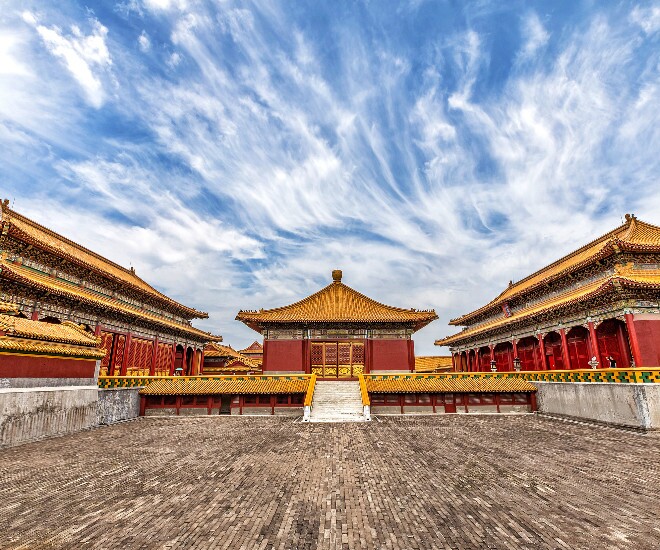
- 11-Day Family Happiness
- 9-Day Beyond the Golden Triangle
- Best China Tours 2024/2025: Top Tours for First & Return Trips
- 12-day Panda Keeper and Classic Wonders
- 13-Day A Broad Taste of China
- 13-Day Beijing–Xi'an–Dunhuang–Urumqi–Shanghai Tour
- 14-Day China Natural Wonders Discovery
- 14-Day Classic China Photo Tour
- 2-Week Riches of China
- 3-Week Must-See Places China Tour Including Holy Tibet
- How to Plan Your First Trip to China 2024/2025 — 7 Easy Steps
- Best (& Worst) Times to Visit China, Travel Tips (2024/2025)
- 15 Best Places to Visit in China (2024)
- The 15 Most Beautiful Places in China (#7 Will Impress You)
- One Week in China - 4 Time-Smart Itineraries
- How to Plan a 10-Day Itinerary in China (Best 5 Options)
- Top 4 China Itinerary Options in 12 Days (for First Timers) 2024/2025
- 2-Week China Itineraries: Where to Go & Routes (2024)
- 17-Day China Itineraries: 4 Unique Options
- How to Spend 19 Days in China in 2024/2025 (Top 5 Options and Costs)
- How to Plan a 3-Week Itinerary in China: Best 3 Options (2024)
- China Itineraries from Hong Kong for 1 Week to 3 Weeks
- China Weather in January 2024: Enjoy Less-Crowded Traveling
- China Weather in February 2024: Places to Go, Costs, and Crowds
- China Weather in March 2024: Destinations, Crowds, and Costs
- China Weather in April 2024: Where to Go (Smart Pre-Season Pick)
- China Weather in May 2024: Where to Go, Crowds, and Costs
- China Weather in June 2024: How to Benefit from the Rainy Season
- China Weather in July 2024: How to Avoid Heat and Crowds
- China Weather in August: Tips for Family Travel
- China Weather in September: a Quieter Month in the Peak Season
- China Weather in October: Where to Go, Crowds, and Costs
- China Weather in November: Places to Go, Costs, and Crowds
- China Weather in December: Places to Go, Costs, and Crowds
Get Inspired with Some Popular Itineraries
More travel ideas and inspiration, sign up to our newsletter.
Be the first to receive exciting updates, exclusive promotions, and valuable travel tips from our team of experts.
Why China Highlights
Where can we take you today.
- Southeast Asia
- Japan, South Korea
- India, Nepal, Bhutan, and Sri lanka
- Central Asia
- Middle East
- African Safari

- Travel Agents
- Loyalty & Referral Program
- Privacy Policy

Address: Building 6, Chuangyi Business Park, 70 Qilidian Road, Guilin, Guangxi, 541004, China


- Bucket List Trip
- Family Trip
- Cherry Blossom Trip
- Summer Trip
- Winter Trip
- Japan-South Korea Trip
- Japan-China Trip
- Japan-Thailand Trip
- 2 Weeks for Family
- 2 Weeks for Couple
- Top Asia Tours
- Southeast Asia
- India, Nepal, Sri Lanka, Bhutan
- Caucasus and Central Asia
- Indonesia(Bali)
- 1 Week in Japan
- 1 Week in Vietnam
- 8 Days in China
- 10 Days in Japan
- 10 Days in Vietnam
- 10 Days in China
- 12 Days in Japan
- 12 Days in China
- Japan and South Korea
- Thailand, Cambodia, Vietnam
- China, Vietnam
- China, Nepal, India
- China, Laos, Thailand

16-Day Japan and China Discovery Tour
Discover world-famous landmarks such as the Great Wall of China and historical cities such as Xi’an and Kyoto, and witness the vibrant cultures of East Asia, as you experience the best of Japan and China on a 16-day leisurely tour (easily adapted to be a 2-week or 3-week tour). It covers iconic cities like Tokyo, Hakone, Kyoto, Nara, Beijing, Xi’an, and Shanghai. With our carefully-designed itinerary and expert guides, this adventure tour is sure to create unforgettable memories and a comprehensive view of the Far East. Come with us and have the journey of a lifetime!
- Best For: First-timers, Families
- Departure date: up to you
- Sample Price: from US$ 6,499 each (2 per room); 4-6 persons, save US$ 400 each!
Journey Route
This is an ideal tour for first-time visitors and families to both Japan and China. Sign up for your favorite part of the tour or simply treat the whole tour as inspiration, designing each element specially for you.
Enter into the history of China and Japan by visiting UNESCO sites and discovering their hidden corners.
Taste the exotic savory flavors of east asia., make your own terracotta warriors after finding out the secrets of the terracotta army., delight in the captivating panorama of tokyo city from the heights of the renowned sky tree tower ., experience the breathtaking scenery of hakone from multiple perspectives., listen to the echoes of history while cycling or walking on the ancient xi'an city wall ., take a leisurely stroll through nara park and interact with over 1,200 tame deer., indulge in ultimate relaxation and serenity at a traditional japanese ryokan (inn) with an onsen (hot spring bath) in hakone., hear untold tales of the bund and ascend shanghai tower for panoramic views., have your own guide and private vehicle during the guided day., itinerary in detail.
We're ready to refine and design your own dream journey based on your preferences! Our team will create a tailor-made Japan and China tour, just for you. The following is to give you an inspirational example of what is the core of Japan and China touring.
Welcome to Japan, a country that uniquely blends ancient traditions with cutting-edge technology. From the bustling streets of Tokyo and tranquil gardens of Kyoto, to flourishing Osaka and the breathtaking cherry blossom season, Japan offers something to delight every traveler.
Savor traditional sushi , ramen , wagyu beef, and hot springs ( onsen ) for a relaxing and rejuvenating experience. With expert guides and a tailored itinerary, your Japan tour would be an unforgettable journey.
After your arrival at the airport, your private driver will welcome you with a name board and transfer you to your hotel. You'll have the rest of the day to relax and explore at your own pace.
Experience an unforgettable day exploring Tokyo with your own private guide:
- Begin your adventure with a visit to Meiji Shrine , where you can witness traditional Japanese weddings and pay your respects to Emperor Meiji.
- Take a stroll along picturesque Omotesando shopping street, famous for its broad tree-lined avenue and flagship stores of the world's top fashion brands.
- Unwind and appreciate the tranquil beauty of Hama-rikyu Gardens , one of Tokyo's most stunning traditional Japanese gardens.
- Experience a traditional Japanese tea ceremony , a time-honored practice that embodies the spirit of Japanese culture.
- Visit iconic Senso-ji temple in Asakusa, one of Tokyo's oldest and most famous Buddhist temples. Take in the striking architecture and immerse yourself in the vibrant atmosphere of this cultural hub.
Embark on a memorable journey through Tokyo's most iconic attractions:
- Begin by immersing yourself in the vibrant atmosphere of the Tsukiji Fish Market , renowned for its vast array of seafood and bustling market life.
- Elevate your culinary skills with an authentic sushi-making experience , led by a local sushi chef. Savor the exquisite flavors of your handcrafted sushi during a delightful lunch, while basking in the satisfaction of your newfound talent.
- Lose yourself in the energetic streets of Shibuya , home to the famous Shibuya Crossing and an abundance of shopping and entertainment options.
- Finally, ascending the magnificent Tokyo Skytree , where you'll marvel at the city's breathtaking panorama from its towering observation decks.
- Embark on an effortless journey to Hakone Yumoto station from Shinjuku station using your Hakone Freepass and Romancecar ticket. Enjoy a relaxing 90-minute direct journey to your destination.
- After arriving, board the local train to Gora station with the convenience of your Hakone Freepass. Then, hop on the shuttle bus to your accommodation.
- With the hassle of transportation taken care of, you have the rest of the day to unwind and explore at your own pace. Soak in the beauty of the surrounding nature or indulge in the area's famous hot springs for an ultimate relaxation experience.
Unleash the full potential of your Hakone Freepass and explore all that Hakone has to offer! Enjoy the freedom to get on and off various regional transport at your leisure, with the added benefit of discounted admission to multiple attractions in the region.
- The Hakone pass covers eight different forms of transportation, including trains, buses, cable cars, cableway, and boats, making it easy to see all the major sights of the region.
Alternatively, relax at your hotel and soak in the rejuvenating hot spring bath after a day of travel. Take advantage of the luxurious amenities and soak up the stunning scenery around you.
In the morning, make your way to Odawara station using your Hakone Freepass and use the train ticket to board the Shinkansen to Kyoto.
- On arrival at Kyoto station, make your own way to your hotel.
- The rest of the day is free time.
On the seventh day, we would explore the former imperial capital of Kyoto with a knowledgeable local guide and have your own private vehicle to visit some of its World Heritage Sites:
- The day begins with a visit to Kinkakuji Temple , also known as the Golden Pavilion. Originally built as a retirement villa for a shogun, this iconic temple was later converted into a Buddhist temple, making it one of Kyoto's most famous and revered landmarks.
- Don't miss the chance to explore Nijo Castle , an ornamental castle built by the founder of the Edo Shogunate as his Kyoto residence. Surrounded by stunning gardens, this castle's main building was completed in 1603 and is renowned for its unique architecture, decorated sliding doors, and 'chirping' nightingale floors.
- Take a leisurely stroll down Nishiki Market , a narrow, five-block long shopping street lined with over a hundred shops and restaurants. Known as "Kyoto's Kitchen", this vibrant retail market specializes in all things related to food, including fresh seafood, knives, and cookware. There, you can indulge in seasonal delicacies and Kyoto specialties such as Japanese sweets, pickles, dried seafood, and sushi.
- To cap off your day, choose between visiting Kiyomizu ('Pure Water') Temple or Sanjusangen-do ('Thirty-Three Halls') Temple . Both are magnificent examples of traditional Japanese architecture and offer unique cultural experiences that will leave you in awe.
Begin your full-day excursion to Nara with a 45-minute train ride from your hotel accompanied by your knowledgeable local guide. As Japan's capital for 74 years during the 8th century, Nara is home to many temples and shrines that were built during that time and still remain today:
- Your first stop will be at the Todai-ji Temple , the world's largest wooden building and home to Japan's largest Buddha.
- Visit Nara's most celebrated shrine, Kasuga Taisha , established in 768 AD and famous for its numerous bronze and stone lanterns donated by worshipers.
- Take a leisurely stroll through Nara Park, also known as Deer Park, where you can interact with over 1,200 tame deer that call the park home.
- Quench your thirst at a traditional sake brewery , where you can sample different types of sake and discover your favorite.
- On the way back from Nara, visit Fushimi Inari Shrine , which was featured in the movie "Memoirs of a Geisha". This shrine is home to over 10,000 red torii gates that form a beautiful path up the mountain behind the temple.
Day 9 of our Japan adventure is your chance to relax or explore Osaka on your own before your private driver takes you to the airport for your flight to Beijing, the capital of China.
Upon arrival in Beijing, your local guide will meet you and transfer you to your hotel for a well-deserved rest.
Ready for Beijing? Let's begin the day trip by visiting the symbol of new China — Tian'anmen Square .
- From there, proceed to the Forbidden City , the largest and best-preserved ancient imperial palace, with a rich 500-year history. While most tour groups only visit the six halls on the central axis, your private guide will help you explore 12 carefully-selected places to fully experience the grandeur and beauty of this historic site.
- Indulge in a delicious lunch of Beijing Roast Duck , where you can watch the chef's exquisite cutting skills, savor the crispy duck skin, and learn the proper way to eat it.
- After lunch, spend a leisurely afternoon exploring the charming hutong alleyways , where you can soak up the local atmosphere and learn about the daily lives of Beijing residents.
- Start the day's touring at the Temple of Heaven , where emperors prayed for a good harvest. Arrive early to witness locals practicing martial arts and engaging in other unique activities that you may not see in your home country.
- In the afternoon, visit Mutianyu , the top-ranked section of the Great Wall on TripAdvisor due to its picturesque scenery and beautifully-restored architecture. Although it is about a 2½-hour drive from downtown Beijing, the stunning views and unforgettable experience make it well worth the journey.
- Marvel at the stunning imperial garden of the Summer Palace , originally the summer retreat of the imperial court and now a peaceful escape from the summer heat.
- Experience China's technological development as you race towards Xi'an on a high-speed train . This is a unique and exciting way to travel and witness the modern advancements of China's transportation system.
- Start your day by uncovering the mysteries of the underground army that dates back to 206 BC at the Terracotta Army Museum . Then, visit a local craftsman's cave dwelling to learn how to make a mini terracotta warrior .
- Return to the city area and visit Xi'an City Wall , which has been guarding the inner city for over 600 years. Walking along the wall provides a stunning view of the city, or you can rent a bike to cycle around the 14 km (9-mile) wall for a unique leisurely experience.
- Explore more of Xi'an's rich history at Shaanxi History Museum and Big Wild Goose Pagoda , then head to the Muslim Quarter to wander through the alleys and savor the local Muslim cuisine.
- In the afternoon, your guide will take you to the airport for your flight to Shanghai. Upon arrival, your Shanghai guide will meet you and escort you to your hotel, where you can rest and recharge for the next day's adventures.
- Experience more than just taking a few selfies on the Bund during our In-Depth Bund Culture Discovery Tour, where you will travel back in time to the golden age of the Bund in the 1920s.
- Explore some of the old Bund buildings and listen to their fascinating stories. Then, ascend the tallest building in China, Shanghai Tower , where you can enjoy a breathtaking panoramic view of Shanghai and witness the vastness of the largest city in China.
On the last day of this itinerary, your private car, driver, and guide will be awaiting you at your hotel lobby, ensuring a timely arrival at the airport.
As you sit back and relax, they will provide check-in assistance and escort you to the correct security gate. Experience stress-free travel and a delightful journey home as they cater to your every need.
Ideas for Making This Trip Uniquely Yours
Special experiences can be added to brighten a honeymoon trip, a family vacation, a birthday, or satisfy personal interests.
Hand-Picked Hotels
We have selected hotels with different styles and for different budgets. Let us know your preferences and we will help you find the right one.
Our Service Includes:
- Private transport and personal English-speaking tour guide
- All guided sightseeing as detailed in the itinerary
- Hotel accommodation mentioned in the itinerary
- Breakfasts at hotels
- Governmental taxes
Tour code: ah-ea-1
Start planning your tailor-made tour now. Your 1:1 travel consultant will reply within 1 working day.
How would you travel.
When you plan to take the trip:
Adults (≥18 years old)
Adults' ages
10-17 yrs old
3-9 yrs old
0-2 yrs old
When would you travel?
Select your travel date.
Having a phone number, especially with WhatsApp/iMessage capability will improve communication efficiency.
I prefer to be contacted via:
For a quick conversation, simply reach us via WhatsApp:

Why Travel with Asia Highlights (98.8% positive customer reviews among 10,000+)
- Unique experiences tailored to your interests: Enjoy a premium trip that goes beyond the typical tourist attractions.
- Hassle-free travel and peace of mind: Every aspect of your trip will be carefully planned and organized by your 1:1 travel consultant.
- Experienced and knowledgeable guides: Your guides will be local and love to work for travelers' smiles.
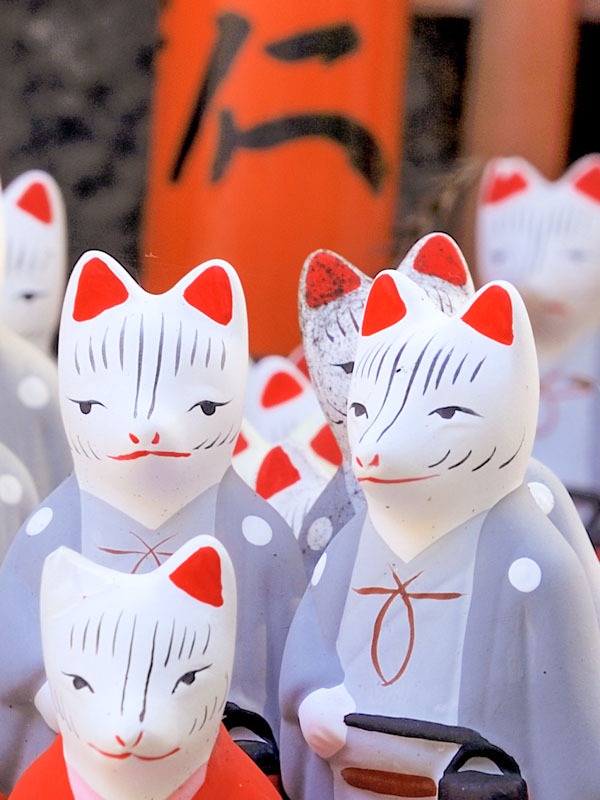
Get Inspired with Our Sample Itineraries
At Asia Highlights, we create your kind of journey — your dates, your destinations, at your pace. You can have any trip tailor made for your travel.
More Travel Ideas and Inspiration
The Asia Highlights Experience
- Southeast Asia Tours
- Japan Tours
- Thailand Tours
- Vietnam Tours
- Cambodia Tours
- India Tours
- Myanmar Tours
- Caucasus and Central Asia Tours
- China Tours
- Egypt Tours
- Morocco Tours
- Turkey Tours
- Our Differences
Asia Highlights uses cookies to give you the best possible service. If you continue browsing, you agree to the use of cookies. More details can be found in our privacy policy .
- Travel Planning Guide

A Travel Comparison for Vacations, Honeymoons, and Tours Japan vs. China
Should you visit japan or china, which country is cheaper, china or japan.
Should I visit Japan or China? This is a popular question for many travelers. By figuring out which country is more expensive, you'll understand where you'll get more bang for your buck. A week in China can cost you about $559 (per person), while a week in Japan may cost you around $865. These differences become even more noticable if you plan to spend a longer time in the country. 10 days , two weeks , or even one month of travel to China or Japan can really add to your travel budget.
Accommodation is often cheaper in China compared to Japan ($34 vs. $59). Budget travelers usually stay in less expensive hostels and guest houses, while nicer hotels often appeal to families and upscale travelers.
Or, compare hostel and guesthouse prices between China and Japan to find the cheapest accommodation here: China hostels and Japan hostels .
When comparing food in Japan vs. China they are not just different in cuisine, but also in price. Meal and restaurant costs in Japan ($30) are often cheaper than China ($23).
- Japan Prices China Prices
- Average Daily Cost Per person, per day Japan $ 124 China $ 80
- Accommodation Hotel or hostel for one person Japan $ 59 China $ 34
- Accommodation Typical double-occupancy room Japan $ 118 China $ 69
- Local Transportation Taxis, local buses, subway, etc. Japan $ 18 China $ 16
- Food Meals for one day Japan $ 30 China $ 23
- Entertainment Entrance tickets, shows, etc. Japan $ 19 China $ 17
- Alcohol Drinks for one day Japan $ 15 China $ 11
- Water Bottled water for one day Japan $ 4.47 China $ 1.00
How much are flights to Japan and China?
The price of a plane ticket may help you decide which country you should visit.
Find a Hostel in Japan or China
Hostels, guest houses, and locally owned B&B's are often the cheapest form of accommodation.
Related Articles for Japan
Related articles for china, when is the best time to visit japan and china.

Why is Japan more expensive than China?
What are the most expensive and cheapest cities and regions in japan and china.

How you can save money when visiting Japan and China?
Subscribe to our newsletter.
By signing up for our email newsletter, you will receive occasional updates from us with sales and discounts from major travel companies , plus tips and advice from experienced budget travelers!

More Country Comparisons
Pin this page.
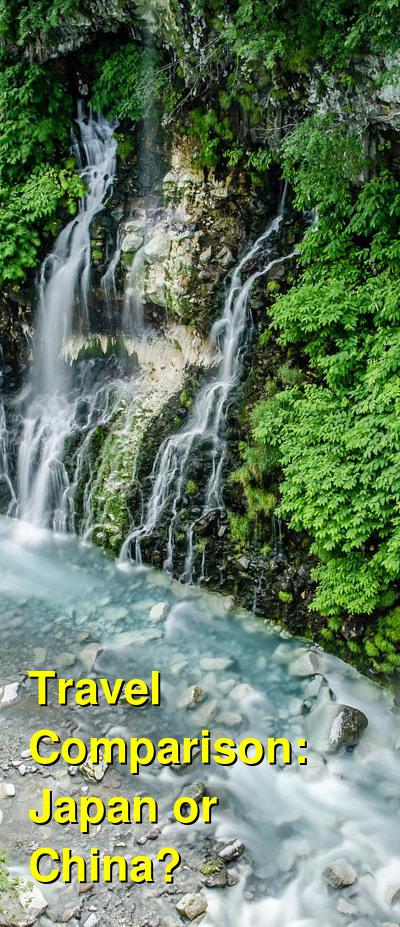
- Privacy / Terms of Use
- Activities, Day Trips, Things To Do, and Excursions
- Japan Tourism
- Japan Hotels
- Japan Bed and Breakfast
- Japan Vacation Rentals
- Flights to Japan
- Japan Restaurants
- Things to Do in Japan
- Japan Travel Forum
- Japan Photos
- All Japan Hotels
- Japan Hotel Deals
- Last Minute Hotels in Japan
- Things to Do
- Restaurants
- Vacation Rentals
- Travel Stories
- Rental Cars
- Add a Place
- Travel Forum
- Travelers' Choice
- Help Center
Where Should I Go - Japan or China - HELP!!!! - Japan Forum
- Asia
- Japan
Where Should I Go - Japan or China - HELP!!!!
- United States Forums
- Europe Forums
- Canada Forums
- Asia Forums
- Central America Forums
- Africa Forums
- Caribbean Forums
- Mexico Forums
- South Pacific Forums
- South America Forums
- Middle East Forums
- Honeymoons and Romance
- Business Travel
- Train Travel
- Traveling With Disabilities
- Tripadvisor Support
- Solo Travel
- Bargain Travel
- Timeshares / Vacation Rentals
- Asia forums
- Japan forum

** Disclaimer ** : - The question up ahead may sound stupid but please help me out. I know its a decision that only I can take but I am so torn
To help you folks (if it gives any idea of taste) I have been to France, Italy, Turkey, Thailand, Hong Kong, Singapore
In China, the idea mainly was to see the Forbidden city, the Great wall, maybe some chinese temples and if possible drink in the sights & sounds of beautiful countryside including rice terraces, huge gorges and ...... No Shanghai for me. I hav been to HK and thats good for me. My fear is that the great wall after a point maybe a let down and that a lot of china (the china I can reach in 8/9/10 days) will be industrialised steel and grey concrete strucures
In Japan, the plan would include, enjoying Tokyo , doing a bullet train, seeing Mt.Fuji if i can, watch the changing of leaf colour (autumn), those miniature gardens, seeing the all to back-to-the-future type electronic passions of Japanese youngsters, seeing a brilliantly lit up Tokyo etc
One Very Very important thing for me is Food. I live in India and what passes off as chinese cuisine here is as far from reality as Bombay is from Rio.I ate what was supposedly chinese claypot rice on the roadside in singapore a long time ago and I found the meats chewy and raw. I love to believe that I am a food connoisseur but the fact remains that strange flavours really put me off. I have tried Sushi & Sashimi and i find them at best bland and at worst, raw (Pardons from those going Blasphemy! Blasphemy!). I have munched on liver & brain, but in forms agreeable to my head.
I really want to go to a place where (yes I see something I have never known before) and where the food will be something I will be happy about over the years when I think back about it.
The other thing is people. I know Tokyo maybe an antithesis, but i really love going to places where the people are few, the sights exotic (something i have never seen before) & the experiences unreplicated back in my hometown
All of the above may seem short sighted to some.... I am sorry if anything comes across as too shallow.
If you could spend 5mins reading this and if you have been or know anything about these countries and can marry it to my conditions (ha ha ha), please share a view

Here's a list of places that you can browse around -- and spend hours browsing!
http://www.gotokyo.org/en/
http://www.kyoto.travel/
http://www.kamikochi.or.jp/english/
http://en.tohokukanko.jp/
http://www.kanazawa-tourism.com/
Here's a recent article about food. Scroll down --
"Tokyo would probably be the foreign city if I had to eat one city’s food for the rest of my life, every day," Anthony Bourdain tells GPS. "It would have to be Tokyo, and I think the majority of chefs you ask that question would answer the same way."
http://globalpublicsquare.blogs.cnn.com/2013/04/12/anthony-bourdains-top-food-destination-in-america-is/
Good luck in deciding!

November is a great time for fall colors in Japan. You won't find nature of continental scale like in mainland China, or immensely huge structures of the Forbidden City or the Great Wall, but you'd find refined gardens, old sophisticated temple architectures, and beautiful nature which is usually quite tender and generous to people living in it. Tokyo is a big city indeed, but it isn't a frantic and energy overloaded place. It can be calm and orderly; can be boring and conformist to some.
For many tourists, Tokyo won't be the highlight. There are far more culturally interesting things to see in Kyoto , and shopping/food experience could be more entertaining in Osaka . Provincial cities and towns like Takayama , Hiroshima , Yamagata, Hakodate, Otaru, and onsen towns in the mountains and by the sea (Kusatsu, Kinosaki, Shirahama, to name a few), are quite charming as well.
Also, Japan is a lot easier country to plan a DIY trip.
http://www.jnto.go.jp/eng/
http://www.japan-guide.com/e/e623.html
http://www.japanrailpass.net/eng/en001.html

Tokyo is a huge sprawling network of neighbourhoods with a few highly developed 'nexus points' built mainly around large rail stations.
Osaka is more like the cities in Europe you will have visited as it has much clearer central regions and districts. Where Tokyo takes several days to get a sense of, Osaka will yield much more of what it has to offer on a short visit.
Much of the openly flaunted youth culture popularised internatioanlly around 10 years ago has been in demise in Tokyo so you won't seem much more there then you would in Osaka. So despite my own devotion to Tokyo, I am fully supporting Yobeekool's comments suggesting that Osaka would probably suit you better.
Your comments about Japanese food remind me of how many British people perceive Indian food.
My advice here is not to go to a cheap place for sushi (these often, but certainly not always, have conveyor belts in them) or to a supermarket or department store and decide that this is what sushi - or sashimi is.
Even if you pay a lot of money and sushi or sashimi features as part of a multi course meal, that is also not representative of GOOD sushi.
I once spent 9 days in Japan on business and ate sushi nearly every day as part of banquets, gala functions, pleasure cruise trips etc. By the end of the stay I had decided that I must have been mistaken on previous occasions and that I actually didn't like sushi very much. When a relative said he was taking me out for dinner on my last day - for sushi - my heart sank. But we went to a specialist sushi restaurant and I left Japan remembering that I ADORE sushi. There is a world of difference between bad or mediocre sushi and the good stuff. However, the good stuff is NOT cheap. Better to have good sushi once than eat some economic version every other day. I don't believe you've eaten anything that even remotely touches what the good stuff actually is.
In Japan (where we are at the moment) we have enjoyed the smaller towns ( Takayama , Shibu Onsen) where you can wander around the back streets and see how real people live.
One more thing that I forgot to mention is that the big cities in China are going to be extremely smoggy on most days. It will be a haze or fog (as the Chinese call it) that can be quite a shock to your lungs if you're not used to it or not prepared for it. This cannot be understated. Just do a search on "china air pollution" or similar and look at the images that return from the search. It looks like fog but is actually smog.
NB50, see what causes the *poor visibility*:
http://en.wikipedia.org/wiki/Asian_Dust
http://www.survivingnjapan.com/2011/05/yellow-sand-in-japan-how-does-it-affect.html
and compare with your city's.
- train as transportation on tour 4:38 am
- Itinerary Help - is it too much 4:25 am
- Hotel in Kyoto 3:57 am
- Transiting through Haneda Terminal 2 to Terminal 3 3:31 am
- Eating Food 3:28 am
- Teamlabs Borderless - Motion sickness? 2:50 am
- Facial and massage recommendations near Osaka umeda 2:44 am
- Haruka Hello Kitty Tennoji to Kyoto 2:30 am
- Naruto & Boruto theme park 1:49 am
- Itinerary advice 2 weeks trip 1:43 am
- How long does Japan Tourist eVisa take to process? 1:25 am
- Help to find Express passes to Universal 1:22 am
- Favorite Luxury Ryokan and/or Onsen to visit in Hokkaido 12:57 am
- Changing trains at Namba - to subway 12:42 am
- 'semi double' rooms 5 replies
- Pocket WiFi Rental Experience? 315 replies
- kyoto-takayama JR or Lmtd express??? 6 replies
- Best Japan travel guide book? 29 replies
- Best/cheapest time of year to visit?? 3 replies
- Radiation danger in Tokyo? 37 replies
- Best Skiing in Japan? And When? 3 replies
- Japan in 10 days 3 replies
- How far is Nara from Kyoto 8 replies
- how to get to Hokkaido from Tokyo? confused..pls HELP. 5 replies
- 2024 public holiday chart in East Asian countries
- Where can I find more onsen in Japan?
- Driving Information
- Catholic mass in English and other languages
- How can we access tourist attraction from cruise port?
- Pocket WiFi Rental Experience?
- Halal Information
- Tokyo trip report here
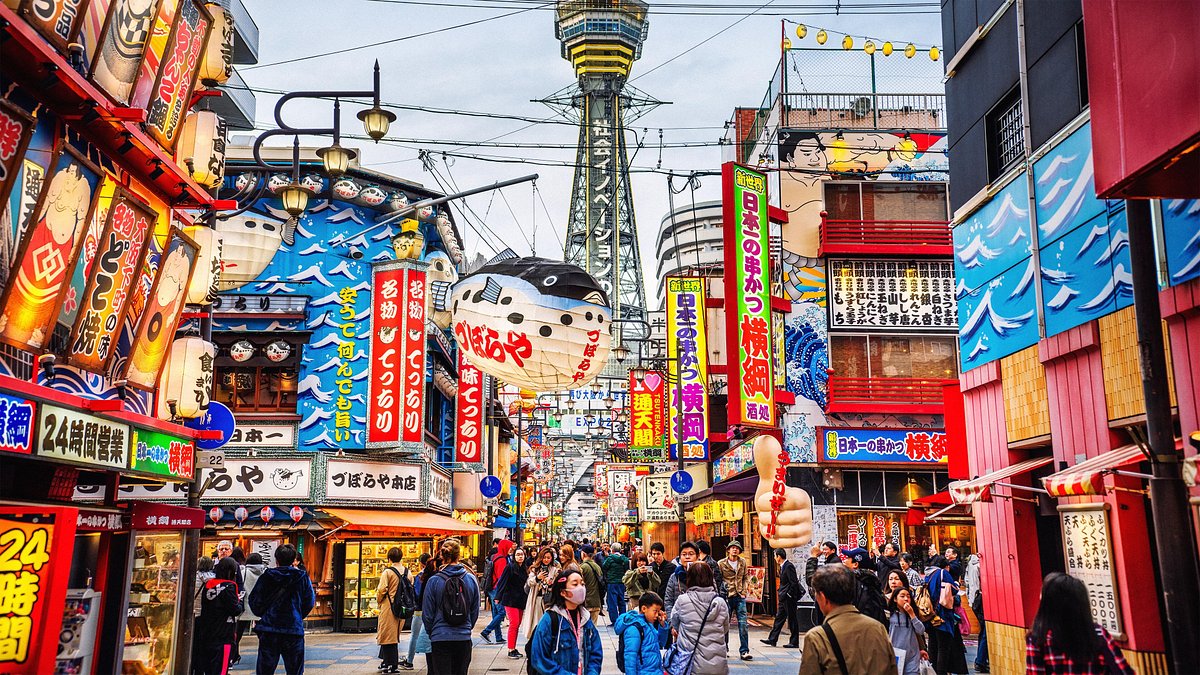

Biden holds call with China’s Xi ahead of Japan, Philippines meetings
P resident Biden spoke with Chinese President Xi Jinping on Tuesday morning, in a first follow-up call since the two leaders met in California last year.
The timing of the call comes ahead of critical meetings between Washington and allies from the Indo-Pacific, which China views as provocative. This includes a state visit by Japanese Prime Minister Fumio Kishida on April 10; and a first-of-its kind trilateral meeting between Japan, the Philippines and the U.S. on April 11.
“U.S. alliances and partnerships are not about China … but oftentimes, Chinese actions motivates much of what we talk about,” a senior administration official told reporters Monday night, previewing the president’s call. “But that is something, certainly well within China’s control, what it says and does, and the impact it has on U.S. partners and allies throughout the region.”
Efforts at increased communication between Washington and Beijing are aimed at stabilizing ties between the countries that are fraught with pitfalls for conflict.
The senior administration official said the call was scheduled as a “check in” between the two leaders following their bilateral summit in Woodside, Calif., on the sidelines of the Asia-Pacific Economic Cooperation (APEC) summit in November.
“Both President Biden and President Xi agreed to try to pick up the phone a bit more, use that tool as a means of responsibly managing the relationship, of being in closer touch at the leader level — which is so very critical in the Chinese system — on a more regular basis,” they said.
The last time the leaders spoke by phone was in July 2022.
The call comes following Biden and Xi’s commitment to take concrete actions to improve the relationship between the U.S. and China that has deteriorated over a host of issues, but include China’s anger at Washington’s support for Taiwan; China’s support for Russia’s war against Ukraine; a Chinese spy balloon infiltration of the U.S.; and provocative confrontations between Chinese ships and those from the U.S. and other partners in contested waters in East Asia and the Pacific.
Biden is expected to raise concern on the call with Xi over a confrontation late last month between Chinese coast guard ships using water cannons against Philippine ships in the South China Sea.
“The President may also express concern over destabilizing PRC [People’s Republic of China] actions in the South China Sea, including the dangerous, recent action of the PRC coast guard against routine Philippine maritime operations near Second Thomas Shoal,” the official said.
They added that Biden is also expected to reiterate support for the “One China” policy, which holds back U.S. recognition of Taiwan as independent, but does not acknowledge China’s claims to the democratically-governed island.
Biden will reiterate “the importance of peace and stability across the Taiwan Strait, especially given the upcoming major presidential inauguration in Taiwan,” the official told reporters.
Also, among the commitments from the APEC summit included the request for China to rein in the export of precursor chemicals used to make narcotics illegally entering the U.S.
“We have seen the PRC implement some initial measures to restrict and disrupts the flow of certain precursor chemicals used to produce illicit synthetic drugs,” the official said.
“But of course, the drug trade is continually evolving and changing and in order to ensure that we are disrupting this trade flow, we, the U.S. and China need to maintain close consultations with law enforcement at the technical level and otherwise, to really drive that substantive law enforcement action,” they added.
The U.S. is also pushing for more predictable military-to-military communications between Washington and Beijing to avoid the potential for conflict in disputed waters, and the White House endorsed progress on this front.
“President Biden has made clear that this mil-mil communication is critical at all times, but especially during times of heightened tensions,” the official said.
The administration is also working on holding a U.S.-China dialogue on “managing the risk and safety challenges posed by advanced forms of artificial intelligence” and expressed support for China’s support at the United Nations on a resolution calling for the responsible use of artificial intelligence.
The call is not expected to yield any new initiatives, though the official sought to demonstrate that such communication was beneficial in laying the groundwork for another, potential in-person meeting, although that would be difficult to coordinate ahead of the November presidential election.
“I would anticipate, depending on what happens in the coming year, we would hope there would be a chance for another in person meeting,” the official continued. “But don’t have anything even to speculate on when that might be, but there’s certainly value in that in-person meeting and the calls in the interim.”
For the latest news, weather, sports, and streaming video, head to The Hill.
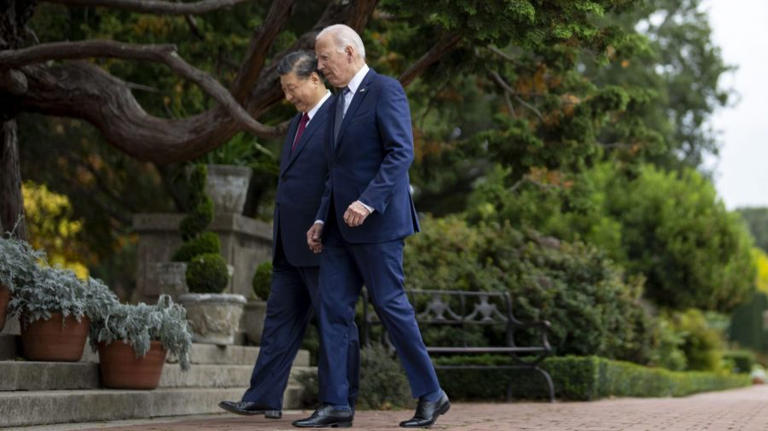
We've detected unusual activity from your computer network
To continue, please click the box below to let us know you're not a robot.
Why did this happen?
Please make sure your browser supports JavaScript and cookies and that you are not blocking them from loading. For more information you can review our Terms of Service and Cookie Policy .
For inquiries related to this message please contact our support team and provide the reference ID below.
Japan business leaders to visit China in January

Japanese business leaders will visit China in January, the chairman of Japan's biggest business lobby said Monday, amid heightened tensions between the two nations over the release of treated radioactive water from the crippled Fukushima nuclear power plant into the sea.
"We are faced with the issue of the treated water, but we must make efforts to have a dialogue, especially at times like this," Masakazu Tokura, head of the Japan Business Federation, also known as Keidanren, said at a press conference.

The visit will mark the first such trip since September 2019. A business mission organized by Keidanren and some other groups had been visiting China almost every year since 1975, but the coronavirus pandemic disrupted these interactions.
The water release prompted China to impose a ban on all seafood imports from Japan. Tokura called China's response "extremely regrettable."
"We hope to create a free and open economy together with China," he said.
Related coverage:
Japan business leaders to make 1st China visit after COVID in January
Japan giving 20.7 billion more yen for fisheries amid China import ban
Japan gains understanding from Jordan over Fukushima water release
Sep 4, 2023 | KYODO NEWS
M7.7 quake in Taiwan kills 9, injures more than 1,000
Apr 3, 2024 | KYODO NEWS
Fans bid farewell to giant moving Gundam in Yokohama
Mar 31, 2024 | KYODO NEWS
Cherry blossom season arrives across Japan, including Tokyo, Kyoto
Mar 29, 2024 | KYODO NEWS
Princess Aiko begins 1st day of work at Japanese Red Cross Society
Apr 1, 2024 | KYODO NEWS
Japan publisher threatened over publication of trans-skeptical book
Mar 30, 2024 | KYODO NEWS

More from Japan

Trump to champion U.S.-Japan alliance if he returns to power: ex-aide
2 hours ago | KYODO NEWS

Kyodo News Digest: April 4, 2024

Japan football manga "Captain Tsubasa" ends after 43-yr run
Apr 4, 2024 | KYODO NEWS

LDP to punish 39 members over funds scandal, urge 2 to leave party

Kyodo News Digest: April 3, 2024

Shizuoka gov. to quit as maglev plan delayed, not to retract comments

18 taken to hospital after lightning strikes football game in Japan
Subscribe to get daily news.
To have the latest news and stories delivered to your inbox, subscribe here. Simply enter your email address below and an email will be sent through which to complete your subscription.
* Something went wrong
Please check your inbox for a confirmation email.
If you wish to change your message, press 'Cancel' to go back and edit.
Thank you for reaching out to us. We will get back to you as soon as possible.
- Work With Us
- Blogging Bootcamp

- Van Conversion Academy
- Campervan Shop
- Campervan Rentals
- Plan a Trip
- Itineraries
- Destinations
- Responsible Travel
- Family Travel
- Budget Travel
- Scuba Diving
- Travel Credit Cards
- Digital Nomad
- Teach English Abroad
- Blogging Resources
- Income Reports
- Travel Shop
- Meet Katie & Ben
- About Two Wandering Soles
- Personal Stuff
- Portfolio & Press
Best Time to Visit Japan: When to Go & When to Avoid!
Home » Blog » Travel Tips » Best Time to Visit Japan: When to Go & When to Avoid!
Choosing the best time of year to visit Japan can be downright overwhelming. Each of Japan’s 4 distinct seasons has its draws and drawbacks (some more than others!). We’re going to break down exactly what to expect during winter, spring, summer, and fall so you can choose the best time to visit Japan based on your travel style and interests.
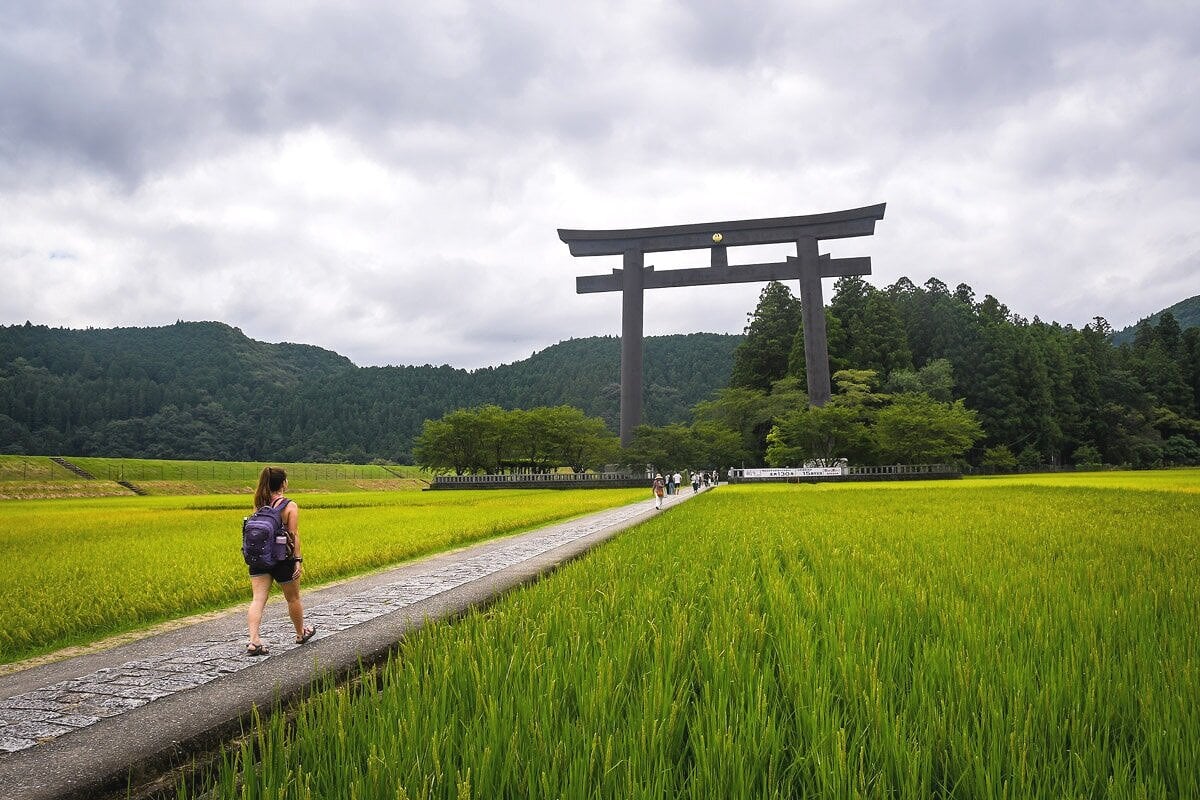
Japan has four distinct seasons: You’ve got the famed cherry blossoms in the spring, festivals in the summer, vibrant foliage in autumn, and powdery snow come wintertime.
So this begs the question:
What time of year is best to visit Japan?
In short, you’ll have the best chance of comfortable weather and fewer crowds in early spring (March – early April) and in autumn (late October – November). Our personal pick would be to visit Japan during November; but more on that later…
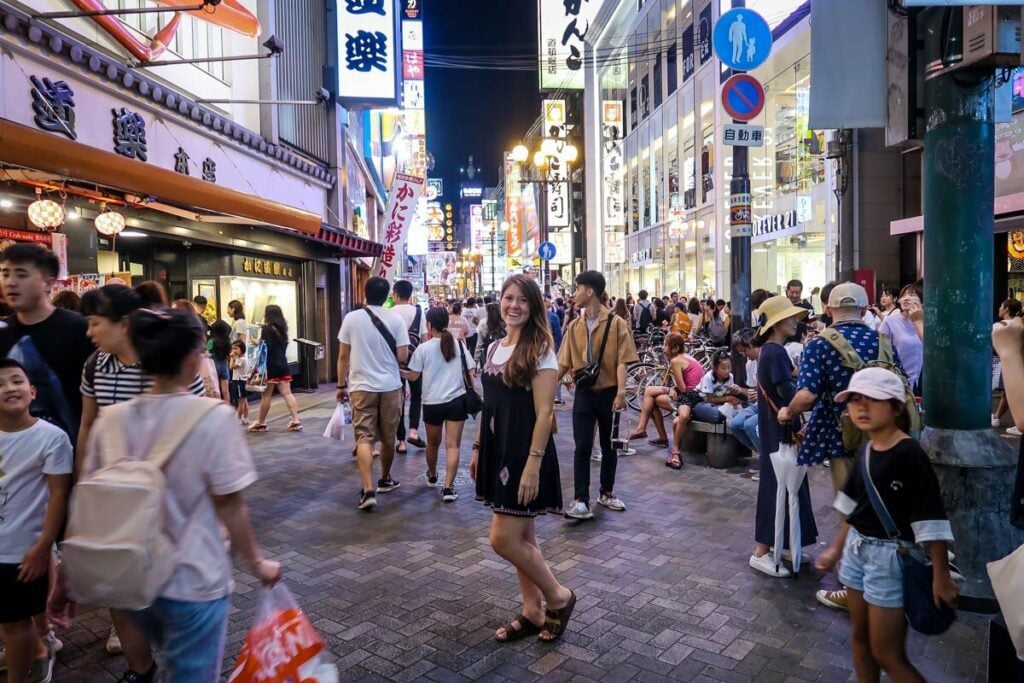
Let me backup… Truthfully there is no correct answer, as each season has its own unique draws (and drawbacks too).
But we’re not going to just leave ya there, hangin’.
We’re going to go over the pros and cons of visiting Japan during each season to help you decide which time of year is ideal for YOU.
Just staying in Tokyo? We have another article about the best time to visit Tokyo , specifically!
Answer these questions to get started:
- Do you mind hot weather?
- What about cold weather?
- Are you easily bothered by crowds?
- How much of your time do you want to spend outdoors?
- Which would you rather see: cherry blossoms or colorful fall foliage?
Thinking about your answers to these questions is going to help you start to determine when to visit Japan.
Best time to visit Japan guide
Our experience, japan geography overview, weather in japan.
- Rainy season in Japan
- Typhoon season in Japan
- Best time of year to view Mt. Fuji
- Seasons in Japan
- Holidays and festivals in Japan
- Best time to travel based on activity
- How many days to spend in Japan
- What to pack for Japan
Overall BEST time to visit Japan
Want a quick recommendation? Jump down to see our personal advice for the best time to visit Japan. Plus, we’ll share what times of year we’d avoid visiting!
- Our Recommendation…

The ultimate Japan packing list
If you’re planning a trip to Japan, we have the ultimate resource for you!
This FREE PDF download includes everything you’re going to want to pack for your Japan trip, including what NOT to bring, plus tons of insider tips!
Sign up for our ultimate Japan packing list now and get a copy sent straight to your inbox.
We visited Japan in summer, fall & winter
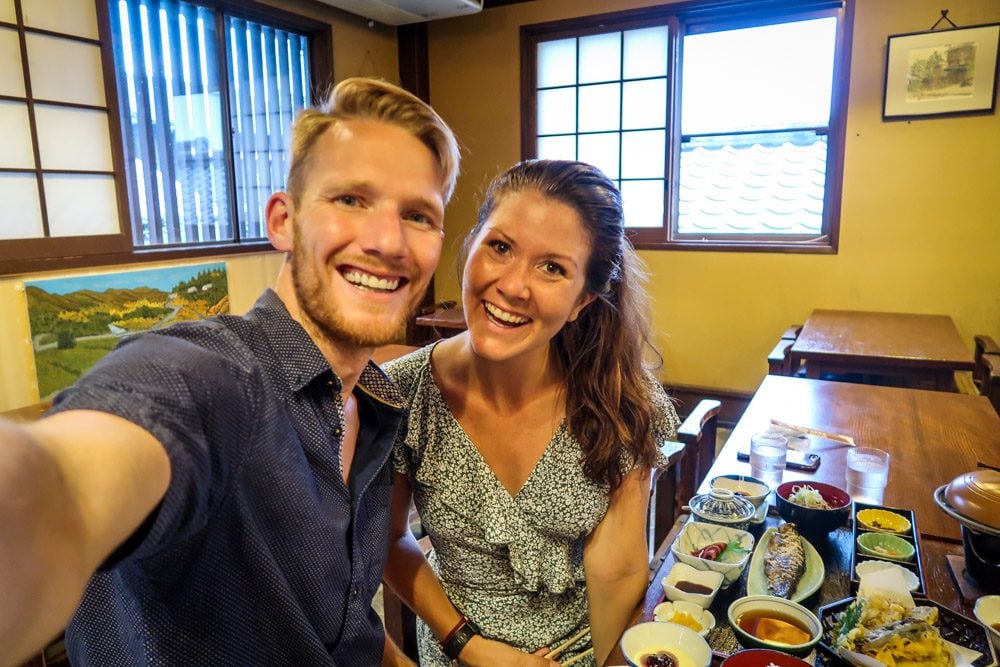
When: mid-August (2019)
Our experience:
- Very hot and humid in most places
- Lots of Japanese tourists and international travelers in the popular places
- We had a few days of typhoon weather
- Mount Fuji wasn’t on our route, but she was only visible for a handful of days of our trip, due to clouds.
- Felt too hot to be able to enjoy onsens as much as other times of the year
Would we recommend visiting Japan in August?
It wouldn’t be my top recommendation, honestly. I found it very hot and muggy, and I would much prefer visiting when the temps are more comfortable.
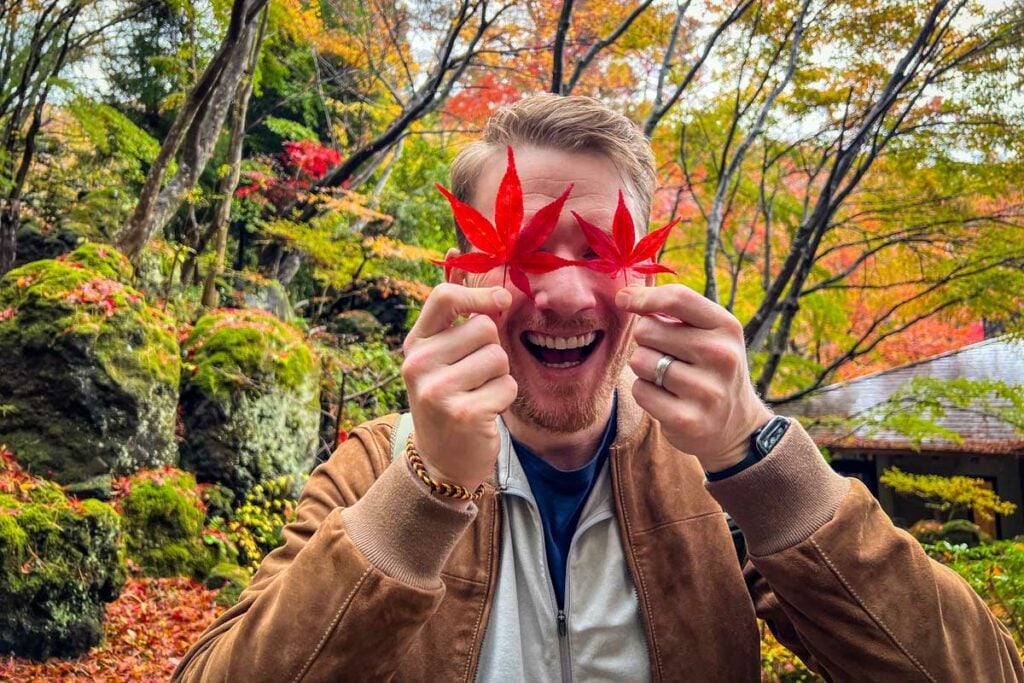
When: mid-November (2023)
- Comfortable temperatures and no humidity
- Colorful foliage in some areas (it differs quite a bit throughout the country)
- During our 3-week trip, we had a little light rain , but not much
- Clear views of Mount Fuji
- Perfect weather for soaking in onsen
- Crowds in popular areas for foliage viewing, but nothing overwhelming
Would we recommend visiting Japan in November?
Absolutely! Autumn is perhaps my all time favorite time to travel anywhere — and Japan is no different. I think autumn will always be my favorite time to visit Japan!
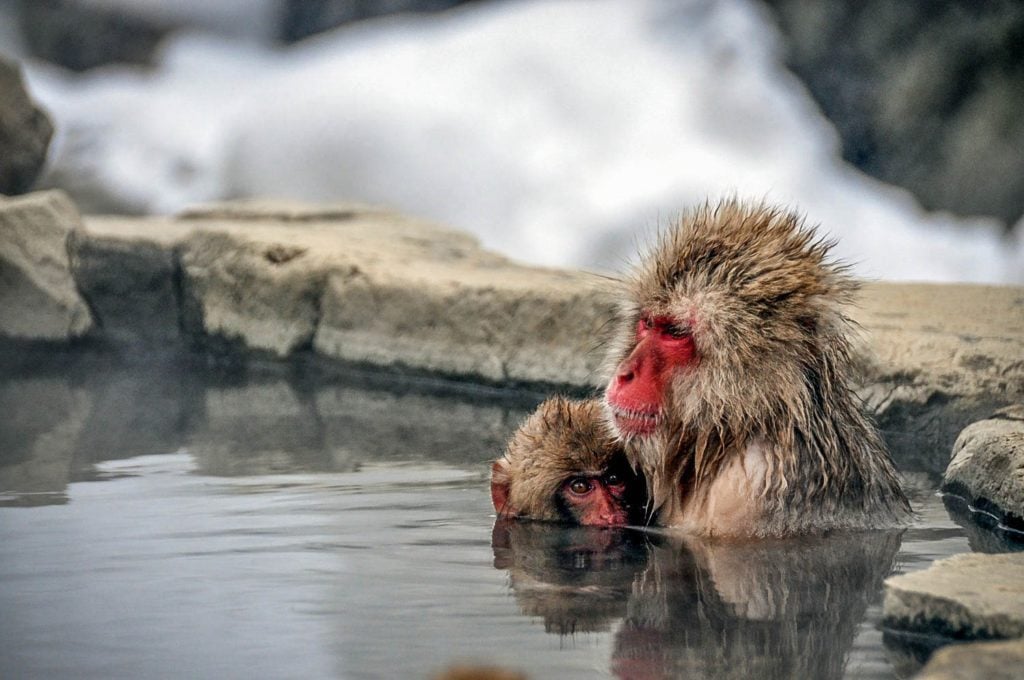
When: early February (2015)
- Mild winter temperatures (we’re used to very cold winters, and this wasn’t bad for us)
- Snow in the mountains was magical
- Even though winter is said to be the best time to view Mount Fuji , she was covered in fog when we visited
- Onsens were very enjoyable (we had a private outdoor onsen while it was snowing, which was amazing!)
- Obviously the cities are still busy (because they’re highly populated), but the amount of tourists was lower than other seasons
- Good deals on accommodation since it was outside of peak season
- We saw a few plum blossoms in Tokyo that were blooming early, which was a pleasant surprise!
Would we recommend visiting Japan in February? Yes! I think winter is one of the best times to visit Japan and it’s very underrated. Next time we visit in the winter, I want to add more outdoor onsens and a snowboarding trip in the legendary Japanese powder!
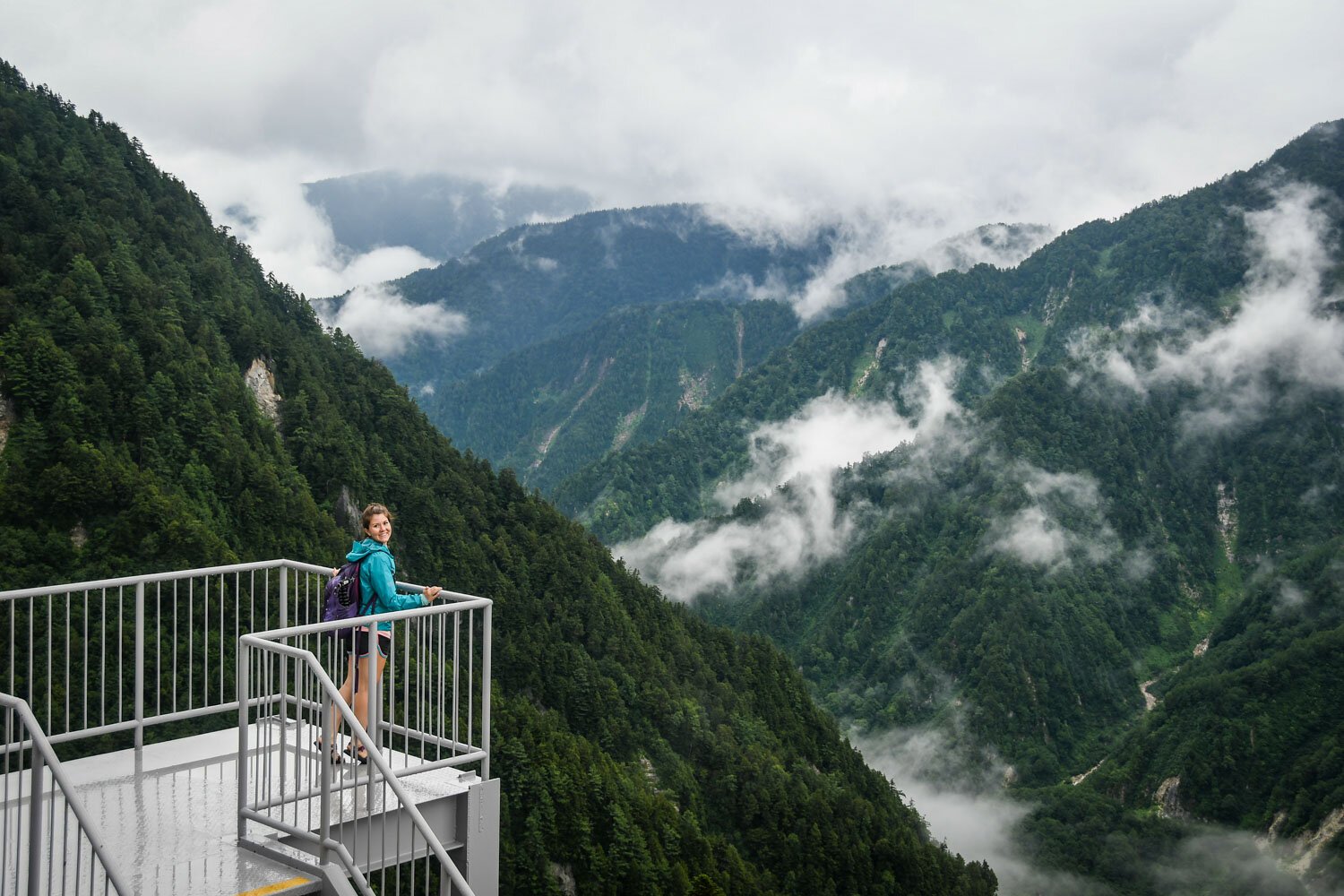
While not a large country exactly, Japan spreads more than 1,800 miles (2,900+ kilometers) north to south, from the island of Hokkaido in the northeast all the way down to the island of Okinawa in the southwest.
A distance that large means the weather from north to south varies quite a lot. Hokkaido can be freezing while the subtropical island of Okinawa can be experiencing a beach day.
For the purpose of this article, we’ll mostly be discussing the weather on the island of Honshu.
Located in the middle of the country, Honshu is where Tokyo , Osaka and Kyoto are all located, and is where most international travelers will start and end their trip, especially if it is your first time in Japan .
Another thing to take into consideration is that Japan is a very mountainous country. Common sense tells us that when you venture to higher elevations, you’ll find colder temperatures.
Fun Example: We went up into the Japanese Alps in August and found a drastic temperature swing: 95°F (35°C) at sea level to 65°F (18°C) in the mountains. This same area has snow until as late as early July. Crazy, huh?!
Psst! If you’ll be traveling more throughout the country, be sure to check out our bucket list of crazy fun things to do in Japan !
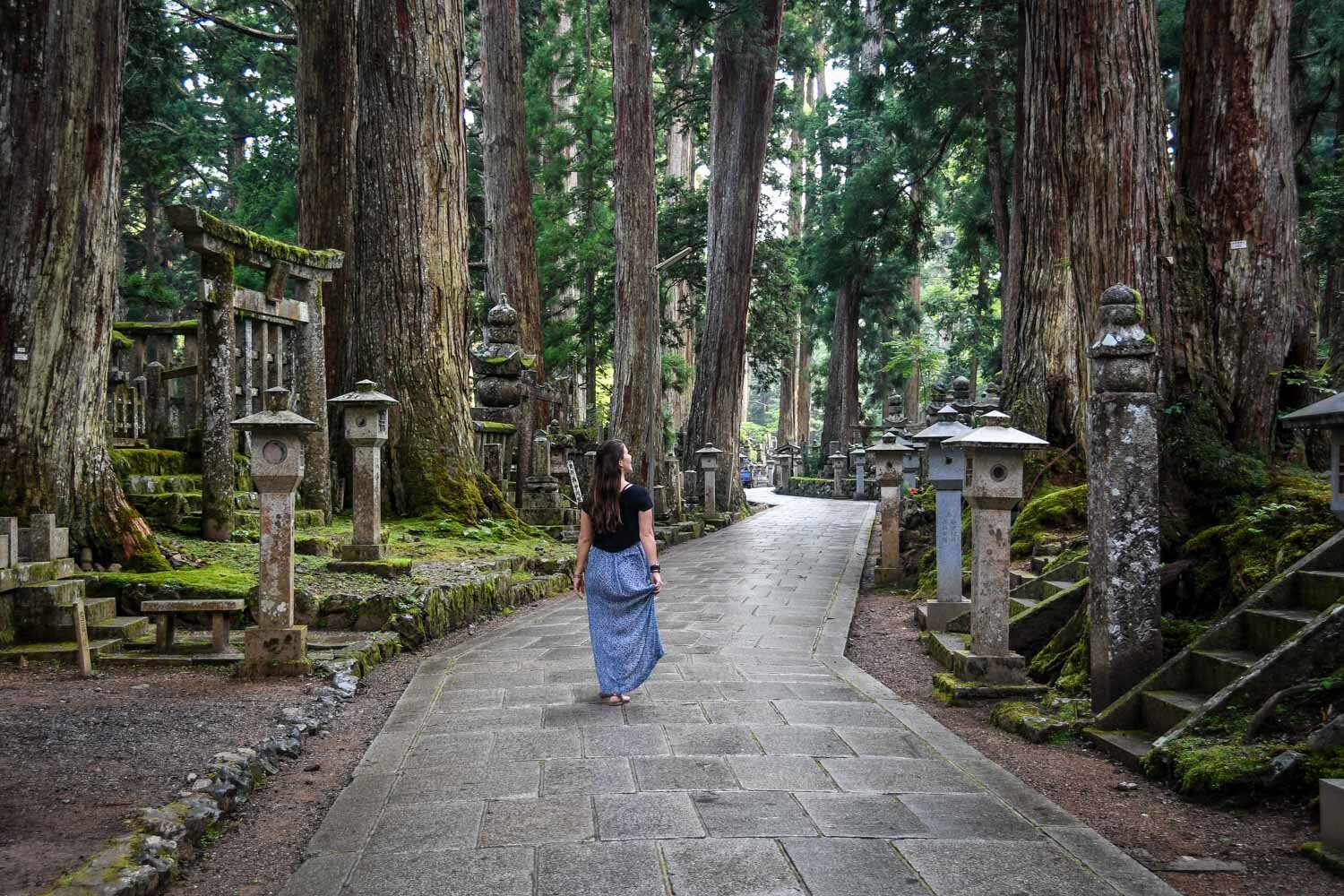
Let’s chat about the sun, the snow, the rain, and those dreaded typhoons. We’ll go over what type of weather you should expect throughout the year and describe our experience with a typhoon.
We’re also going over some important information if you are interested in viewing Mount Fuji.
Spoiler alert: You won’t be able to see this iconic mountain for much of the year.
Stats on Japan weather & seasons:
- Hottest month in Japan: August (average 80°F/41°C)
- Coldest month in Japan: January (41°F/5°C)
- Rainiest months in Japan: June and September
- Driest months in Japan: December and January
- Most crowded month in Japan: late April – early May (aka “Golden Week”, explained in the section about Spring )
- Least crowded months in Japan: January – early March are the least popular times to visit, which can mean cheaper prices and less crowds
Note: Again, these stats are for the central island of Honshu. If you are planning to visit the northernmost island of Hokkaido, or Okinawa in the very south, be sure to look up their specific weather, as they vary from the rest of the county.
Rainy season in Japan: Early Summer
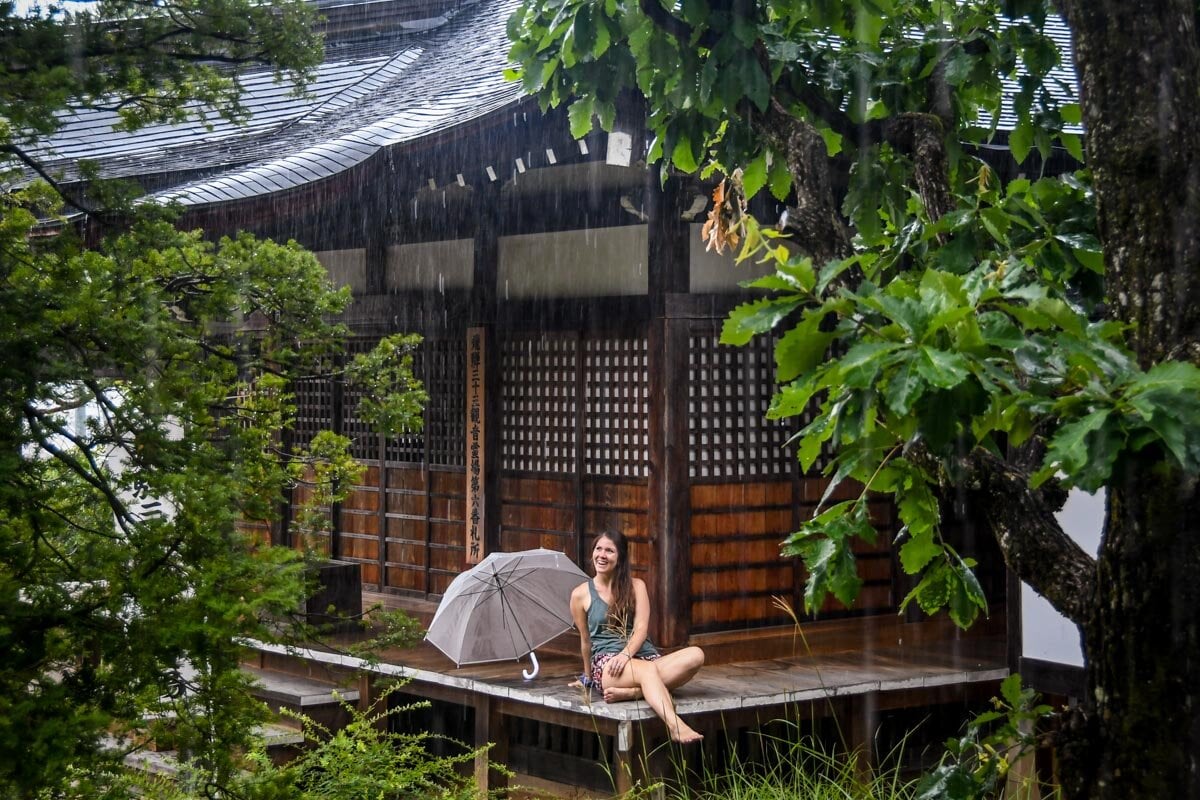
The majority of the country experiences a rainy season from June through mid-July.
The good news is that during the rainy season, there’s a roughly 45% chance of precipitation each day (data from Tokyo), meaning you’ll have some dry days too! Some of those rainy days will be heavy, while others will be sunny before or after the rain.
Interesting Fact: Tokyo is one of the rainiest big cities on earth! In fact, it has more than double the amount of annual rainfall as London. Say whaaaat?!
Despite rain, you’ll find life goes on as usual in Japan, as locals are used to it. Do as the Japanese do and buy an umbrella to stay dry!
Typhoon season in Japan: Late Summer
Late May through October is known as typhoon season in Japan, with the majority of typhoons occurring in August and September. Data from the last 30 years show that an average of 11 typhoons approach the coast per year.
What is a typhoon?
A typhoon is a tropical cyclone. They are formed in the same way a hurricane forms, and the only real difference is the location at which they occur .
What is a typhoon like in Japan?
We visited Japan during the month of August, which as you now know is the peak of typhoon season. And one typhoon made landfall during our visit.
So how bad was it, really?
This was our experience:
The entire day leading up to the typhoon was sunny with blue skies, and we both had this feeling that it wouldn’t be that bad.
But everyone was talking about it and how strong it would supposedly be. There was talk about trains shutting down, and we had a food tour cancel on us because restaurants were closing up shop.
But it’s beautiful outside, we thought naively. We put on rain jackets, grabbed our one umbrella and headed into town just as a drizzle began to start.
Soon, the winds increased and the rain started really coming down. But the trains still ran, and we decided to go catch a movie. By the time we got out of the show, the streets were mostly empty and the rain was really pounding, so despite our umbrella and rain jackets, we got completely soaked.
By the next morning, blue skies started peeking out from behind clouds and by the afternoon you would never know what had happened the previous night.
What to expect: Heavy rainfall and high winds, canceled and/or delayed trains, canceled tours. In some cases, it may only interrupt a day or two, and in others it might have longer-lasting effects. You should expect some plans to change since Japanese people take typhoons very seriously.
Best time of year to view Mount Fuji
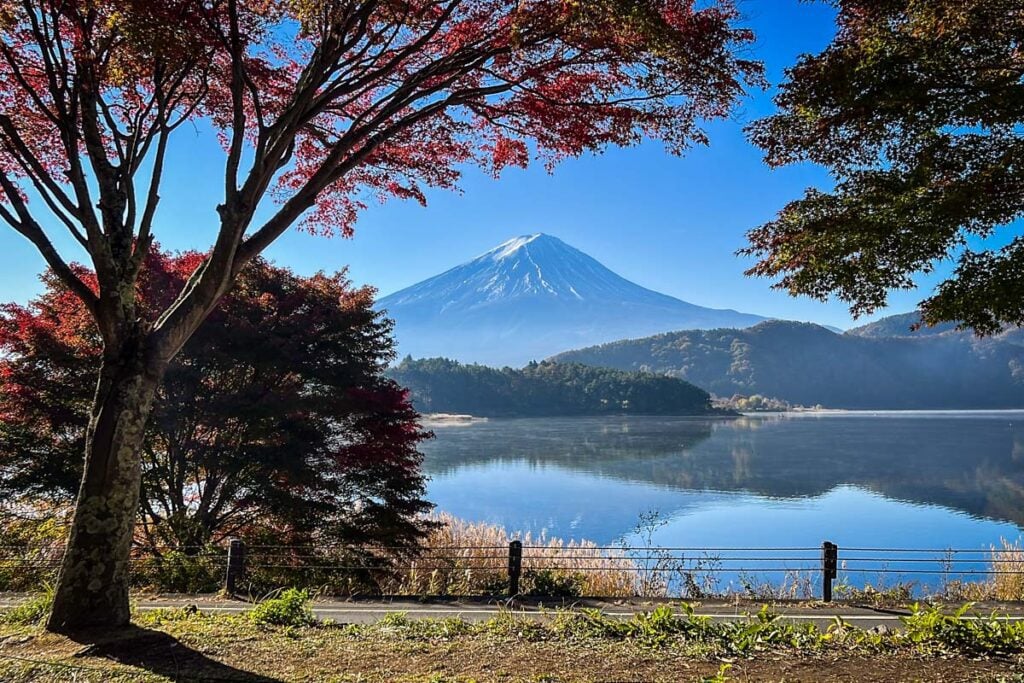
Many visitors to Japan will want to glimpse the country’s most famous mountain, and for good reason — it’s absolutely stunning, and seeing Mount Fuji in person will be one of the highlights of your trip. That is, if you see her .
One thing many first-time visitors to Japan may not realize (ourselves included) is that Mount Fuji is notoriously shy. This means there is much of the year where your chances of seeing her are rare. Instead, this shy mountain will stay cloaked behind clouds and haze, only occasionally peeking through.
So what time of year will you have the best chance of seeing Mount Fuji?
- Best chances of seeing Mount Fuji: Based on data from years past, you will have the highest chance of seeing Mount Fuji between the months of November and February.
- Worst chances of seeing Mount Fuji: Alternatively, between April and August, you will have a slim chance of glimpsing this iconic mountain.
That said, nothing is promised when it comes to weather.
We visited Japan for the first time during early February, when we should have had a good chance of seeing Fuji. We spent the night in Hakone and bought the (not so cheap!) Hakone Day Pass to get close to the mountain, yet we only saw WHITE FRICKIN’ CLOUDS.
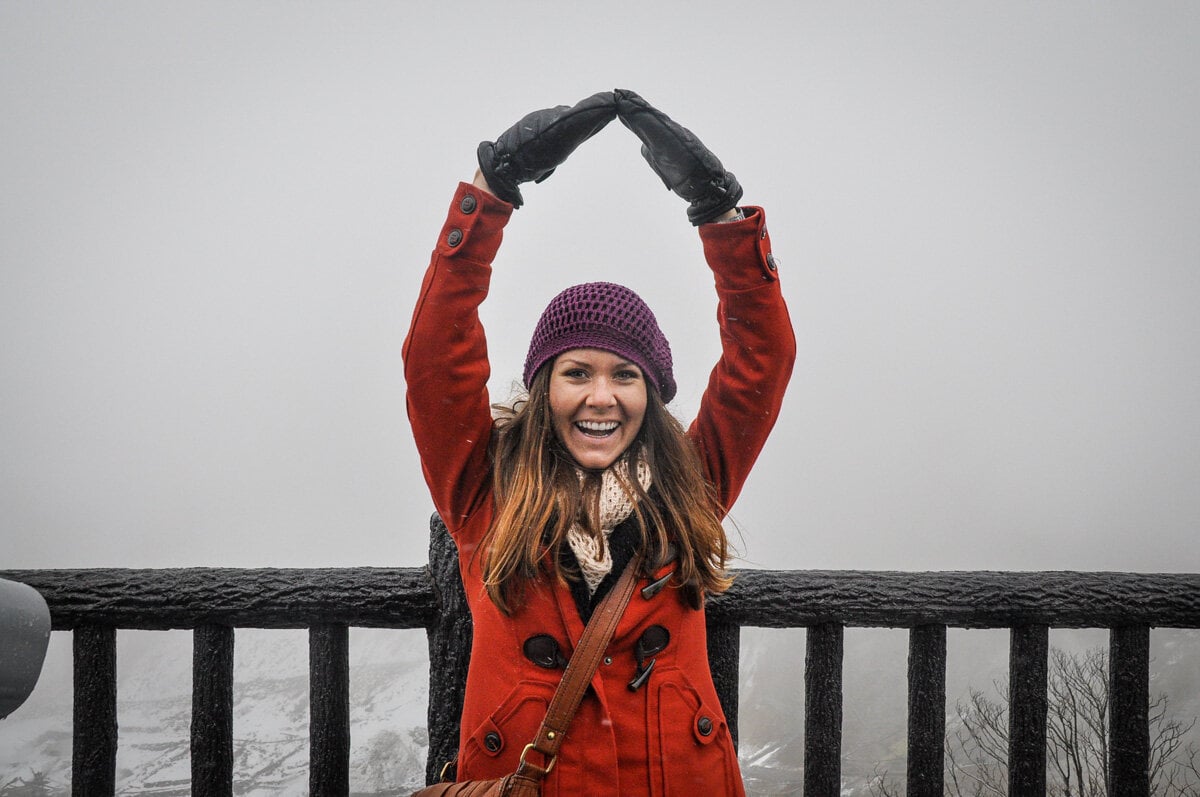
And on the other hand, we’ve known people who have seen Fuji peek out during July and August, supposedly bad months for viewing the mountain.
But if you’re looking to get that iconic shot of a clear sky day and the mountain towering in the background in her famous symmetrical grandeur, late autumn through early spring will be your best bet at capturing this sight.
Psst! Check out our list of the most beautiful places in Japan you’ll have to see to believe!
Japan’s seasons at a glance
Japan has 4 distinct seasons: The winter is cold and the summer is hot. If either of those would bother you, it’s easy to eliminate a season right off the bat.
Spring is famously known for stunning displays of cherry blossoms around the country . But when we say famous, we mean it. Japan gets very busy this time of year with domestic and international travelers, so if crowds bother you, this is another easy elimination.
Fall comes with spectacular autumn foliage , and while not as crowded as cherry blossom season, it’s not an unpopular time to travel.
Jump to the season you’re interested in to read more about what to expect:
Winter in Japan
Spring in japan, summer in japan.
- Autumn in Japan
We’re going to go over what to expect during each season in detail so you can better plan your trip to Japan.
But before we dive in…
Did you know there are 72 “seasons” in Japan?
The traditional Japanese calendar was split up into 24 sections, and each of those were further divided into 3 subsections, creating 72 “micro seasons” .
These micro-seasons last 5 days, and the names of some of them are poetic:
- Frogs start singing (May 5th – 9th)
- Great rains sometimes fall (August 3rd – 7th)
- Dew glistens white on grass (September 8th – 12th)
- Insects hole up underground (September 28th – October 2nd)
- Maple leaves and ivy turn yellow (November 2nd – 6th)
While this isn’t necessarily something people go by in modern times, it’s a good reminder that the weather and atmosphere changes very often in Japan and it’s important to be prepared for it all.
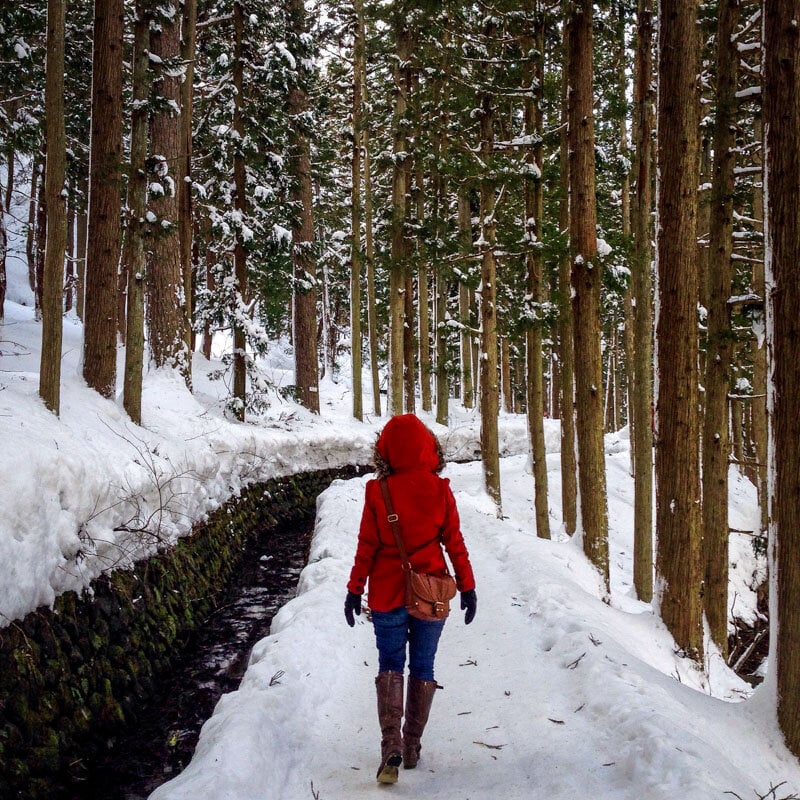
During the winter months, major cities like Tokyo, Osaka and Kyoto tend to enjoy mild temperatures, but you can find snow and colder temps in the mountains and on Hokkaido (the northernmost island in Japan).
Crowds tend to be fewer during the winter season, except for at the ski resorts where outdoor enthusiasts will be spoiled with some of the best powder in the world.
Winter comes with sunshine and blue skies that are statistically the clearest they’ll be all year long.
While winter may not be the first season you think of traveling, there’s actually a ton to do, and we think it is a great time to visit Japan .
- When is winter in Japan? December – February
- Typical weather in Japan during the winter: Dry, cold, & sunny
- Average winter temperatures: 35 ° F – 55 ° F (Tokyo) (2 ° C – 13 ° C)
- least crowded season, great for visiting Japan’s iconic landmarks
- Japan has great snow for skiing and snowboarding
- great time for onsens, snow monkeys and seeing scenic landscapes & villages dusted in snow
- cold weather, averaging around 43°F (6°C)
- some outdoor activities, like hiking and biking may be more difficult in the winter
Winter months at a glance
- December: Third coldest month of the year, lots of Bonenkai (“forget the year”) parties and celebrations. Ski season begins in Sapporo.
- January: Coldest month of the year, clear and sunny skies, snowy in the northern part of the country, best month for skiing and winter activities.
- February: Second coldest month of the year, still great for skiing in the mountains, yet you can start seeing spring plum blossoms further south in the country.
Best things to do in the winter in Japan
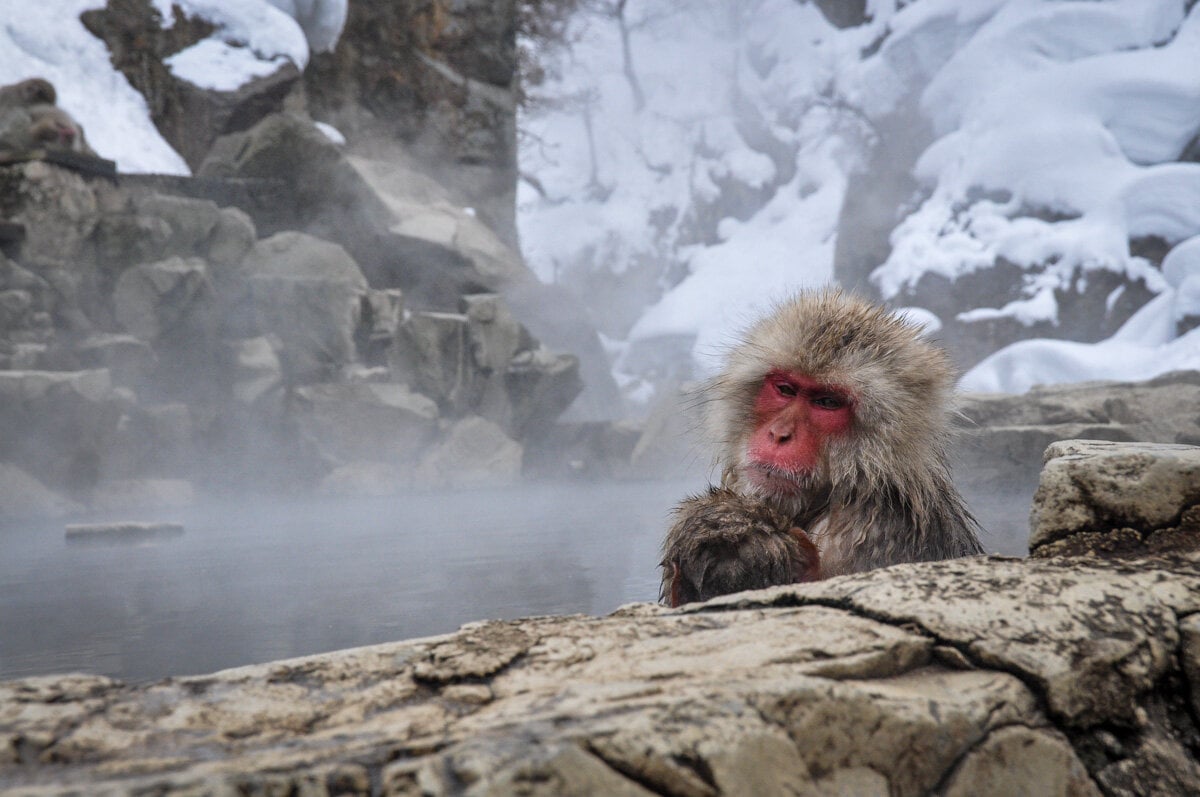
We have a huge list of all the best things to do during winter in Japan , but here are some highlights:
- Go skiing or snowboarding
- Visit traditional villages like Shirakawa-go , which is stunning after a fresh show
- Go to the Sapporo Snow Festival (held for one week in February)
- Soak in an onsen (natural hot spring)
- Fill your belly with hot ramen noodle soup
- See “snow monkeys” at Jigokudani Monkey Park
- View Mount Fuji
- Photograph famous sights with a blanket of snow
- Check out some of Tokyo’s best activities that take place indoors
Best times and places to ski in Japan
- Sapporo: December – March
- Nagano: January – February
Winter is the best season to travel to Japan if…
- …you don’t mind colder temperatures
- …you want to ski or snowboard
- …you want to avoid the crowds
- …you want to save money and travel during off-peak season
What to pack for winter in Japan
- Lots of layers, including a versatile jacket, gloves and a hat
- Warm and comfortable footwear and socks
- Sunglasses (remember, this season has the sunniest days!)
- Hand warmers (you can buy these pretty much everywhere in Japan)
- Ski gear (if needed)
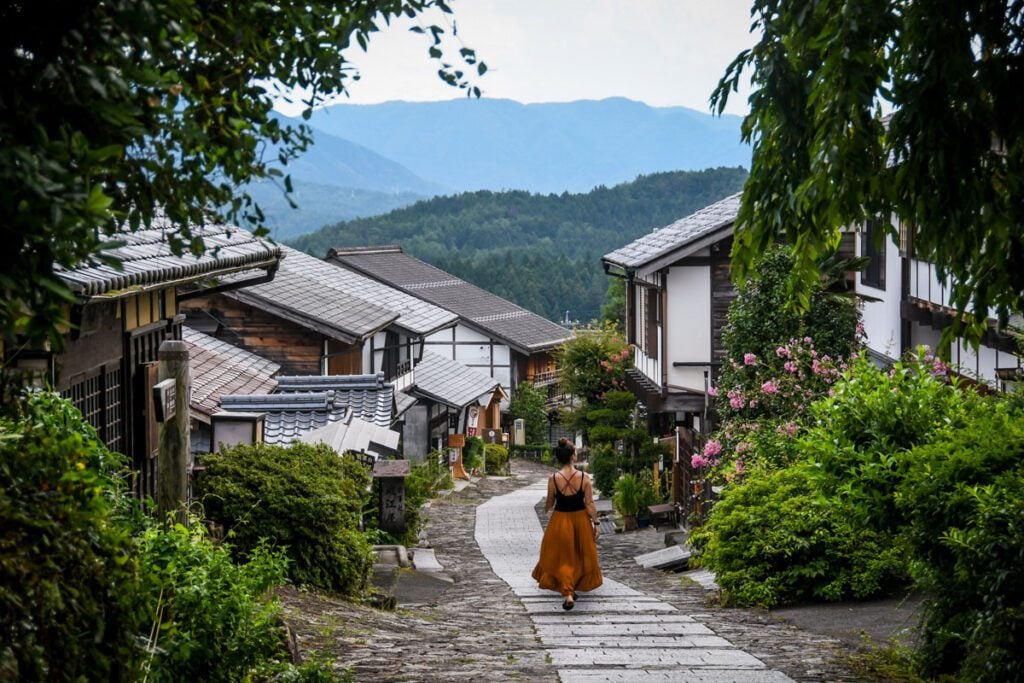
With stunning sakura (cherry blossoms) popping up all around the country and temperatures warming, it should come as no surprise that spring is a popular time to visit Japan. A very popular time, indeed.
If you travel to Japan in the spring, you’ll be rewarded with comfortable temperatures, beautiful blossoms, and crowds .
- When is spring in Japan? From March – May
- Typical weather in Japan during the spring: Nice during the day, but chilly at night. Mostly sunny days with a more showers near the end of May.
- Average spring temperatures: 40 ° F – 70 ° F (Tokyo) (4 ° C – 21 ° C)
- comfortable temperatures
- beautiful cherry blossoms
- crowded (make travel plans far in advance!)
- things may be more expensive since it is peak season
What is Golden Week in Japan?
“Golden Week” is a series of four national holidays that all fall within the same week from April 29th – May 5th every year.
- April 29, Showa Day: birthday of Emperor Showa, who ruled the country during World War II.
- May 3, Constitution Day ( Kenpo kinenbi ): called , this is the celebration of the Japanese constitution ratification in 1947.
- May 4, Green Day ( Midori no hi ): similar to Earth Day, this holiday honors the environment.
- Pssst! For everyone else out there wondering why they don’t include young girls in this, there is a “Girls’ Festival” (Hina Matsuri) on March 3rd.
Many Japanese people have holiday from work during this time, so it is a popular time to travel for both international and domestic visitors.
If your trip falls during these dates (or even a bit before and after), you’ll have the unique opportunity to see some celebrations and mingle with lots of Japanese travelers.
But be warned, you should start booking your accommodation well in advance because rooms sell out in popular places, like Kyoto, for example. You’ll also want to reserve seats on trains ahead of your trip, otherwise you’ll be out of luck.
Should you avoid visiting during Golden Week in Japan?
I’m going to be honest, I don’t think we would travel to Japan during Golden Week because of the insane crowds.
If you want to see Cherry Blossom but aren’t excited about the prospect of crowds, we’d urge you to avoid Golden Week, and instead travel to Japan during early March.
When and where can you see cherry blossoms?
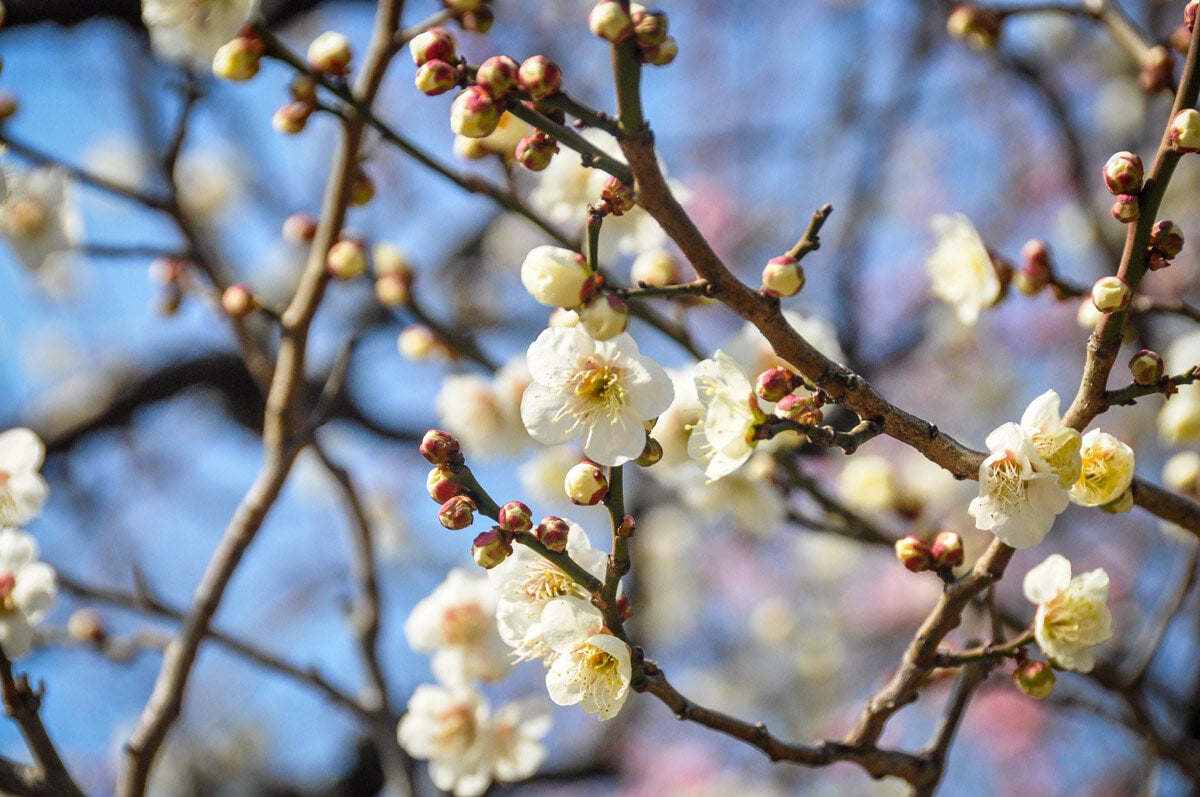
Cherry blossoms are only in bloom for roughly one week per location. They bloom at different times throughout the country, so if you want to extend the length of time you can view them, it’s best to travel south to north so you can see them for a longer period of time.
We have an entire guide to how you can see the cherry blossoms during Spring in Japan , but in short, here are some of the best times to go:
- Fukuoka: Late March – Early April
- Hiroshima: Late March – Early April
- Kyoto: First Week of April (very popular)
- Osaka: First Week of April (very popular)
- Tokyo: Late March – Early April (very popular)
- Kanazawa: 1st – 2nd week in April
- Matsumoto: 2nd- 3rd week in April
- Sapporo: Late April – Early May
Spring months at a glance
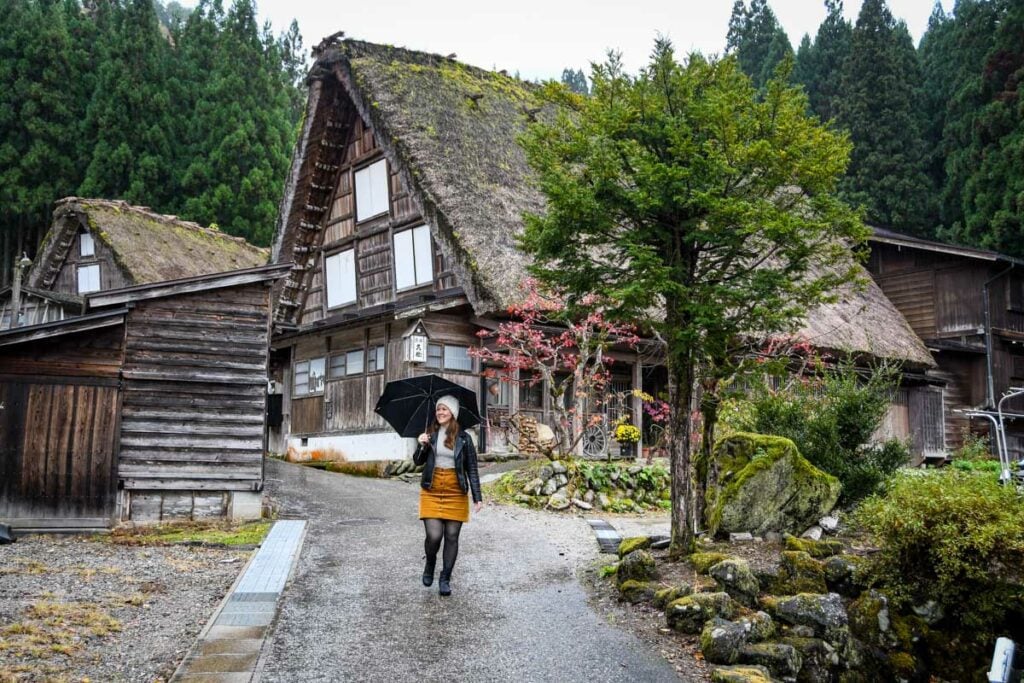
- March: Temperatures are still cool, but it noticeably warms throughout the month. Skiing season in the mountains is starting to wind down, and toward the end of the month the first cherry blossoms start to reveal themselves.
- April: This is the prime month for cherry blossom viewing, though many Japanese people have a whole week off from work (Golden Week), so most major cherry blossom sites will be incredibly crowded.
- May: Very nice weather during the month of May — warm temperatures and sunny skies. Though it is technically the start of typhoon season, strong storms are very rare during the month of May.
Best things to do in the spring in Japan
- Head to Kyoto to photograph sakura (aka cherry blossoms) of course!
- Catch a glimpse of Mount Fuji
- Try some interesting new foods in Japan
- Take a day trip from Osaka to Hiroshima to check out some of the city’s super important historical sites
Spring is the best season to travel if…
- …you don’t mind crowds
- …you want comfortable temperatures (not too cold or too hot)
- …you want to see the famous cherry blossoms
- …you can make your bookings well in advance
- …you don’t mind paying a bit more for hotels and tours during peak season
What to pack for spring in Japan
- Thicker layers if traveling in March
- Light jacket for April and May
- Comfortable walking shoes
- Hiking attire if you plan to hit the trails
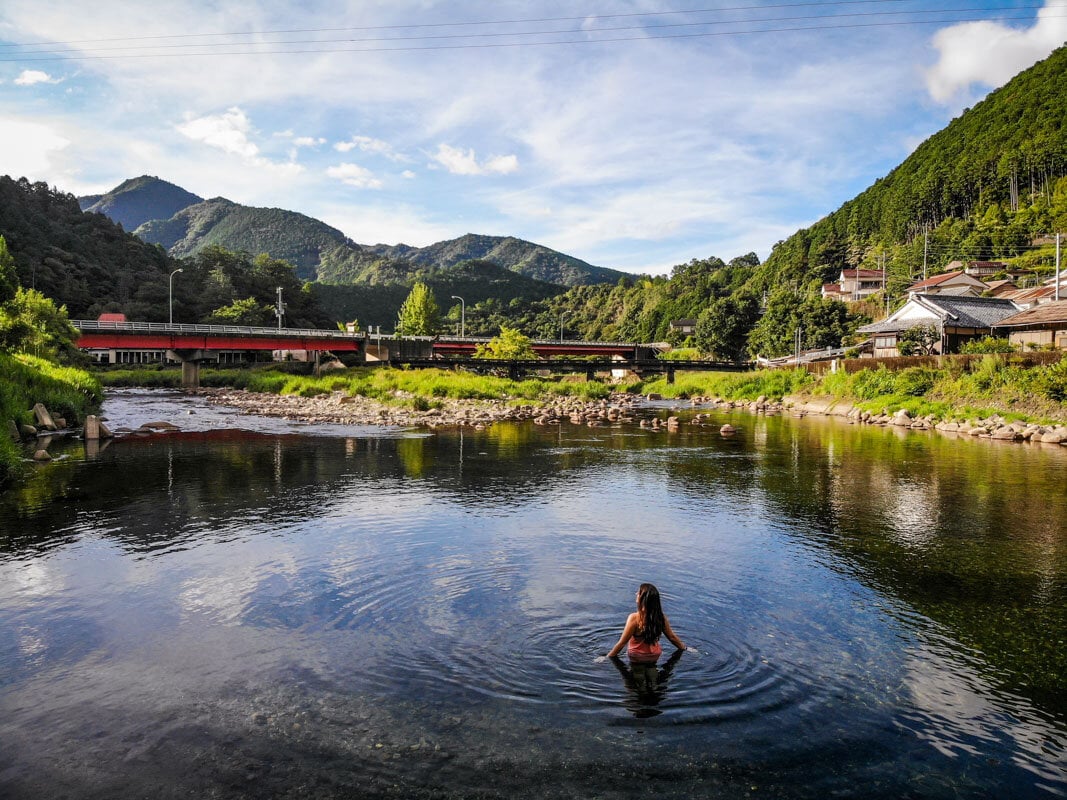
Summer in Japan is the time for festivals and celebrations. The summer spans from June to August, with August being the busiest travel month because school is out and many Japanese people travel over the Obon holiday (August 13-15).
(Unlucky for us, we unknowingly decided to visit Japan for our second time in August…whoops!)
Be prepare on ways to beat the humidity because it can get pretty sticky. Also it’s rainy season and the start of typhoon season, so don’t forget your rain jacket and umbrella
- When is summer in Japan? June – August
- Typical weather in Japan during the summer: Hot, humid, sticky, and rainy. But not as bad as everyone makes it out to be.
- Average summer temperatures: 70 ° F – 90 ° F (Tokyo) (21 ° C – 32 ° C)
- Festivals throughout the country during the summer months
- Prime season for outdoor activities like hiking
- great time to try scuba diving in Japan
- can get very humid
- rain is common at the beginning of summer (June – mid-July), and typhoons are common at the end of summer (August – September)
How bad is the heat in summer, really?
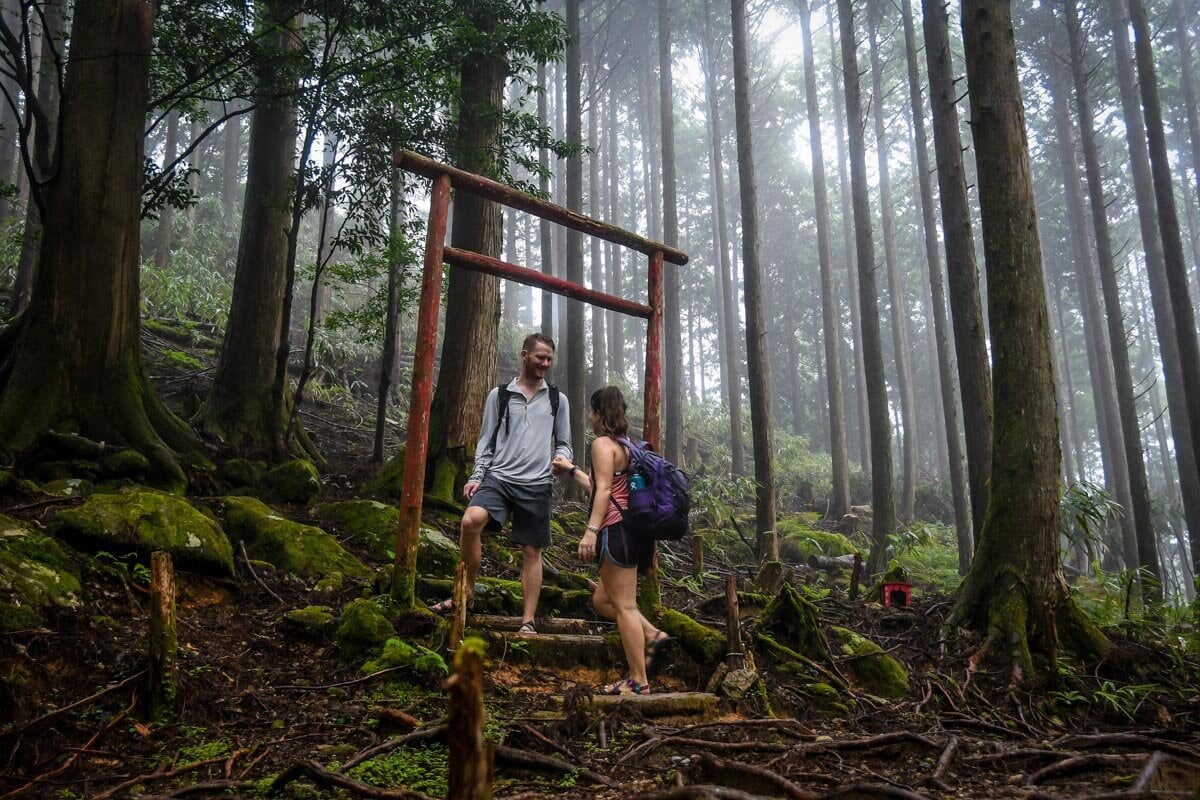
Over the last few years, I’ve realized I don’t handle extreme heat very well. I get tired and crabby much more quickly in the heat. Needless to say, I was very nervous about traveling to Japan during August — the hottest month of the year!
So what was it like?
Well, it did get pretty hot, like 98°F hot (37°C). And it did rain on us a few times but typically it would only last for 20-30 minutes and the rain would stop.
Some days were worse than others. After a rain, for example, it was actually pretty comfortable.
We’ve heard that summer in Tokyo is similar to summer in NYC, hot and humid. And Osaka in summer is similar to Washington D.C. in the summer, which is even more hot and humid.
Knowing what to expect is half the battle , and this way you can prepare yourself for it.
All of our accommodation (even in tiny villages) had strong AC, so we never had an issue with being comfortable at night.
Summer months at a glance
- June: The beginning of the month is quite nice, comparable to the weather in May. However, tsuyu (rainy season) starts around mid-June and last for about a month. It’s not rainy all day but there is a June gloom feeling that hangs around. Temperatures get warmer and the humidity increases as the month progresses.
- July: Starts out rainy because of tsuyu (rainy season), this only lasts until mid-July. Temperatures and humidity continue to rise as this is typically the second hottest month of the year. Great time to see festivals including Kyoto famous Gion Matsuri festival.
- August: The hottest month of the year in Japan. August is a good time to venture into the mountains to escape the heat. Many Japanese have August 13th-15th off because of Obon holiday, so try to avoid this time because it can get busy.
Best things to do in the summer in Japan
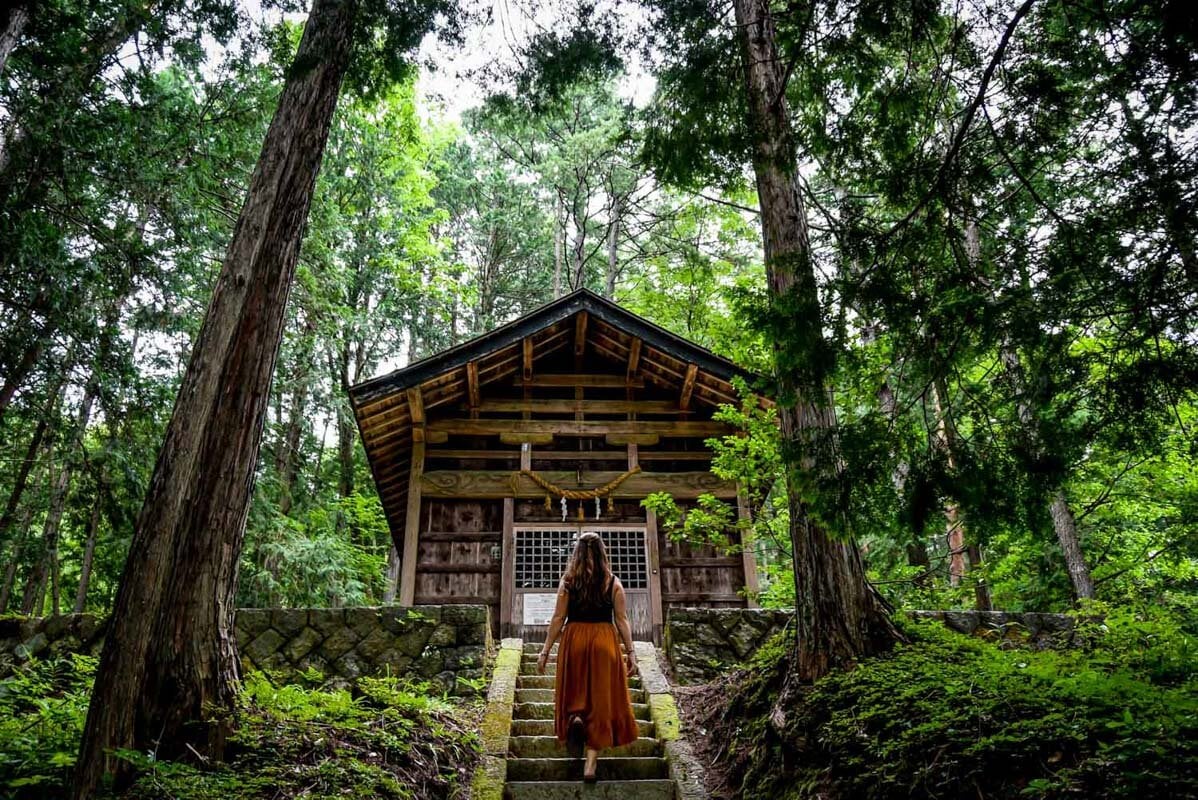
We have another guide to things to do during summer in Japan , but here are some top recommendations:
- Check out Tokyo’s digital art museum on a day that’s too hot or rainy to be outside
- Enjoy festivals including Kyoto’s Gion Matsuri and Osaka’s Tenjin Matsuri
- Go hiking through the Japanese Alps or venture up to Hokkaido
- Scuba diving (apparently the diving is actually really good in Japan!)
- Head to the beach
- Watch a baseball game
Ever thought of going scuba diving in Japan ? Being an island nation, the diving in Japan is actually quite good, and being an off the radar scuba destinations means less crowded dive sites! If you are visiting Japan in the summer time, you’ll have the best conditions for diving all over the country.
Summer is the best season to travel if…
- …you don’t mind humidity and a bit of rain
- …you like outdoor activities like hiking and biking
- …you want to experience cultural festivals
What to pack for summer in Japan
- Anti-chafing cream
- Hand-held fan (you can buy these all over and they make a nice Japanese souvenir )
- Deodorant, finding quality deodorant in Japan is very difficult (we switched to natural deodorant several years ago and will never go back!)
- Light, loose clothing that wicks sweat
- Umbrella for rain and shade
Fall in Japan
With typhoon season peaking at the beginning of September, the start of fall in Japan is typically rainy depending on where you are. However, the weather starts to clear up in October and by November the leaves are changing.
We visited Japan in November 2023 and put together this guide to autumn in Japan that’s full of useful info.
- When is autumn in Japan? September – November
- Typical weather in Japan during the autumn: Rainy in September and beginning of October because of typhoon season
- Average autumn temperatures: 50 ° F – 80 ° F (Tokyo) (10 ° C – 27 ° C)
- nice temperatures
- beautiful fall foliage in countryside
- September can be a pretty humid and rainy month, but it starts to get better in October
When can you see fall foliage in Japan?
The colorful leaves peak a bit later than other places in the Northern Hemisphere, like North America and Europe. The best display of autumn colors can typically be seen toward the end of November and even through the beginning of December.
You can find past and current reports of fall foliage here .
Autumn months at a glance
- September: peak of typhoon season in the southern prefectures, there can be airport and train delays. But it is the month with the least amount of visitors so it will be less busy.
- October: rainy in the beginning of the month but the temperatures start to drop making going outside more manageable.
- November: cool, crisp and dry time of year. Autumn foliage peaks near the end of November
Best things to do during the fall in Japan
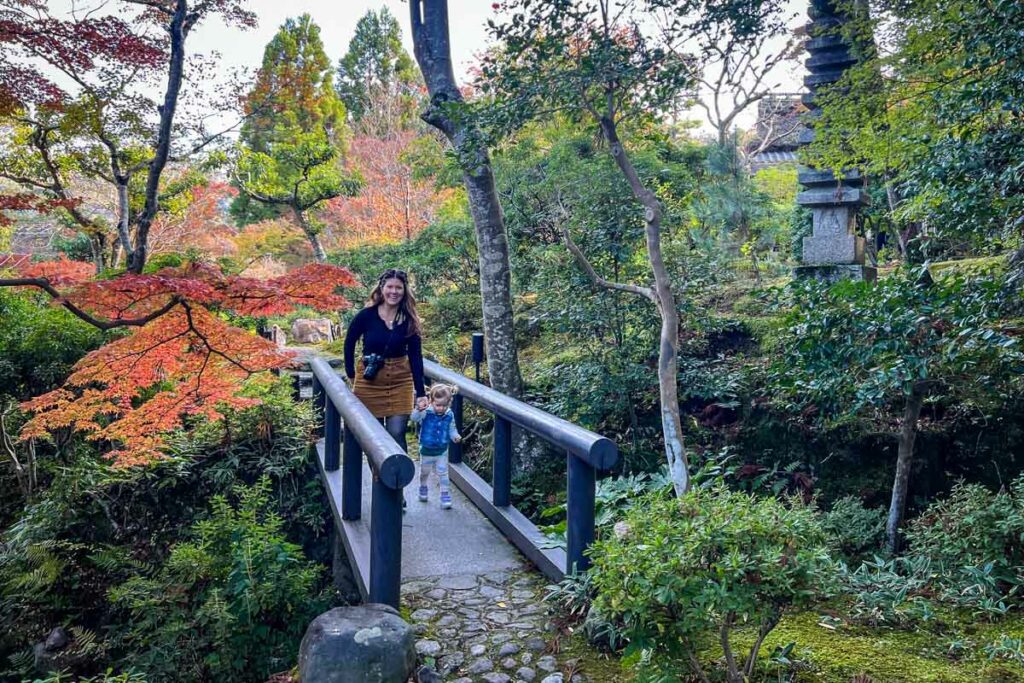
- Hike the Kumano Kodo Pilgrimage Trail
- Sneak some views of Mount Fuji
- See the fall foliage on the Tateyama Kurobe Alpine Route
- Eat sweet treats like deep fried maple leaves in Minoo Park
- Travel to Osaka for leaf peeping in the parks
Autumn is the best season to travel if…
- …you are seeking comfortable temperatures
- …you would like to see (and photograph!) fall foliage
- …you want to explore the major cities
- …you like to avoid crowds
- …you enjoy cool and crisp air
What to pack for fall in Japan
- Umbrella just in case it rains
- Light jacket for November
Holidays & festivals in Japan
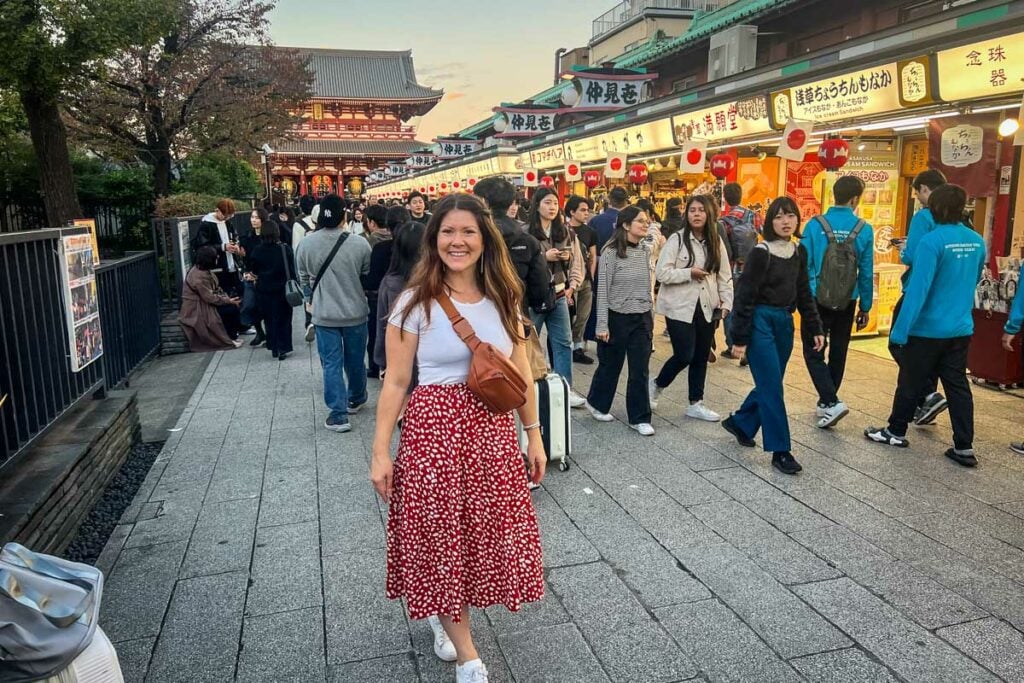
It’s a good idea to check the calendar before booking your flight to Japan, as there are many national holidays that can affect your travels.
Some of these festivals will be fun to observe, but they can also mean trains book up quickly and hotels mark up their rates for peak times.
Here are some of the (not all!) big holiday dates to know:
- January 1: New Year’s Day (people often travel on the days before and after)
- February 11: Foundation Day
- Around March 20 – 21: Vernal (Spring) Equinox Day
- April 29 – May 5: Golden Week
- 3rd Monday in July: Marine Day
- August 11: Mountain Day
- August 13 – 15 : Obon
- 3rd Monday in September: Respect for the Aged Day
- Around September 22 – 23: Autumn Equinox Day
- October 1: Citizens Day
- 2nd Monday in October: Health and Sports Day
- November 3: Culture Day
- November 23 : Labor Thanksgiving Day
- December 23: Emperor’s Birthday
Festivals in Japan
In Japan, festivals are called matsuri and they take place all year long. This is a list of some of the more unique festivals in Japan.
- Jan 15: Nozawa Fire Festival , in Nagano, Japan
- Feb 5-12: Sapporo Yuki Matsuri (Snow Festival), Sapporo, Hokkaido
- Late March: Sumo Wrestling Spring Basho , Osaka
- Early June: The Kaiko Kinenbi , Yokohama Port Opening Ceremony (Boat Races)
- July: Shonan Hiratsuka Tanabata Matsuri (Star Festival), Hiratsuka
- Late July: Tenjin Matsuri (Festival of the Gods), Osaka
- October: Warai Festival (Laughing Festival), Wakayama
Best time of year to travel to Japan based on activity
Check the list below to find the activities you’re most interested in doing while in Japan. See what time of year is best to help you decide when to plan your trip.
- Photography: Spring or Fall
- Beating the crowds: Winter
- Hiking: Spring, Summer or Winter
- Skiing/Snowboarding: Winter
- Onsens: Winter, Spring or Fall
- Scuba Diving: Summer
- Beach Hopping: Summer
- Spotting Mount Fuji: Late Fall, Winter, early Spring
- Festivals and Celebrations: All year!
In our opinion…
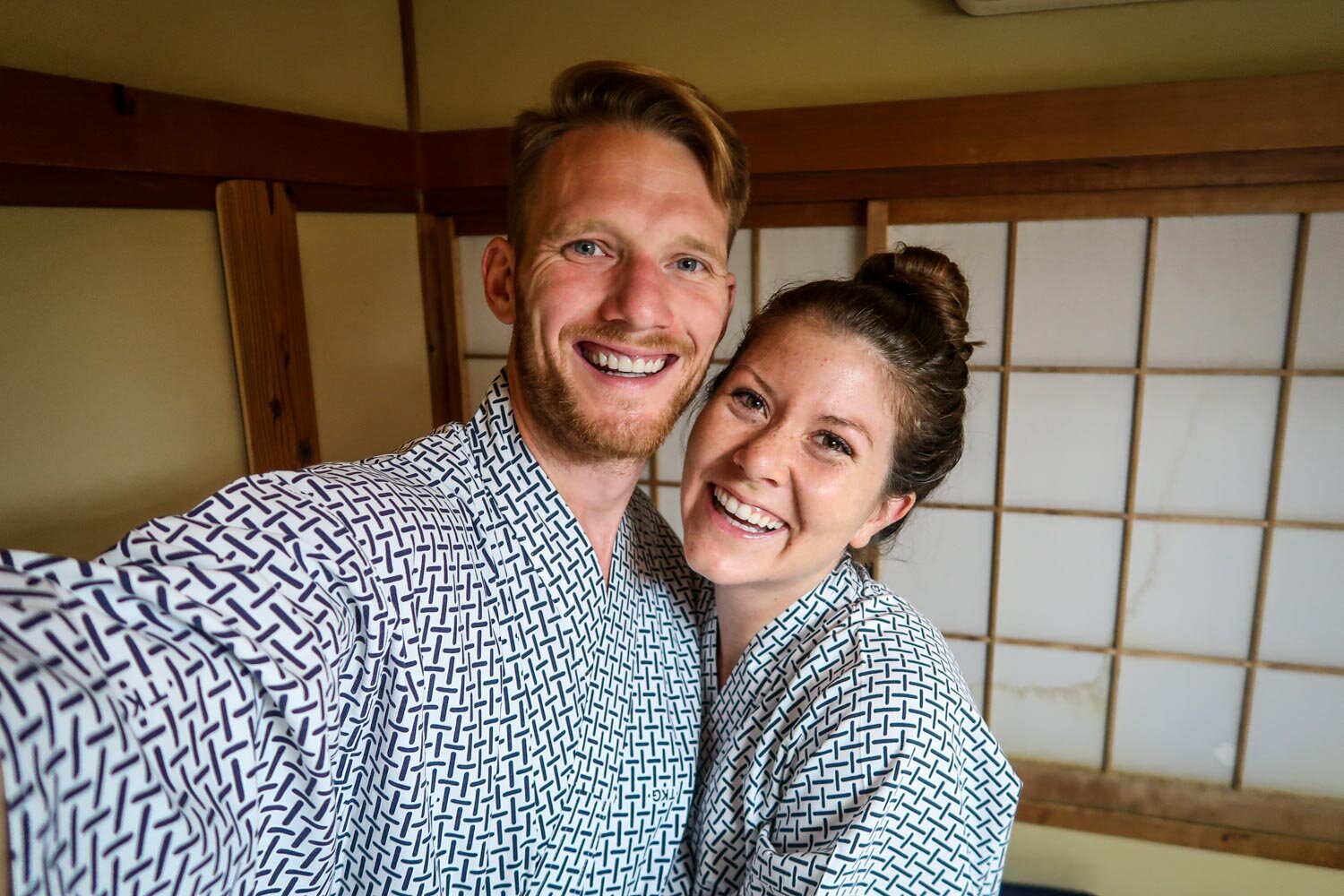
We’ve traveled to Japan in both the summer and the wintertime, and each had its own pros and cons.
Summer was hot and humid—like really humid—so we found ourselves sweating through our shirts daily. But we’ve been in hot and humid climates before, so honestly, it wasn’t anything we hadn’t dealt with before. But still, it wasn’t all that pleasant, and it wouldn’t be our season of choice.
The wintertime was picturesque in the countryside where the snow stuck to the ground. And in the big cities, we actually got many sunny, blue sky days which was a surprise. The cold temperatures made it fun to pop into cozy noodle shops or soak in hot onsens, whereas those activities were not quite so pleasant in the August heat.
We preferred winter over summer, because the crowds were fewer and we’re accustomed to cold weather, so we found it to be quite mild actually.
However, if we were able to choose, we would without a doubt, travel to Japan in the fall: early November, specifically.
November has a smaller chance of rain than October, and more comfortable temperatures than December.
The temperatures will have cooled off from the crazy summer humidity, yet it wouldn’t be too cold for hiking. It wouldn’t have quite the same crazy crowds as cherry blossom season brings. And fall foliage in Japan is something we’ve been dreaming about seeing!
Alternatively, early March would offer the beginnings of cherry blossom season, comfortable weather, and less crowds than those you’ll find late April and early May during Golden Week.
How many days do you need in Japan?
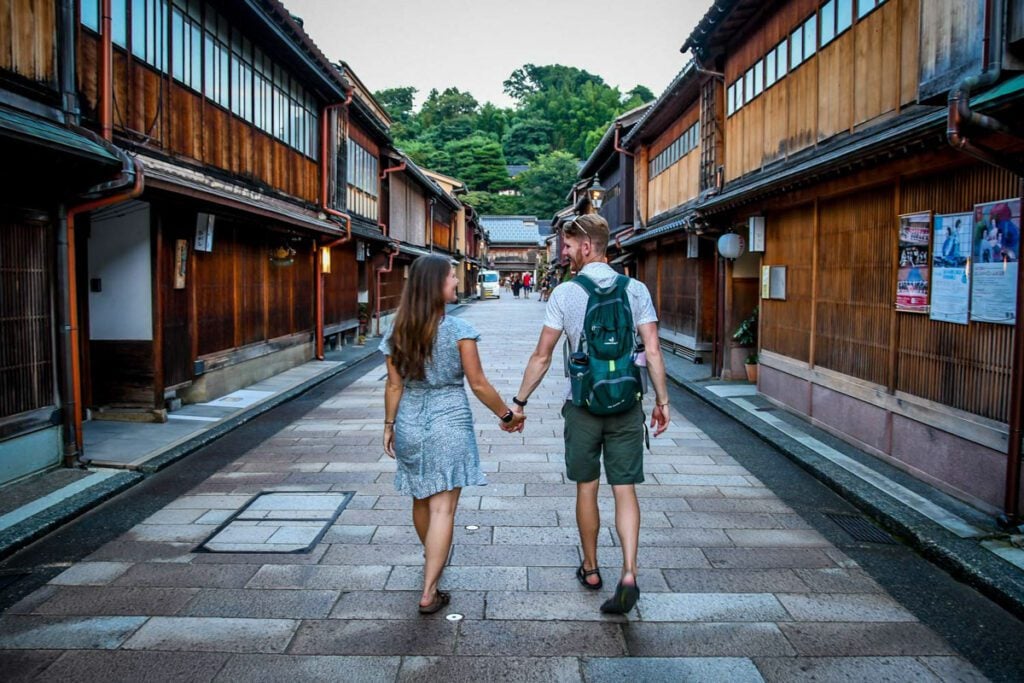
There’s so much to see and do in Japan that it can be overwhelming trying to decide how long your trip should be. Ideally, 2-3 weeks will give you enough time to see iconic and lesser-known sights as well as recover from a long travel day and potentially a big time difference.
But the ideal duration for your trip depends on several factors, including destinations you want to visit and your travel style. Our guide to how many days to spend in Japan will help you figure out how much time you need based on what you want to do.
What to pack for traveling to Japan
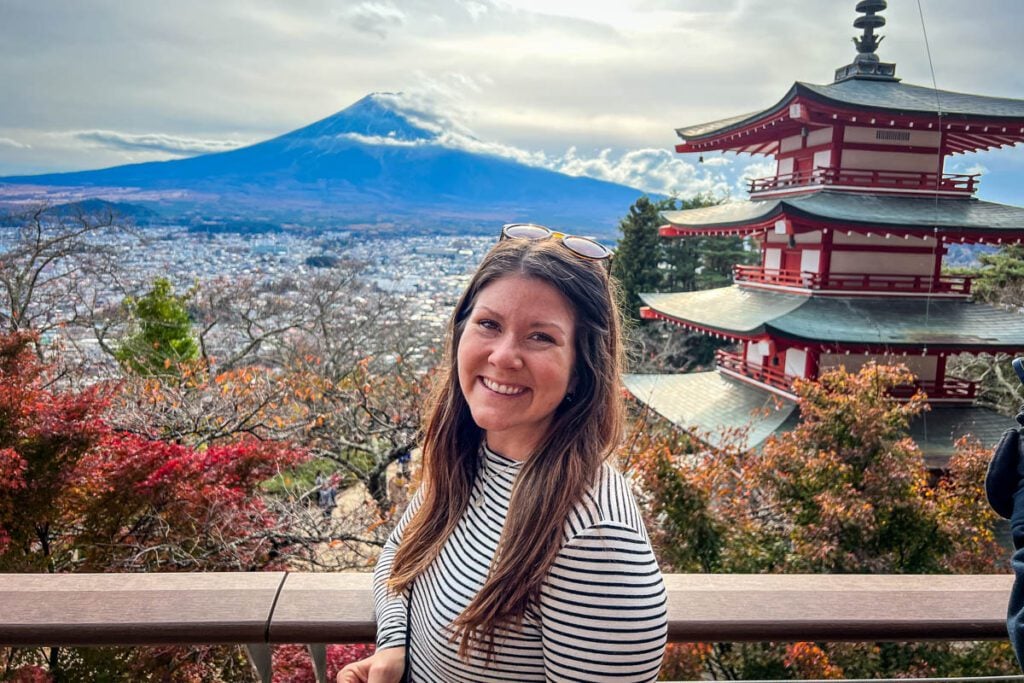
We know it can be overwhelming packing for a trip to a new destination. That’s why we spent hours creating these super helpful guides full of packing hacks and tips for traveling in Japan that you won’t find anywhere else:
- Our Japan packing guide lists all the essentials (many of which you might not think about), as well as what you should NOT pack for a trip to Japan.
- This article on what to wear in Japan will help you create a perfect capsule wardrobe for every season and let you in on some cultural taboos so you can be sure to dress appropriately.
- With this FREE Japan packing list PDF download , we’ll send checklists straight to your inbox for everything from clothing and toiletries (for both women and men!) to what shoes to pack and extra stuff you may want to have on-hand just in case. Click the image below to get your free copy!

More resources for traveling in Japan
We have TONS of resources on travel in Japan and destinations throughout the country. Check out our Ultimate Japan Travel Guide for all the answers to your most burning questions, or read some of our favorite articles below!
- Japan Rail Pass: Where to Buy & Is It Worthwhile?
- Trip to Japan Cost: Tips for Budget Travel in Japan
- Japan Pocket Wifi vs. Japanese SIM Card: Review & Comparison
- Best Japan Travel Apps
- Expert Tips for Visiting Japan (Dos & Don’ts!)
- Ultimate Japan Travel Guide: Everything You Need to Know for Your First Trip to Japan
- Helpful Japanese Words & Phrases to Know for Traveling in Japan
Save this article to Pinterest for later!
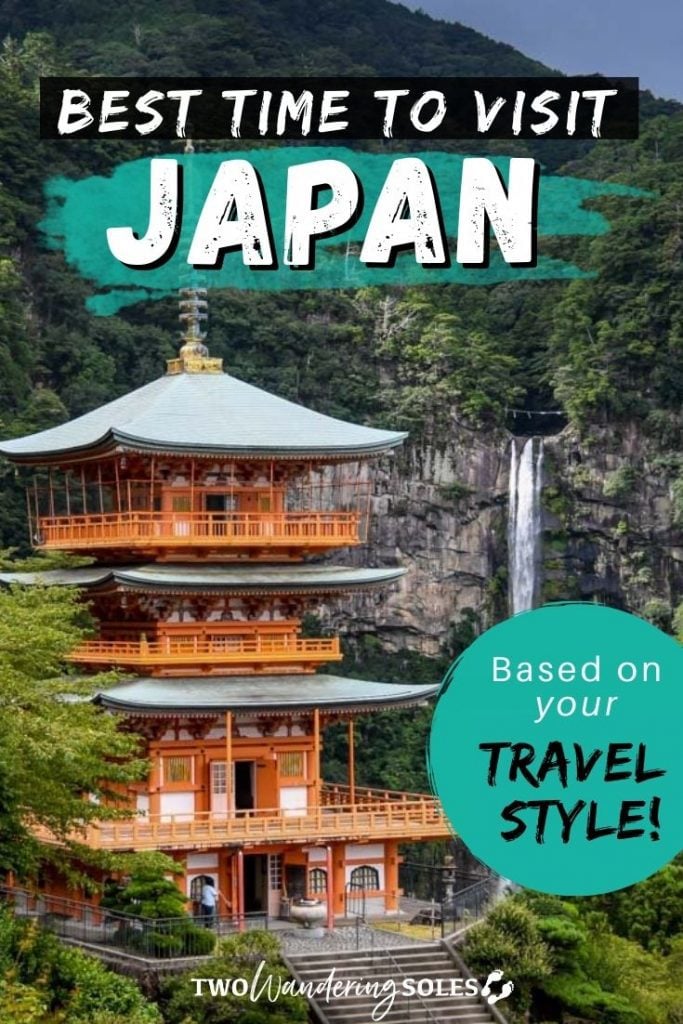
We’d love to hear from you!
What season sounds best to you? Why? Do you have any more questions after reading this article? We’ll try our best to bet back to you!
Comments (11) on “ Best Time to Visit Japan: When to Go & When to Avoid! ”
Such a nice article. Thanks for sharing
Thanks, buddy, I really want to visit Japan, and your post makes me more excited about the Japan tour
Thank you so much!! Love the recommendations and help!! Will Use this to Plan my trip
It was a nice post. Pictures were overwhelming !!!!!!
I want to travels Japan
Thanks for sharing
Awesome tips! 👌 My question would be, is there any pro or cons going the last week in May to beginning of June. Looking at 2 weeks. Fukuoka & Tokyo. 😊 TIA!
Did you end up going during that time? We’re going this year in that exact time; late My early June for two weeks.
Want to visit Japan for a conducted tour of 15 days and am thinking of mid September to early October.
Very well article. Thank you very much. This is the first article I read for the trip we are planning. The details were amazing. 🙂
Where was the picture under “summer months at a glance” (with Katie walking up the steps) taken? It’s absolutely beautiful, and I’d love to go there when I visit!
At first, all your pictures are Wonderful. Nice interpretation?
Leave a Reply Cancel reply
Your email address will not be published. Required fields are marked *
Save my name, email, and website in this browser for the next time I comment.
- Election 2024
- Entertainment
- Newsletters
- Photography
- Personal Finance
- AP Buyline Personal Finance
- Press Releases
- Israel-Hamas War
- Russia-Ukraine War
- Global elections
- Asia Pacific
- Latin America
- Middle East
- Election Results
- Delegate Tracker
- AP & Elections
- March Madness
- AP Top 25 Poll
- Movie reviews
- Book reviews
- Personal finance
- Financial Markets
- Business Highlights
- Financial wellness
- Artificial Intelligence
- Social Media
Indonesian president-elect vows to further strengthen ties with Japan after visiting China
Indonesian Defense Minister and President-elect Prabowo Subianto, left, is shown the seat for talks by Japanese counterpart Minoru Kihara, right, at the Defense Ministry in Tokyo, Japan, Wednesday, April 3, 2024. (Kimimasa Mayama/Pool Photo via AP)
Indonesian President-elect and current Defense Minister Prabowo Subianto greets journalists as he walks to meet Japan’s Prime Minister Fumio Kishida at the prime minister’s office Wednesday, April 3, 2024, in Tokyo. (AP Photo/Eugene Hoshiko, Pool)
Indonesian President-elect and current Defense Minister Prabowo Subianto, left, and Japan’s Prime Minister Fumio Kishida, right, shake hands at the prime minister’s office Wednesday, April 3, 2024, in Tokyo. (AP Photo/Eugene Hoshiko, Pool)
Indonesian President-elect and current Defense Minister Prabowo Subianto, left, and Japan’s Prime Minister Fumio Kishida, right, meet at the prime minister’s office Wednesday, April 3, 2024, in Tokyo. (AP Photo/Eugene Hoshiko, Pool)
Indonesian Defense Minister and President-elect Prabowo Subianto, left, shakes hands with Japanese counterpart Minoru Kihara, right, at the start of their talk, at the Defense Ministry in Tokyo, Japan, Wednesday, April 3, 2024. (Kimimasa Mayama/Pool Photo via AP)
Indonesian Defense Minister and President-elect Prabowo Subianto, second left, receives the guard of honor with Japanese counterpart Minoru Kihara, second right, at the Defense Ministry in Tokyo, Japan, Wednesday, April 3, 2024. (Kimimasa Mayama/Pool Photo via AP)
- Copy Link copied
TOKYO (AP) — Indonesian President-elect Prabowo Subianto said he wants to “further strengthen” relations with Japan as he met with Japanese Prime Minister Fumio Kishida on Wednesday on the heels of a visit to China.
Subianto, who’s currently defense minister, told Kishida that the two countries are longtime friends who have built a cooperative relationship, and that he hoped to further strengthen the relationship.
Japan has been seeking closer ties with Southeast Asian countries, especially in maritime security and defense, in the face of China’s increasingly assertive military presence.
Subianto, who will succeed Joko Widodo in October, chose Beijing for his first official overseas trip after his February election victory in a bid to emphasize steady ties with China amid rising tensions in the South China Sea, where China and the Philippines have had repeated high-seas confrontations. In his meeting with Chinese President Xi Jinping, Subianto pledged a continued friendly policy toward China.
China is Indonesia’s largest trading partner, with Beijing investing in major infrastructure projects, and Indonesia has maintained a relatively neutral stance amid rising tensions between China and the Philippines over rival territorial claims in the South China Sea.
Kishida welcomed Subianto’s early visit to Tokyo, telling his future counterpart that the two countries are longtime friends that share basic values and principles, and that Japan hoped to further strengthen cooperation in regional and global issues as “comprehensive and strategic partners.”
Kishida said Japan hopes to contribute to Indonesia’s development in areas including infrastructure and energy, while stepping up cooperation in security and defense.
Kishida’s meeting with Subianto comes just a week before the Japanese leader will travel to Washington for a summit with U.S. President Joe Biden, and three-way talks that will also include Philippine President Ferdinand Marcos Jr., at which the leaders are expected to discuss further reinforcing security ties.
Later Wednesday, Subianto held talks with Japanese Defense Minister Minoru Kihara. The two ministers vowed to enhance defense cooperation, the Japanese Defense Ministry said in a statement.
Japan and Indonesia are expanding joint exercises in the Indo-Pacific region, as well as capacity building and educational programs, Kihara told reporters after the talks.
“I’m determined to strengthen cooperation between our two maritime nations to achieve a free and open Indo-Pacific based on the rule of law,” he said.
Associated Press video journalist Ayaka McGill contributed to this report.
Programs submenu
Regions submenu, topics submenu, the state of governance and rule of law in uganda, building trust in nuclear diplomacy, advancing u.s.-canada life sciences cooperation.
- Abshire-Inamori Leadership Academy
- Aerospace Security Project
- Africa Program
- Americas Program
- Arleigh A. Burke Chair in Strategy
- Asia Maritime Transparency Initiative
- Asia Program
- Australia Chair
- Brzezinski Chair in Global Security and Geostrategy
- Brzezinski Institute on Geostrategy
- Chair in U.S.-India Policy Studies
- China Power Project
- Chinese Business and Economics
- Defending Democratic Institutions
- Defense-Industrial Initiatives Group
- Defense 360
- Defense Budget Analysis
- Diversity and Leadership in International Affairs Project
- Economics Program
- Emeritus Chair in Strategy
- Energy Security and Climate Change Program
- Europe, Russia, and Eurasia Program
- Freeman Chair in China Studies
- Futures Lab
- Geoeconomic Council of Advisers
- Global Food and Water Security Program
- Global Health Policy Center
- Hess Center for New Frontiers
- Human Rights Initiative
- Humanitarian Agenda
- Intelligence, National Security, and Technology Program
- International Security Program
- Japan Chair
- Kissinger Chair
- Korea Chair
- Langone Chair in American Leadership
- Middle East Program
- Missile Defense Project
- Project on Fragility and Mobility
- Project on Nuclear Issues
- Project on Prosperity and Development
- Project on Trade and Technology
- Renewing American Innovation Project
- Scholl Chair in International Business
- Smart Women, Smart Power
- Southeast Asia Program
- Stephenson Ocean Security Project
- Strategic Technologies Program
- Transnational Threats Project
- Wadhwani Center for AI and Advanced Technologies
- All Regions
- Australia, New Zealand & Pacific
- Middle East
- Russia and Eurasia
- American Innovation
- Civic Education
- Climate Change
- Cybersecurity
- Defense Budget and Acquisition
- Defense and Security
- Energy and Sustainability
- Food Security
- Gender and International Security
- Geopolitics
- Global Health
- Human Rights
- Humanitarian Assistance
- Intelligence
- International Development
- Maritime Issues and Oceans
- Missile Defense
- Nuclear Issues
- Transnational Threats
- Water Security
Previewing the Japanese Official Visit and Trilateral Leaders’ Summit

Photo: STAN HONDA/AFP via Getty Images
Transcript — April 2, 2024
Available Downloads
- Download the Transcript 236kb
This transcript is from a CSIS press briefing hosted on April 2, 2024.
Alex Kisling: Brad, thanks so much. And hello, everybody, and welcome to the CSIS press briefing previewing next week’s official visit to the United States by Japanese Prime Minister Kishida, as well as the trilateral leaders’ summit between the United States, Japan, and the Philippines. We have a terrific lineup of CSIS experts joining the call today to share their perspectives on the context, significance, and political backdrop of the official visit and the trilateral summit.
Just a couple of housekeeping notes before we get started. Each of our speakers will offer a few minutes of introductory remarks, after which we’ll turn to your questions. We’ll also be distributing a transcript of today’s call to all participants in the next few hours, and a transcript will be made available on CSIS.org later today.
So, with that, why don’t we go ahead and get started? I’ll turn first to Dr. Victor Cha, senior vice president for Asia and the Korea chair here at CSIS. Victor over to you.
Victor Cha: Great. Thank you very much, Alex. Thank you, everyone, for joining us today to discuss the state visit of Prime Minister Kishida Japan, the trilateral summit with President Marcos, as well as the bilateral meeting between President Marcos and President Biden on April 10th and April 11th.
This is really a first in its own right, I think, and reflects the success in the way the administration has networked its bilateral alliances into these minilaterals to deal with issues like economic security, freedom of navigation, and a challenging security environment in the region. So just with a little bit of history, as you all know, the U.S. alliance network, when it started out –when it was built by people like John Foster Dulles at the end of the Second World War and the beginning of the Cold War, was envisioned as a set of exclusive security partnerships. If we use geometry, there were bilateral line segments, if you will, with each partner in Asia.
But what we have really seen, and we see it with this upcoming bilateral next week, is a flourishing of these many different shapes – pyramids, trilaterals, quadrilaterals. You’re all familiar with them, things like AUKUS, Camp David, IPEF, and others. And I – you know, I want to note at the beginning, that this is really unique – a unique phenomenon in the history of alliances, as we see states in the Indo-Pacific responding to the uncertainty and concerns that have been created by China’s assertive behavior in the region, on the sea and in the air, economic coercion.
Of course, this doesn’t mean that all countries are ready to sign up to some sort of strangulation of China, as Beijing has recently described it. But it does mean that countries are defining it as in their long-term interests to be a part – to welcome and to be a part of the U.S. commitment to the region, and they’re receptive to new ways to cooperate with the Biden administration, as we’re seeing on everything from the South China Sea to economic coercion to the Taiwan Strait.
Finally, I think it’s important to note that in this networking of the or mini-lateralizing of the American alliance system in Asia, the U.S.-Japan alliance really is the hub or the core of this effort. You see – what you have is the U.S.-Japan alliance as the core, and what you see is branching off and pulling in others for different forms of trilateral. So in Northeast Asia, it pulls in the South Koreans. In Southeast Asia, it’s pulling in the Philippines. In the South Pacific, it’s pulling in Australia. In the Taiwan Strait, obviously it’s pulling in Japan.
So the U.S.-Japan alliance really is sort of the core of this mini-lateral exercise. And so I think it’s appropriate that we start by talking with – about the U.S.-Japan alliance in the state visit next week with Chris.
So back to you, Alex.
Mr. Kisling: Victor, thank you.
We’ll turn next to Christopher Johnstone, CSIS senior adviser and our Japan chair. Chris, over to you.
Christopher B. Johnstone: OK, thanks, Alex. And thanks to everyone for joining this morning. Great to be here.
I’m going to focus a bit on the bilateral meetings with Prime Minister Kishida and leave the discussion of the Philippines component to my colleague Greg Poling.
But the first point to make, this is the first official visit by a Japanese leader since Prime Minister Abe in 2015. It’s called an official visit. It’s really the same thing as a state visit. The only difference is that Kishida is not technically the head of state in Japan. He’s the head of government. And so they call it an official visit. But the trappings are all basically the same.
It’s the highest diplomatic honor that can be accorded to a counterpart. These are rare; really only usually one or two a year. And for Biden, what this does by inviting Kishida, it rounds out the Quad. Now all members of the Quad have had a state visit to the White House, along with the president of South Korea; so a very heavy Indo-Pacific focus in these kinds of visits.
For Kishida, in addition to the visit to the White House, he’ll be giving a speech to the Congress on April 11th. He’ll be traveling to North Carolina, where he will visit, it’s said, a prospective Toyota investment in an EV battery plant. And then the trilateral meeting will take place on the 11th as well.
And for President Biden, this is, of course, a chance to highlight and cement progress in the relationship, the most important bilateral alliance in the Indo-Pacific, as Victor had said. It’s a chance to sustain urgency and momentum in this relationship.
For Kishida, it’s a chance to showcase his ties to the U.S., to prop up support at home. Nick will talk about this more a bit later. He does face some domestic political challenges. And it’s also a chance for Kishida to speak to a bipartisan audience in the United States in the form of this speech to Congress, because, like many partners, Tokyo is a bit nervous about the trajectory of politics in the United States.
So for this White House and from a U.S. perspective, this visit reflects the view that the relationship with Japan is in a period of historic strength. And Kishida himself has been an important leader and partner. And frankly, this was not particularly expected when he first came to office in 2021.
Since he took office, Japan has done a number of significant things that I think this visit will highlight – historic national-security and national-defense strategies that they released in 2022, which reflected a very strong focus on China, strong focus on strengthening the United States – relations with the United States, and a strong focus on strengthening Japan’s own defense capacity, to include increasing defense spending to 2 percent of GDP, investing in new capabilities, and a host of other steps that previous prime ministers, including Prime Minister Abe, were not able to deliver. Kishida did. And, in fact, defense spending is up in Japan 50 percent over the last two years.
Kishida has been a strong supporter on Ukraine, also something that was not necessarily expected. Prime Minister Abe had a history of seeking to engage President Putin. That was at times a source of friction with Washington.
Kishida has taken a much more clear stance in support of the West, the G-7, and responding to the invasion, and Kishida was an effective steward last year of the G-7 process, driving a focus on economic security, responding to economic coercion, promoting cooperation on technology.
And there are other issues as well where I think from this White House’s perspective Kishida has been important – the breakthrough in ties with South Korea, which although I think it’s fair to say is – more credit is deserved by President Yoon than Kishida but still nonetheless he’s helped to build on this opportunity.
So a broad strong sense of alignment but I also think a need to sustain a sense of urgency on progress as politics in both countries, in both Japan and the United States, become more complicated.
So I think – let me say a few words about deliverables before I hand it back. I think the deliverables of this meeting will reflect sort of a combination of consolidation and operationalization. Less a focus on grand statements of intent, more a focus on the specifics of execution locking in progress, institutionalizing progress, translating strategic alignment into concrete action.
And I expect to see things centered in a handful of buckets. The first and the biggest bucket will be defense. I expect that you will see a statement of intent to modernize the command and control architecture of the alliance to the move toward modernizing the structure and authorities of the U.S. command structure in Japan and moving to a new structure of interaction with Japan with a new operational command that’s been established in Japan.
So this will take us in the direction of a much more true military alliance than we’ve had before in the U.S.-Japan context. The summit, I expect, will point a direction. Won’t set out the specifics of a vision but will point a direction in the handoff to the Department of Defense to put the meat on those bones.
Then I think you’ll see other concrete steps to strengthen what I would call the credibility of the alliance, a pilot training initiative, for example, that will be quite significant in strengthening air power cooperation.
You’ll see a host of things related to defense industry cooperation, some co-production equipment – of defense equipment to, perhaps, include air defense missiles in particular, an announcement related to the maintenance and repair of U.S. equipment in Japan so that we don’t have to bring some of that equipment back to the United States – that work could be done in Japan – and the announcement of a new defense industrial policy coordination forum that will be intended to drive cooperation on specific capabilities. So I think a pretty substantive agenda on defense will be announced.
A second area that my colleague Kari will discuss in more detail relates to space. There’s deep and expanding cooperation in both the civilian and the defense side. I think you’ll see some announcements related to the Artemis Moon landing campaign, perhaps the announcement of a contribution by Japan of the lunar rover vehicle, and they will likely say something about Japanese astronauts being at least among the first international partners to land on the Moon as part of the Artemis effort.
A third will be a host of initiatives related to technology – AI, quantum, climate change and clean energy – a discussion of coordination of policy related to tech promotion and tech protection, obviously, a central issue in the alliance these days. And, again, one of the big highlights will be this visit by Kishida to the EV battery plant in North Carolina, which will be a significant investment and employ, of course, a number of Americans.
And then there will be – I think a couple of other buckets will be global development and diplomacy and people-to-people ties where I expect to see things like an announcement of Japanese investment in undersea cable, for example, in the Indo-Pacific region.
I’ll close by noting one issue you will not see addressed in the announcements and that’s Nippon Steel – the prospective Nippon Steel acquisition of U.S. Steel. The leaders will seek to sidestep it, at least publicly, and not talk about it unless they have to. But it certainly does loom in the background. And I think it’s fair to say that it symbolizes for Japan both some of the tension in the Biden administration’s foreign policy, and some of the issues on the minds of many partners about the trend lines in American politics.
So let me – let me stop there and return it back to Alex. And I’m sure we can talk more in the Q&A. Thanks.
Mr. Kisling: Chris, thank you.
We’ll turn next to Kari Bingen, director of the CSIS Aerospace Security Project and our senior fellow with the International Security Program. Kari, over to you.
Kari A. Bingen: Great. Thanks, Alex. And thanks, everyone, for being here this morning.
So space is one of those new or expanded ways of cooperating and further building a deeper relationship, as both Victor and Chris have highlighted. It is becoming even more prominent in the relationship. And there are a few areas of focus and investment that I’d like to highlight. So while there has been a longstanding JAXA-NASA civilian space relationship and deep cooperation over decades, we’re also seeing a new focus on space security and how space capabilities aid national security and defense. And this is significant, and really came out of the 2022 security and defense strategy that Chris highlighted. This emphasis on space security is driven by the security environment – China’s military buildup, North Korea’s unprecedented missile launches, and then Russia’s invasion of Ukraine, which could presage what aggression in the region would look like.
Tokyo also sees the economic and technology benefits of space. It helps to spur private sector innovation and attract technical talent. And space has become an agenda item, specifically in these high-level discussions. So last January when President Biden and Prime Minister Kishida met, they agreed – they inked a bilateral space agreement which covered cooperation on space exploration, but also discussed the need to better align our force postures in the space domain. For eight successive times, there has been a comprehensive bilateral dialogue bringing together space leadership across our U.S. interagency, as well as Japanese counterparts. And for the first time last year, they held a track 1.5, which brought together both governments and both business communities as well. So we’re also seeing increased investment going into space, both on the civilian and the security side.
So across both civil and security space, I’ll be looking for announcements or emphasis in three areas. And Chris touched on this a bit, so I’ll expand here. The first area, I would say, would be in astronauts and Artemis. So Japan would like to see a Japanese astronaut land on the Moon as one of the first non-American international delegations in the late 2020s. So I’ll be listening for any announcements on further contributions to the Artemis Program that Japan would make, as well as that possible announcement of a Japanese astronaut being part of a future Artemis mission to land on the Moon, and possibly the first international mission.
The second area would be in missile warning and missile defense. I mentioned, the missile threat is acute for them. China and then North Korea in particular, both are not only building their missile inventories but also advancing more sophisticated missiles that can maneuver. The hypersonic glide vehicle, the HGV, is a significant concern. So you need space to be able to access those denied areas or those deep in country launch sites and understand what’s going on. Space provides large coverage areas and good geometry to be able to detect and track missile launchers and missile trajectories, particularly these advanced missiles like hypersonic vehicles.
So I’ll be looking for announcements on further collaboration in the areas of missile warning and missile defense, specifically to address that HGV, or hypersonic glide vehicle, threat. And then possibly further cooperation on actual satellite architectures or satellite constellations, and potentially industry cooperation. And then lastly, I’ll be looking for announcements related to greater data sharing and experimentation. So this could be greater sharing on the threat picture, and then both sides are interested in more, I’ll say, operational-level data sharing and analysis.
So I’ll pause and turn it back over to Alex.
Mr. Kisling: Thank you, Kari.
Before we turn to our next speaker, just a reminder that if you want to ask a question, please press one and then zero. We have a couple speakers left, but after that we will turn to your questions and answer them as best we can.
So our next speaker is Nicholas Szechenyi, senior fellow with the CSIS Japan Chair and our deputy director for Asia. Nick, over to you.
Nicholas Szechenyi: Thanks, Alex. And it’s a pleasure to be with you all today.
I’m going to focus my remarks on the political backdrop to the official visit, and I’ll start with Kishida. Chris mentioned that Prime Minister Kishida is facing some political headwinds at home. His approval rating has lingered in the 20 percent range for the last several months due primarily to a funding scandal in the ruling Liberal Democratic Party, which he leads, which has proved rather embarrassing and is really dominating the domestic political debate in Japan. He also faces three by-elections for the Diet, or the parliament, at the end of April, so political observers are keeping a close eye on that to see how LDP candidates fare. And then, as leader of the LDP, Kishida needs to run again. There’s a leadership race for president of the ruling party in September. And in addition, there are rumors floating around consistently about whether Kishida might call a snap election at some point prior to September to generate some momentum ahead of that race.
So, on the domestic political front, Kishida is on the defensive. And so this visit to Washington is extremely important because it – for any Japanese leader, but in this political context especially because he wants to show as the leader of Japan that the U.S.-Japan alliance is strong, and that Japan is a leader regionally and globally. And the hope is that this will help him generate some momentum when he returns home to face the very challenging political calendar.
There’s also a political backdrop to the – to the official visit on the U.S. side, which has already been referenced – primarily, President Biden’s comment in mid-March on Nippon Steel’s proposed acquisition of U.S. Steel. I think Japan has a very sophisticated understanding of U.S. politics and understands that this is a domestic political issue, and the Kishida administration has largely refrained from comment and, not surprisingly, is stressing the strength of the U.S.-Japan relationship and all the progress that has been made in various areas that have already been highlighted by my colleagues.
And I agree with Chris Johnstone that the two leaders will not want to address the Nippon Steel issue, but I think the timing of President Biden’s comments were pretty bad leading up to this official visit. And it could create an awkward dynamic where Kishida, for example, could be asked to comment on Nippon Steel, and President Biden could be asked, you know, whether Japanese investment is in the U.S. national interest or whether Japanese investment is a threat to U.S. national security. And this is unfortunate because it would – it would really be devastating if a domestic political issue like Nippon Steel ends up overshadowing the strategic importance of the U.S.-Japan relationship which this official visit is meant to convey. But we’ll just have to see what plays out on that front.
Lastly, you know, can’t comment on this visit without noting that Japan is very keenly watching the U.S. presidential campaign. The comment or the question that we hear frequently from Japanese interlocutors is, what if Trump wins – or, “moshitora” in Japanese. (Laughs.) And I would say that, you know, in 2016, when Abe Shinzo was prime minister, after the election he brought a message to the U.S., which was simply that Japan is an ally that is stepping up. That was a very effective message. And he developed a personal connection with President Trump, which helped bolster U.S.-Japan ties and sustain momentum in the relationship.
I think Japan’s message this time is exactly the same and even more compelling, given everything Kishida has done to bolster Japan’s strategic and diplomatic weight. So looking ahead to next year, the message Japan will bring to Washington will be clear. Japan is stepping up. But what isn’t clear is who Japan’s messenger will be. And that could be a factor if the U.S. enters a period of political transition.
I’ll stop there and turn it back to Alex.
Mr. Kisling: Thanks, Nick.
We’ll turn to Greg as our final speaker here in just a second. A reminder: If you want to ask a question, please press one and then zero. We’ll turn to your questions after Greg.
So without further ado, I’ll turn it over to Gregory Poling, senior fellow and director of the CSIS Southeast Asia Program and our Asia Maritime Transparency Initiative. Greg, the floor is yours.
Gregory B. Poling: Thanks, Alex. And I’ll keep it brief because I know I’m the last one between everybody and their questions.
So the day after the bilateral meetings with Prime Minister Kishida, we’ll have the trilateral summit where President Marcos from the Philippines will take part, and the next day will be the bilateral meeting between President Biden and President Marcos.
I should start by noting just the timing of this speaks to how important I think both the White House and Manila view the deepening alliance, because Marcos was just in Washington barely a year ago for an official working visit, during which we saw a bevy of security and economic announcements, including the conclusion of the first-ever U.S.-Philippine bilateral defense guidelines.
And that has been – well, it was – a major step in an ongoing process to make the Philippine alliance more mature, more equal; make it look more like the U.S.-Japan alliance, and to a degree the U.S.-Korea and the U.S.-Australia alliance. That dates back to the end of 2021, when you had the first bilateral strategic dialogue between the two countries since COVID. And they came up with a roadmap, essentially, among the alliance, what was called the Joint Vision Statement for a 21st Century Partnership. And they’ve been marching through that roadmap for now the last two and a half years; really more progress than we’ve seen in the U.S.-Philippine alliance since at least the ’70s.
In parallel to that, you have this deepening of Philippine ties with other security partners, referring back to what Victor mentioned, in meshing the networking of U.S. alliances and security partnerships between those allies, even when the Americans aren’t in the room. We’ve seen a deepening of the Philippine-Australia relationship, new agreements with the Philippines-U.K., Philippines-Canada, most recently Philippines-France, but most of all has been the deepening of the Philippine-Japan security relationship. And this has been deepening quietly for more than a decade, but it’s really accelerated in the last couple of years.
Japan made its first-ever overseas military sale to the Philippines – well, for their overseas military sales, period – and that went to the Philippines a couple of years ago in the form of air-defense radar. Last year Japan gave the Philippines its first grant under its new official security-assistance program for coastal radar.
The Philippines and Japan are in the final stages of negotiating a reciprocal access agreement, which would allow Japanese troops to train in the Philippines and vice versa. This would be Japan’s first-ever what we would call a visiting-forces agreement, what Japan calls an RAA, first ever with an Asian nation. Its only others are those with Australia and the U.K., just negotiated in the last couple of years.
So there’s a lot of momentum building in both of these relationships that they want to coordinate better at the summit. And, of course, the impetus for all of that is China. The Philippines is feeling increasingly that it has no options but deepening its security alliances with the U.S. and with other partners because the Marcos administration views Beijing as implacable when it comes to the South China Sea.
And, as if to emphasize that point, just last week we had another violent clash around Second Thomas Shoal, where the Philippines have a small military outpost that it has to keep resupplied. Two Chinese coast-guard ships surrounded a civilian resupply vessel manned by Philippine sailors and used high-pressure water cannons on it, severely damaging the vessel, injuring at least two sailors and threatening the lives of others on board. We also had another incident that same week in which a PLA Navy helicopter hovered low over a group of Philippine marine scientists in the South China Sea, injuring several of them.
And that builds on a whole series of violent incidents, including rammings, water cannons, use of acoustic devices and lasers over the last year. So the South China Sea, while I remain cautiously optimistic that the Philippines is succeeding its efforts to push back on China and establish a new status quo, it remains extremely dangerous. It remains a place where I think U.S.-China conflict is most likely, because of the alliance with the Philippines and China’s use of aggression. And it is a place where clearly the Philippines need support from partners in order to deter China from moving out of this so-called gray zone to outright military aggression.
And the last thing I should note is, when we look to whatever the deliverables are from this trilateral, it’s not all going to be security. There’s also been a concerted focus by both Tokyo and Washington to support the Marcos administration’s economic efforts, which are to develop more high-end manufacturing, including Philippine involvement in semiconductor supply chain, more green energy, more critical mineral production. We had the 123 Civil Nuclear Agreement between the U.S. and the Philippines concluded last year. So there’s – oh, and food security has been a huge priority for the Marcos government.
So I suspect that whatever security announcements there are, which will of course garner a lot of attention, it will be bolstered by a series of economic initiatives meant to essentially give Marco something he can go back home and, say: See? The American alliance isn’t just about security. The Americans are also productive economic partners. And therefore, we have the space to stand up to China, as needed.
And I’ll wrap there.
Mr. Kisling: Thanks, Greg. Really appreciate it. And thanks to all of our speakers.
So why don’t we open it up for questions now? I’ll turn it over to our operator, Brad, to open up the line. And we have a number of great questions here in the queue. So, Brad, why don’t we go ahead with our first question?
Operator: Perfect. Thank you.
And we’ll go to Morgan Chalfant with Semafor. Please go ahead.
Q: Thank you so much for doing this.
I just have two questions. Can one of you just talk through exactly how the modernization of the command structure will affect security cooperation with Japan and how long that will take? And then, secondly, you mentioned just kind of Japan’s message of commitment and how that, you know, could be aimed at a potential Trump administration. Can you – can you talk through kind of how Japan is conveying that message and how you’d expect them to be kind of engaging with the Trump world at this point in time?
Mr. Kisling: Chris, would you like to jump in on that first?
Mr. Johnstone: Yeah, sure. Sorry, I was struggling with my mute button. (Laughs.) So I’ll take the first one and maybe invite Nick to take the second one. So on the command relationships with Japan, the first point to make is that the command structure of the U.S.-Japan alliance is nothing like the command structure of what’s in the U.S.-South Korea relationship, which is a combined command, deep integration of forces, unity of command that enables the alliance – in the language they use on the peninsula – to, quote, “fight tonight.” The relationship with Japan has been nothing like that.
For decades Japan was quite simply a platform for U.S. operations in the region. And the priority of cooperating with Japan itself as a military partner was much lower on the list for the United States. That has changed – begun to change over the last decade. It’s accelerating with this buildup that Japan has undertaken, the acquisition, for example, of Tomahawk cruise missiles. So moving in the direction of a Japan that is much more capable and much more able to respond to an emerging contingency. So that means that, as an alliance, we need to be postured to respond together more seamlessly and rapidly as well. So this is where modernizing the structure of command comes to come into play.
Japan is establishing a new joint operations command, which will have authority over joint operations of the Self Defense Forces. And it’s natural to think about establishing a similar counterpart in Japan on the United States side. Today, there is no joint operational commander in Japan on the U.S. side. That commander is at INDOPACOM. So there’s thinking going on inside the Department of Defense. There are number of ways to do this to strengthen the staff and the authorities of U.S. Forces Japan or some other element to enable more operational planning and more day-to-day operations between U.S. forces in Japan and the Japanese side.
So this will take some time. I think as I said in my opening remarks what you’ll see I think is a direction of travel that will be indicated by the leaders that will then be picked up by the 2+2, the meeting of defense and foreign ministers and secretaries of defense and secretary of state later in the year to put more details on this.
No doubt implementation would take a couple of years once a vision is set. But I think there’s a consensus that a new command and control architecture for the U.S.-Japan alliance is necessary and that’s what the leaders will signal or at least what I expect that they will signal next week.
I hope that answers the question.
Q: Yeah. Thanks so much.
Mr. Kisling: And next we can move to George Condon. Excuse me, George Condon is next.
Mr. Szechenyi: Sorry. This is –
Mr. Kisling: Go ahead.
Mr. Szechenyi: This is Nick. Can I answer the second part of the question?
Mr. Kisling: My apology. Go ahead.
Mr. Szechenyi: Yeah. Yeah. Thank you.
So, I mean, I think when former Prime Minister Abe navigated the transition to the first Trump administration what he did very successfully was basically project confidence in Japan’s leadership role, especially on defense.
His strategy was about strengthening Japan’s defense capabilities, really focusing on ties with the U.S. and partnering with other like-minded countries in Asia and that was really effective at a time when Trump was questioning the commitment of allies and was really focused on how much U.S. allies were contributing to defense.
Abe also developed a very compelling foreign policy strategy called the free and open Indo-Pacific, which was basically about networking in Asia across a range of issue areas. That also animated the Trump administration, and the Trump administration and other governments around the world gradually implemented their own free and open Indo-Pacific strategies.
So Japan had a lot of influence on the way the Trump administration thought about Asia and I think, you know, fast forwarding to this visit by Kishida he’s carried forward that very pragmatic foreign policy strategy and has doubled down even more on defense spending.
So as I said earlier, the message Japan is bringing to the U.S. is very compelling. It’s a positive message about Japan’s leadership role regionally and globally and I think that will certainly generate momentum if there’s a second Biden administration and it will certainly animate a second Trump administration.
The wild card, which we can’t predict yet, of course, is whether Kishida will be engaging or whether it will be another Japanese leader, and given that personal connections to President Trump are so important, you know, that’s a question mark and something we’re just going to have to follow whether the personal connection between leaders generates momentum.
But from a strategic standpoint the blueprint that Japan has laid out is going to be compelling regardless of which candidate wins the election.
Mr. Kisling: Thanks, Nick, and thanks, Chris. And, Morgan, thanks for the question.
Brad, why don’t we go to the next question?
Operator: Thank you. We’ll go to George Condon with National Journal. Please go ahead.
Q: Great. Thanks much.
It’s sort of a more fundamental question. I mean, with so much of our own focus now on the Middle East/Gaza/Ukraine, does Japan see this visit as a chance to remind Washington not to take its eye off the Indo-Pacific or is it Biden who sees it as a chance to reassure them that we haven’t forgotten you or the region?
Mr. Kisling: Victor, would you want to respond to that one? Chris as well?
Dr. Cha: Yeah. Sure.
So a couple of thoughts. The first is I think as Chris said, the – this official visit/state visit for Japan will sort of round out the group of Quad countries that have received the highest honor in terms of what the White House can offer. I know this – it just seems like theatrics but, as all know, at the summit level these ceremonies and the words that the leaders use in joint statements and in press conferences, they constitute policy, right? They are an important signal to allies and to others that this is where the United States prizes, you know, its most treasured relationships.
So I think this is certainly a signal to the domestic audiences, I think, both in Japan and the Philippines. But it’s also a very important signal to others that these alliances are really sort of – they’re not just sitting status quo. They are being elevated. They are being improved. They are being upgraded in ways that, you know, are quite historic. I mean, Chris and Nick talked a moment ago about possible changes we might see in the command structure of the U.S.-Japan relationship. You know, not to make it look like the U.S.-Korea relationship, but to make it more of a force that would be ready to fight, if necessary. You know, these are big steps. And from a Japanese domestic political perspective, these are big steps.
Second thing I would say is that you’re absolutely right, I mean, George, that there is – I mean, clearly the administration is quite focused on these other issues, both in Europe and in the Middle East. But at the same time, you know, I think they’ve done a pretty good job of walking and chewing gum at the same time. And the chewing gum part is that Asia sometimes is not very loud. It’s done very quietly. So there’s a lot of cooperation and activity taking place between the United States and Taiwan, for example, now, that – you know, that rivals the sort of cooperation – or, even exceeds the cooperation that exists with current treaty allies. And as Kari said, you know, there are new horizons in which the alliances are beginning to operate. Space being one of them – both with Korea and – with Japan and with Korea.
So I don’t think – I would not characterize this as sort of a visit where they’re kind of losing attention so they’re trying to bring the attention back. But I think that there’s been a pretty steady agenda, despite all of the distractions – not minor distractions – in other places. And, you know, we’re seeing, both with the Japan visit and the deliverables that Chris laid out, as well as, you know, this idea of this trilateral with the Philippines. And then Marcos’ second visit in a very short period of time really are efforts to try and elevate the alliance, not just sort of tread water.
Mr. Kisling: Thanks, Victor.
Chris or Nick, do you want to add anything there?
Mr. Johnstone: I guess the only point that I’d make briefly is that I think you’ll see the administration continue to look for opportunities this year to highlight an ongoing focus on the Indo-Pacific. I think even, for example, when the NATO summit is in Washington this July, I think you can expect that a number of Indo-Pacific leaders, including Prime Minister Kishida, will – may well come back for that. So they’ll continue to look for ways to highlight that the Indo-Pacific is still very much part of the agenda.
Mr. Kisling: All right. Thanks, Chris. Thanks, Victor.
Brad, let’s go to the next question.
Operator: Thank you. We’ll go to Darlene Superville with Associated Press. Please go ahead.
Q: Hi. Thanks for taking my question.
It’s a broader question about the concept of state visit in general. And I’m wondering if someone can talk a little bit about, or if anyone knows, whether this is the kind of thing that foreign governments actually lobby for. You know, like, do they talk to the secretary of state or the national security advisor when they’re in meeting with those folks and say, you know, you know, we’d love to come on a state visit, or something like that? I’m just curious how some of this works. Thank you.
Dr. Cha: So – it’s Victor. I’ll take part of that, and Chris, I’m sure, can speak to it as well.
Q: Thank you.
Dr. Cha: So, half-jokingly, this is what ambassadors are paid for, right? (Laughs.) You know, every White House comes in and they have a sort of – a taxonomy of visits, everything from – you know, everything from a working-level visit, which doesn’t have, like, the pomp and circumstance of a South Lawn arrival ceremony, and a black-tie dinner. So, like, a working-level visit, which will be like morning meetings and then a lunch; to an official visit, to a state visit, which is everything with the bells and whistles. You know, most leaders, I think, when they come to Washington, of course, would love to have a state visit, but it’s not something that White House protocol or White House policy doles out sort of like chewing gum. It’s usually meant for special occasions, for – to mark a milestone in the relationship, things of that nature. So what’s why I said in my earlier comments these things are not – they look like they’re about theatrics, but they really are about policy, and signaling both to friends and to others how close – how close and important the relationship is and whether they’re marking certain milestones in the relationship.
Chris, I don’t know if you want to – you want to add anything to that.
Mr. Johnstone: Yeah. I’d just add – so I agree with all that. I’d just say a couple things.
First of all, you know, there are – there are different categories of visits, right? There is working visit, official working visit, official visit. They all come with set packages of activities that involve the president. So these things, the kind of visit it is has particular meaning.
And as I said, a state visit or official visit, usually there’s one, maybe two of these a year. If you think about it, the Biden administration effectively lost a couple of years because of the COVID pandemic. So I think it’s quite significant that when you look at the five or six that have been done, the heavy focus – I guess it’s actually five, I think – the heavy focus on the Indo-Pacific, right – now all the Quad partners, South Korea, and then France as well, I guess. So this is all – this is all very intentional and signals priority, and the partners recognize that. And sure, certainly partners lobby for visits to the White House, including state visits. But they’re handed out very selectively and based on a – based on a strategy, in my experience.
Mr. Kisling: Next we’ll go to –
Operator: And –
Mr. Kisling: Yeah. Please go ahead.
Operator: Pardon me. I apologize. Next go to Anri Higa with Kyodo News. Please go ahead.
Q: Hello. Can you hear me?
Mr. Kisling: Yeah. Go ahead.
My question is about the reform of command and – control and command of U.S. forces in Japan, as mentioned earlier, with Japan’s – (inaudible) – of joint operational command next year and with the reform of command and – control-and-command structure of USFJ. Could strengthening that tie between U.S.-Japan alliance lead – I mean, send a kind of signal to China, and then the U.S.-Japan alliance is THE alliance that perceives China as a significant adversary? (Inaudible.) Thank you.
Mr. Kisling: Chris or Nick?
Mr. Johnstone: Sure, I’ll jump in on that. So I think what I would say on this, first of all, there’s – just to sort of build on what I said earlier, I don’t expect that you’re going to see the U.S. and Japan move fully to establish what exists in South Korea today, a truly integrated combined command. That’s not in the cards for a variety of reasons for the – for the U.S. and Japan.
But there’s clearly a need for a structure that enables the United States and Japan to respond more nimbly, more rapidly, more seamlessly to evolving contingencies. And from my point of view, that’s not provocative at all. It’s simply – A, it’s a natural evolution in the relationship that reflects the larger security role that Japan is playing. And it reflects a pragmatic approach to the challenges that exist in Asia today. Whether you’re thinking about North Korean provocations, missile/nuclear threats, Chinese maritime assertiveness, the broader buildup in China, this is a natural and I think important step in the development of the alliance that will contribute to deterrence. A more – a more integrated and responsive and credible U.S.-Japan alliance is good for the region and good for deterrence.
Mr. Kisling: Thanks, Chris.
Nick, do you have anything to add here?
Mr. Szechenyi: Yeah. I would just say briefly that if China’s objective is to pressure its neighbors and weaken the U.S. alliance network in Asia, it is failing. And C2 modernization in the U.S.-Japan alliance sends a strong signal about jointness and interoperability, which does send a strong signal to China, in my view.
Dr. Cha: Hey, it’s Victor right now. Let me just add one other point, which is, you know, the interesting thing about the question is that you could frame the question in another way of looking at it, which is that the – you know, the absence of an ability for the United States and Japan to work together in a military contingency, if that is something that is perceived by China as a vulnerability, then actually that creates a more unstable environment because it gives China the incentive to believe that it can succeed in some sort of military action, let’s say, across the Taiwan Strait or in the East China Sea.
So the efforts to try to improve the alliance really is trying to help foster credible deterrence and maintain peace rather than allow for an environment in which China could miscalculate.
Mr. Kisling: Great. Thank you.
Operator: Thank you.
(Gives queueing instructions.)
Next we can go to Rachel Oswald with CQ Roll Call. Please go ahead.
Q: Hi. Thanks for this.
My question has to do with AUKUS and Pillar 2 of AUKUS. I’m wondering if you think there’s a chance of any headway being made in at some point bringing Japan into Pillar 2, new technology development. Japan has been sometimes mentioned as a likely next partner if they ever decide to expand AUKUS beyond the U.K. and Australia.
Mr. Johnstone:
I can take that, Alex. This is Chris.
Mr. Kisling: Great. Yeah, please.
Mr. Johnstone: Yeah. So thanks for the question. It’s a good point. I do expect there’ll be some reference to AUKUS Pillar 2 in the joint statement, some broad statement of intent to identify a project that Japan could participate in under Pillar 2.
My sense is that there is not yet a consensus among the three AUKUS partners on what that project is, but there is a broad consensus that Japan should be one of the first, if not the first, partners that’s brought in as part of an expanded effort on a particular project.
I do think that this raises the broader question of a broader issue set related to technology-release policies for Japan. As I think you well know, there’s an effort in Congress to create AUKUS carve-out to facilitate technology release, information sharing, among the AUKUS partners. And I think it may be – as we think about Japan participating in a particular project, it may be time to think about how we expand those carve-outs to include other partners that are bringing something to the table in defense-industrial cooperation.
You know, I think the war in Ukraine has really spotlighted the importance of allied defense-industrial capacity as a vital part of deterrence and a vital part of, you know, sustaining our collective ability to fight. And so I think this issue is part of a larger issue set for the United States in enabling more easily cooperation on technology, cooperation on defense equipment, with our closest friends, because we need it. It’s in our interest.
Operator: Thank you. Next we’ll go to Patsy Widakuswara with Voice of America. Please go ahead.
Pardon me. Patsy, your line is open.
Q: Can you hear me?
Operator: We can now.
Q: OK. Sorry about that. And sorry if this has been raised earlier, because I joined in a little late.
Can you give me some context in how President Biden might explain the goals of the trilat summit to President Xi in his call today, particularly on the series of initiatives to counter China’s behavior in the South China Sea? And then I have a second question on how much of the trilat will discuss U.S. wanting to rely on Japan and the Philippines should Washington need to come to Taiwan’s defense against a potential Chinese invasion? Thanks.
Mr. Kisling: Greg, do you want to lead off there?
Mr. Poling: Yeah, happy to. I don’t know that we’re going to see any deviation from the public talking points when it comes to how President Biden might speak about the summit to President Xi. Both Secretary Blinken said it, you know, last week, and in the official statement from the White House we saw a heavy focus on the economic aspect of the summit, plus defense overall and a free and open Indo-Pacific.
We’ll hear, you know, the standard language that the U.S. has an ironclad commitment with the Philippines, and is – you know, I don’t know if they’ll speak about the alliance, but clearly the U.S. has said over, and over, and over that it committed to defend the Philippines in the case of any aggression in the South China Sea. So, of course, there will be no effort to rub salt in the wounds here, but the goal is to deter Chinese aggression and make clear to Xi and the leadership that the U.S. will not stand idly by if this gray zone coercion continues to escalate, and potentially leads to the loss of lives of Filipino sailors.
As for Taiwan, I’m sure we will see some language about, you know, concern over cross-strait tensions. The Philippines is, I’d say, over the last two years, having more sophisticated conversations internally and with partners about its role in Taiwan crises. That started with then-Speaker Pelosi’s visit. And President Marcos has made clear that the Philippines cannot be a neutral party, given its geography. But it is not at the place that Japan is. So you’re not going to see the level of sophistication in those conversations. To this point, the deepening of the U.S.-Philippine alliance, and the Philippine-Japan partnership are about the South China Sea, first and foremost. And any talk about Taiwan is going to remain secondary.
Mr. Kisling: Thanks, Greg. Would anyone else like to jump in?
Q: Oh, can I – I’m sorry, can I – can I just add a clarification, if I may? I guess I wanted to know if the timing of the Biden-Xi call today is related at all to – you know, to preempt the trilat summit next week?
Mr. Poling: I don’t have any insights on that. Maybe others do.
Mr. Kisling: Victor.
Dr. Cha: This is Victor. Yeah, it’s Victor. Sorry, yeah, I don’t have any insights either. Having said that, it wouldn’t surprise me if Xi raised it. They have a number of other issues to talk about, most recently of which was China’s abstention on the U.N. Security Council resolution last week on North Korea – the one that Russia vetoed. Which I know we are – we, the United States – are not very happy with. I mean, kind of expected it from Russia, but didn’t really expect China to abstain. So there are a host of other things. But it wouldn’t surprise me if it came up.
Mr. Kisling: We’re just about to hit the hour here. I think we have time for just one more question. I’ll just say in advance, sorry to those who we could not get to their questions this morning. Of course, feel free to reach out to my colleague Sam Cestari with the CSIS media relations team, and we’ll be happy to answer your question later today.
So, Brad, why don’t we go to our final question now?
Operator: Thank you. And that’ll be from Paris Huang with Voice of America. Please go ahead.
Q: Oh, thank you. Actually, my question is somewhat related to what my colleague Patsy just asked.
You guy talk about in the statement U.S. and Japan is kind of upgrading the military command. Japanese media reported that this deal is aimed to face China’s more – be able to face China more timely and effectively, especially if China invades Taiwan. And we’re already seeing the United States and Japan has this alliance in case something happens in Taiwan, and at the same time we are seeing Japan and Philippines also talking about a Reciprocal Access Agreement. So is this trilat a U.S. effort trying to move forward to have Philippines join United States and Japan as a trilateral effort to deter or to react if China attacks Tawain? And how is – or, what is Philippines attitude towards this push? Thank you.
Mr. Kisling: Greg, we’ll turn it back to you.
Mr. Poling: Thanks. So I think the short answer is no. The U.S. – I don’t think the administration views the deepening of the alliance with the Philippines or the trilateralization of the relationship with Japan and the Philippines as being primarily about Taiwan. You know, I know that when we talk about, you know, public perceptions of U.S. efforts in the Indo-Pacific and conversations on the Hill, everything tends to come back to Taiwan. But I don’t think that’s where the Pentagon is. It’s definitely not where Manila is. It’s not where Tokyo is. The deepening of the Philippine-Japan relationship dates back to the Abe and Aquino administrations 10 years ago. And it’s always been about the Japanese perception that the South China Sea and the East China Sea are a single problem, right? That China’s maritime aggression is a threat to the whole region.
Taiwan is increasingly part of the conversation, given growing concerns, but it’s not the focus of the alliance or the security cooperation. And I think both Prime Minister Kishida and President Biden are very aware that, you know, a week after Filipino sailors were nearly killed by Chinese navy aggression, the last thing they can do is walk into a room and tell Marcos that he should be worrying more about Taiwan than about his own people.
Mr. Kisling: Nick? Kari? Would anybody else like to jump in?
Well, if not, I think we have – we’ve reached our hour here. I want to thank all of our speakers and all of our participants for joining us this morning for this – for this timely call. Feel free, for all of our participants, to please reach out to the CSIS media team for anything we can do to help be a resource looking ahead to these activities next week. We’re here to help, so don’t hesitate to reach out.
As mentioned at the top of the call, we will have a transcript distributed to all of you in the next few hours. It’ll also be available on CSIS.org.
So, with that I hope everybody has a good rest of your day, and thanks for joining us.
- Entertainment
- KSAT Insider
- Newsletters
Indonesian president-elect vows to further strengthen ties with Japan after visiting China
Mari Yamaguchi
Associated Press
Indonesian Defense Minister and President-elect Prabowo Subianto, left, is shown the seat for talks by Japanese counterpart Minoru Kihara, right, at the Defense Ministry in Tokyo, Japan, Wednesday, April 3, 2024. (Kimimasa Mayama/Pool Photo via AP)
TOKYO – Indonesian President-elect Prabowo Subianto said he wants to “further strengthen” relations with Japan as he met with Japanese Prime Minister Fumio Kishida on Wednesday on the heels of a visit to China.
Subianto, who's currently defense minister, told Kishida that the two countries are longtime friends who have built a cooperative relationship, and that he hoped to further strengthen the relationship.
Recommended Videos
Japan has been seeking closer ties with Southeast Asian countries, especially in maritime security and defense, in the face of China's increasingly assertive military presence.
Subianto, who will succeed Joko Widodo in October, chose Beijing for his first official overseas trip after his February election victory in a bid to emphasize steady ties with China amid rising tensions in the South China Sea, where China and the Philippines have had repeated high-seas confrontations. In his meeting with Chinese President Xi Jinping, Subianto pledged a continued friendly policy toward China.
China is Indonesia’s largest trading partner, with Beijing investing in major infrastructure projects, and Indonesia has maintained a relatively neutral stance amid rising tensions between China and the Philippines over rival territorial claims in the South China Sea.
Kishida welcomed Subianto's early visit to Tokyo, telling his future counterpart that the two countries are longtime friends that share basic values and principles, and that Japan hoped to further strengthen cooperation in regional and global issues as “comprehensive and strategic partners.”
Kishida said Japan hopes to contribute to Indonesia's development in areas including infrastructure and energy, while stepping up cooperation in security and defense.
Kishida's meeting with Subianto comes just a week before the Japanese leader will travel to Washington for a summit with U.S. President Joe Biden, and three-way talks that will also include Philippine President Ferdinand Marcos Jr., at which the leaders are expected to discuss further reinforcing security ties.
Later Wednesday, Subianto held talks with Japanese Defense Minister Minoru Kihara. The two ministers vowed to enhance defense cooperation, the Japanese Defense Ministry said in a statement.
Japan and Indonesia are expanding joint exercises in the Indo-Pacific region, as well as capacity building and educational programs, Kihara told reporters after the talks.
“I'm determined to strengthen cooperation between our two maritime nations to achieve a free and open Indo-Pacific based on the rule of law," he said.
Associated Press video journalist Ayaka McGill contributed to this report.
Copyright 2024 The Associated Press. All rights reserved. This material may not be published, broadcast, rewritten or redistributed without permission.
KSAT 12 Nightbeat : Apr 03, 2024
Teenagers turn plastic bags into sleeping mats for san antonio’s homeless, san antonio teacher bestowed $25k milken educator award, landowners claim solar company is breaking court order to halt construction of bandera solar farm, crisis center of comal county to break ground on new facility after devastating fire.
Strong Taiwan Quake Kills 9, Injures Hundreds
The earthquake was the most powerful to hit the island in 25 years. Dozens of people remained trapped, and many buildings were damaged, with the worst centered in the city of Hualien.
- Share full article
![china visit japan [object Object]](https://static01.nyt.com/images/2024/04/03/multimedia/03taiwan-quake-briefing-carousel-add-bvzm/03taiwan-quake-briefing-carousel-add-bvzm-square640.jpg?quality=75&auto=webp)
- Hualien, Taiwan A landslide after the quake. Lam Yik Fei for The New York Times
- New Taipei City, Taiwan Books flew off shelves as a home shook. @Abalamindo via Storyful
- Taipei, Taiwan Passengers waiting at a train station as some services were suspended. Chiang Ying-Ying/Associated Press
- Hualien, Taiwan People are rescued from a building that had partially collapsed. TVBS via Associated Press
- Hualien, Taiwan Firefighters rescuing trapped residents from a building. CTI News via Reuters
- Taipei, Taiwan Students evacuated to a school courtyard after the earthquake. Lam Yik Fei for The New York Times
- Guishan Island, Taiwan Rocks tumbling down one side of an island popular for hiking. Lavine Lin via Reuters
- Hualien, Taiwan A building leaned to one side after the quake. Randy Yang via Associated Press
- Ishigaki, Okinawa, Japan Watching news on a rooftop of a hotel after a tsunami warning. Chang W. Lee/The New York Times
- Hualien, Taiwan Motorbikes damaged in the quake. TVBS via Associated Press
- New Taipei City, Taiwan Damage in an apartment Fabian Hamacher/Reuters
- New Taipei City, Taiwan Water cascading down a building during the quake. Wang via Reuters
Meaghan Tobin and Victoria Kim
Here’s what you need to know about the earthquake.
Taiwan was rocked Wednesday morning by the island’s strongest earthquake in a quarter century, a magnitude 7.4 tremor that killed at least nine people, injured more than 800 others and trapped dozens of people.
The heaviest damage was in Hualien County on the island’s east coast, a sleepy, scenic area prone to earthquakes. Footage from the aftermath showed a 10-story building there partially collapsed and leaning heavily to one side, from which residents emerged through windows and climbed down ladders, assisted by rescuers. Three hikers were killed after being hit by falling rocks on a hiking trail in Taroko National Park, according to the county government.
By late afternoon, officials said rescue efforts were underway to try to rescue 127 people who were trapped, many of them on hiking trails in Hualien.
One building in Changhua County, on the island’s west coast, collapsed entirely. The quake was felt throughout Taiwan and set off at least nine landslides, sending rocks tumbling onto Suhua Highway in Hualien, according to local media reports. Rail services were halted at one point across the island.
The earthquake, with an epicenter off Taiwan’s east coast, struck during the morning commute, shortly before 8 a.m. Taiwanese authorities said by 3 p.m., more than 100 aftershocks, many of them stronger than magnitude 5, had rumbled through the area.
In the capital, Taipei, buildings shook for over a minute from the initial quake. Taiwan is at the intersection of the Philippine Sea tectonic plate and the Eurasian plate, making it vulnerable to seismic activity. Hualien sits on multiple active faults, and 17 people died in a quake there in 2018.
Here is the latest:
The earthquake hit Taiwan as many people there were preparing to travel for Tomb Sweeping Day, a holiday across the Chinese-speaking world when people mourn the dead and make offerings at their graves. Officials warned the public to stay away from visiting tombs in mountain areas as a precaution, especially because rain was forecast in the coming days.
TSMC, the world’s biggest maker of advanced semiconductors, briefly evacuated workers from its factories but said a few hours later that they were returning to work. Chip production is highly precise, and even short shutdowns can cost millions of dollars.
Christopher Buckley
Lai Ching-te, Taiwan’s vice president, who is also its president-elect, visited the city of Hualien this afternoon to assess the destruction and the rescue efforts, a government announcement said. Mr. Lai, who will become president in May, said the most urgent tasks were rescuing trapped residents and providing medical care. Next, Mr. Lai said, public services must be restored, including transportation, water and power. He said Taiwan Railway’s eastern line could be reopened by Thursday night.
Meaghan Tobin
Taiwan’s fire department has updated its figures, reporting that nine people have died and 934 others have been injured in the quake. Fifty-six people in Hualien County remain trapped.
Shake intensity
Taiwan’s fire department reports that nine people have died and 882 others have been injured in Taiwan. In Hualien County, 131 people remain trapped.
Agnes Chang
Footage shows rocks tumbling down one side of Guishan Island, a popular spot for hiking known as Turtle Island, off the northeast coast of Taiwan. Officials said no fishermen or tourists were injured after the landslide.

The death toll has risen to nine, according to Taiwan government statistics.
Meaghan Tobin, Siyi Zhao
Officials in Taiwan warned residents to not visit their relatives' tombs, especially in the mountains, this weekend during the holiday, known as Ching Ming, meant to honor them. There had already been 100 aftershocks and the forecast called for rain, which could make travel conditions on damaged roads more treacherous.
Crews are working to reach people trapped on blocked roads. As of 1 p.m. local time, roads were impassable due to damage and fallen rock in 19 places, according to the Ministry of Transportation. At least 77 people remain trapped. A bridge before Daqingshui Tunnel appeared to have completely collapsed.
Taiwan’s worst rail disaster in decades — a train derailment in 2021 that killed 49 people — took place on the first day of the Tomb Sweeping holiday period that year, in the same region as the earthquake.
The earthquake hit Taiwan as many people here were preparing to travel for Tomb Sweeping Day, or Ching Ming, a day across the Chinese-speaking world when people mourn their dead, especially by making offerings at their graves. Now those plans will be disrupted for many Taiwanese.
The holiday weekend would typically see a spike in travel as people visit family across Taiwan. Currently, both rail transport and highways are blocked in parts of Hualien, said Transport Minister Wang Guo-cai. Work is underway to restore rail transportation in Hualien, and two-way traffic is expected to be restored at noon on Thursday, he said.
Taiwan’s preparedness has evolved in response to past quakes.
Taiwan’s earthquake preparedness has evolved over the past few decades in response to some of the island’s largest and most destructive quakes .
In the years after a 7.6 magnitude earthquake in central Taiwan killed nearly 2,500 people in 1999, the authorities established an urban search-and-rescue team and opened several emergency medical operation centers, among other measures .
And in 2018, after a quake in the eastern coastal city of Hualien killed 17 people and caused several buildings to partially collapse, the government ordered a wave of building inspections .
Taiwan has also been improving its early warning system for earthquakes since the 1980s. And two years ago, it rolled out new building codes that, among other things, require owners of vulnerable buildings to install ad-hoc structural reinforcements.
So how well prepared was Taiwan when a 7.4 magnitude quake struck near Hualien on Wednesday morning, killing at least seven people and injuring hundreds more?
Across the island, one building collapsed entirely, 15 others were in a state of partial collapse and another 67 were damaged, the island’s fire department said on Wednesday afternoon . Structural engineers could not immediately be reached for comment to assess that damage, or the extent to which building codes and other regulations might have either contributed to it or prevented worse destruction.
As for search-and-rescue preparedness, Taiwan is generally in very good shape, said Steve Glassey, an expert in disaster response who lives in New Zealand.
“ The skill sets, the capabilities, the equipment, the training is second to none,” said Dr. Glassey, who worked with Taipei’s urban search-and-rescue team during the response to a devastating 2011 earthquake in Christchurch, New Zealand. “They’re a very sharp operation.”
But even the best urban search-and-rescue team will be stretched thin if an earthquake causes multiple buildings to collapse, Dr. Glassey said.
Taiwan has options for requesting international help with search-and-rescue efforts. It could directly ask another country, or countries, to send personnel. And if multiple teams were to get involved, it could ask the United Nations to help coordinate them, as it did after the 1999 earthquake.
Pierre Peron, a spokesman for the United Nations, said on Wednesday afternoon that no such request had yet been made as a result of the latest earthquake.
Meaghan Tobin contributed reporting.
At least seven people have died and 736 have been injured as a result of the earthquake, according to Taiwan’s fire department. Another 77 people remained trapped in Hualien County, many of them on hiking trails. Search and rescue operations are underway, said the fire department.
Aftershocks of magnitudes between 6.5 and 7 were likely to occur over the next three or four days, said Wu Chien-fu, director of the Taiwanese Central Weather Administration’s Seismology Center, at a news conference.
As of 2 p.m., 711 people had been injured across Taiwan, the fire department said, and 77 people in Hualien County remained trapped. The four who were known to have died were in Hualien.
Victoria Kim
Hualien County is a quiet and scenic tourist destination.
Hualien County on Taiwan’s east coast is a scenic, sleepy tourist area tucked away from the island’s urban centers, with a famous gorge and aquamarine waters. It also happens to sit on several active faults , making it prone to earthquakes.
The county has a population of about 300,000, according to the 2020 census, about a third of whom live in the coastal city of Hualien, the county seat. It is one of the most sparsely populated parts of Taiwan. About three hours by train from the capital, Taipei, the city describes itself as the first place on the island that’s touched by the sun.
Hualien County is home to Taroko National Park, one of Taiwan’s most popular scenic areas. Visitors come to explore the Taroko Gorge, a striated marble canyon carved by the Liwu River, which cuts through mountains that rise steeply from the coast. The city of Hualien is a popular destination as a gateway to the national park.
According to the state-owned Central News Agency, three hikers were trapped on a trail near the entrance to the gorge on Wednesday, after the quake sent rocks falling. Two of them were found dead, the news agency said. Administrators said many roads within the park had been cut off by the earthquake, potentially trapping hikers, according to the report.
Earthquakes have rattled Hualien with some regularity. In 2018, 17 people were killed and hundreds of others injured when a magnitude 6.5 quake struck just before midnight, its epicenter a short distance northeast of the city of Hualien.
Many of the victims in that quake were in a 12-story building that was severely tilted, the first four floors of which were largely crushed, according to news reports from the time. The next year, the area was shaken by a 6.1-magnitude earthquake that injured 17 people.
The area has some of the highest concentrations of Taiwan’s aboriginal population, with several of the island’s Indigenous tribes calling the county home .
The county government in Hualien released a list of people that had been hospitalized with injuries, which stood at 118 people as of midday Wednesday.
Across Taiwan, one building fell down entirely, in Changhua County on the west coast, and 15 buildings partially collapsed, Taiwan’s fire department said. Another 67 buildings were damaged. One of the partially collapsed structures was a warehouse in New Taipei City where four people were rescued, according to Taiwan’s Central News Agency. Another 12 were rescued at a separate New Taipei City building where the foundation sank into the ground.
Peggy Jiang, who manages The Good Kid, a children’s bookstore down the street from the partially collapsed Uranus Building in Hualien, said it was a good thing they had yet to open when the quake struck. The area is now blocked off by police and rescue vehicles. “Most people in Hualien are used to earthquakes,” she said. “But this one was particularly scary, many people ran in the street immediately afterward.”
Lin Jung, 36, who manages a shop selling sneakers in Hualien, said he had been at home getting ready to take his 16-month-old baby to a medical appointment when the earthquake struck. He said it felt at first like a series of small shocks, then “suddenly it turned to an intense earthquake shaking up and down.” The glass cover of a ceiling lamp fell and shattered. “All I could do was protect my baby.”
Chris Buckley , Paul Mozur , Meaghan Tobin and John Yoon
The earthquake damaged buildings and a highway in Hualien.
The magnitude 7.4 earthquake that struck Taiwan on Wednesday damaged many buildings and a major highway in Hualien, a city on the eastern coast, and it knocked out power as it rocked the island.
Across Taiwan, the quake and its aftershocks caused one building to completely collapse and 15 others to partially collapse, according to Taiwan’s fire department. Sixty-seven other buildings sustained damage.
Two tall buildings in Hualien that sustained particularly extensive damage were at the center of the rescue efforts there. Most damage across the city was not life-threatening, said Huang Hsuan-wan, a reporter for a local news site.
Where buildings were reported damaged in Hualien City
“A lot of roads were blocked off. There are a lot of walls toppled over onto cars,” Derik du Plessis, 44, a South African resident of Hualien, said shortly after the earthquake. He described people rushing around the city to check on their houses and pick up their children. One of his friends lost her house, he said.
One of the damaged buildings in Hualien, a 10-story structure called the Uranus Building that housed a mix of homes and shops, was tilted over and appeared to be on the verge of collapse. Many of its residents managed to flee, but some were missing, said Sunny Wang, a journalist based in the city. Rescuers were trying to reach the basement, concerned that people might be trapped there.
Photographs of the initial damage in Hualien showed another building, a five-story structure, leaning to one side, with crushed motorcycles visible at the ground-floor level. Bricks had fallen off another high-rise, leaving cracks and holes in the walls.
The quake also set off at least nine landslides on Suhua Highway in Hualien, according to Taiwan’s Central News Agency, which said part of the road had collapsed.
Taiwan’s fire department said four people had been killed in the earthquake.
Across Taiwan, 40 flights have been canceled or delayed because of the earthquake, according to Taiwan’s Central Emergency Operation Center.
President Tsai Ing-wen visited Taiwan’s national emergency response center this morning, where she was briefed about the response efforts underway by members of the ministries of defense, transportation, economic affairs and agriculture, as well as the fire department.
A look at Taiwan’s strongest earthquakes.
The magnitude 7.4 earthquake that hit Taiwan on Wednesday morning was the strongest in 25 years, the island’s Central Weather Administration said.
At least four people died after the quake struck off Taiwan’s east coast, officials said.
Here’s a look back at some of the major earthquakes in modern Taiwanese history:
Taichung, 1935
Taiwan’s deadliest quake registered a magnitude of 7.1 and struck near the island’s west coast in April 1935, killing more than 3,200 people, according to the Central Weather Administration. More than 12,000 others were injured and more than 50,000 homes were destroyed or damaged.
Tainan, 1941
A magnitude 7.3 earthquake in December 1941, which struck southwestern Taiwan, caused several hundred deaths, the United States Geological Survey said.
Chi-Chi, 1999
A 7.6 magnitude earthquake in central Taiwan killed nearly 2,500 people in September 1999. The quake, which struck about 90 miles south-southwest of Taipei, was the second-deadliest in the island’s history, according to the U.S.G.S. and the Central Weather Administration. More than 10,000 people were injured and more than 100,000 homes were destroyed or damaged.
Yujing, 2016
A 6.4 magnitude earthquake in February 2016 caused a 17-story apartment complex in southwestern Taiwan to collapse, killing at least 114 people . The U.S.G.S. later said that 90 earthquakes of that scale or greater had occurred within 250 kilometers, or 155 miles, of that quake’s location over the previous 100 years.
Advertisement

IMAGES
VIDEO
COMMENTS
An awesome trip full of the main highlights of both China and Japan requires at least 2-3 weeks: 8-11 days in China and 7-10 days in Japan. China is a big country with a rich culture and attractions that deserve more time to explore. Japan is a medium-sized country that you can visit the essence of at a more relaxed pace.
Dec 27, 2022. Japan will tighten its border controls for travelers from China on Friday, as the latter nation is seeing a surge in COVID-19 infections, Prime Minister Fumio Kishida said Tuesday ...
Japan will require a negative COVID-19 test upon arrival for travellers from mainland China due to the rapid spread of the virus in the country, Prime Minister Fumio Kishida said on Tuesday.
Item 1 of 2 Passengers on a plane from China's capital Beijing arrive at Narita international airport in Narita, east of Tokyo, Japan January 8, 2023.
Japan FM to Visit China as Tokyo Imposes New Export Controls By Mari Yamaguchi. Foreign Minister Hayashi Yoshimasa will head to China on April 1, a day after Tokyo unveiled new export controls on ...
HIROMOTO DEGUCHI, Nikkei staff writer January 13, 2023 10:45 JST. TOKYO -- The end of China's zero-COVID policy signaled the possibility of a renewed influx of Chinese travelers to Japan, but it ...
Japanese Foreign Minister Yoshimasa Hayashi says he will visit China this weekend for talks with his counterpart Qin Gang, becoming Japan's first top diplomat to do so in more than three years amid growing friction between the two countries, including new Japanese export controls and the detention of a Japanese national in Beijing. During the April 1-2 visit, Hayashi is expected to demand ...
Visa information for Chinese nationals. September 28, 2022. Japanese. Tweet. 1. Visas for "short-term business affairs" or "visit to relatives/ acquaintances". Please refer to the website of the Japanese Embassy or Consulates-General that covers the area of your residence for details.
GO ON A REAL FOOD ADVENTURE IN JAPAN. Chinese wonton soup. China is massive - and so nearly every region has its own cooking style. Generally, Chinese food tends to be heavier than Japanese with more spices, chilli and oil. It's also meatier with lots of beef, pork and duck, though seafood and tofu are also popular.
However, Japan overall has more choice. There are roughly 26,000 properties listed on Booking.com for Japan, whereas in China, there are only around 12,250 properties. Both countries have one to five-star hotels available, but China has a lower proportion of one-star hotels and a much higher proportion of five-star hotels.
China says it's easier than ever for Americans to visit the country ... US passport holders can visit Japan, South Korea, Thailand and Singapore on vacation visa-free for 30-90 days.
China is the world's most populous country. It's home to an astonishing total of over 1.4 billion people. Japan, meanwhile, is home to about 125 million people. China is about 25 times larger than Japan in terms of physical size. This means that there's a lot more ground to cover and places to explore in China.
April 1, 2024. Japanese. Tweet. Foreign nationals/people who wish to travel to Japan for tourism for a short-term period can apply for a visa online and receive an electronic visa (eVISA) through the JAPAN eVISA system. As of April 1, 2024, the JAPAN eVISA system is available for nationals/people residing in the following countries/regions.
Currently, Japan has international flights to over 150 cities worldwide. A direct flight from Japan to China takes only 2 - 4 hours. Therefore a Japan and China tour is a perfect choice for those who want to explore both countries. 2. For domestic transportation, Japan has a well-developed transportation system with various travel modes.
The Japanese visa requirements from China are: A valid Chinese passport, signed, with 2 blank visa pages. The completed visa application form. A recent passport-sized photo with a white background, which should be pasted on the application form. Proof of sufficient funds for the trip. A list of travel plans while in Japan including dates ...
China Travel Restrictions & Travel Advisory (Updated March 7, 2024) Updates March 7th, 2024 : Travelers from the following countries could enjoy visa-free entry to China for tourism, business, transit, or visiting friends and relatives. Europe: From December 1st, 2023, to November 30th, 2024: France, Germany, Italy, Netherlands, and Spain.
Discover world-famous landmarks such as the Great Wall of China and historical cities such as Xi'an and Kyoto, and witness the vibrant cultures of East Asia, as you experience the best of Japan and China on a 16-day leisurely tour (easily adapted to be a 2-week or 3-week tour). It covers iconic cities like Tokyo, Hakone, Kyoto, Nara, Beijing ...
10 days, two weeks, or even one month of travel to China or Japan can really add to your travel budget. Accommodation is often cheaper in China compared to Japan ($34 vs. $59). Budget travelers usually stay in less expensive hostels and guest houses, while nicer hotels often appeal to families and upscale travelers.
Japanese citizens must obtain a visa before entry into China. Reach China embassy or consulate for the instructions how to apply the visa. Updated: 04/02/2024. Entry requirements. visa required.
3. Re: Where Should I Go - Japan or China - HELP!!!! Japan cannot be 100% safe, but can be 99% safe. For a normal tourist, if you take care of yourself like you do in your hometown, then that 99% can be quite close to 100%. November is a great time for fall colors in Japan.
This includes a state visit by Japanese Prime Minister Fumio Kishida on April 10; and a first-of-its kind trilateral meeting between Japan, the Philippines and the U.S. on April 11.
Indonesian President-elect Prabowo Subianto met Chinese leader Xi Jinping in Beijing on Monday before heading to Japan for similar top-level talks amid rising tensions over the South China Sea.
US President Joe Biden and Chinese President Xi Jinping walk together after a meeting during the Asia-Pacific Economic Cooperation (APEC) Leaders' week in Woodside, California on November 15, 2023.
KYODO NEWS - Sep 4, 2023 - 20:44 | All, Japan, World. Japanese business leaders will visit China in January, the chairman of Japan's biggest business lobby said Monday, amid heightened tensions between the two nations over the release of treated radioactive water from the crippled Fukushima nuclear power plant into the sea. "We are faced with ...
Driest months in Japan: December and January. Most crowded month in Japan: late April - early May (aka "Golden Week", explained in the section about Spring) Least crowded months in Japan: January - early March are the least popular times to visit, which can mean cheaper prices and less crowds.
Updated 11:42 PM PDT, April 2, 2024. TOKYO (AP) — Indonesian President-elect Prabowo Subianto said he wants to "further strengthen" relations with Japan as he met with Japanese Prime Minister Fumio Kishida on Wednesday on the heels of a visit to China.
This transcript is from a CSIS press briefing hosted on April 2, 2024.. Alex Kisling: Brad, thanks so much. And hello, everybody, and welcome to the CSIS press briefing previewing next week's official visit to the United States by Japanese Prime Minister Kishida, as well as the trilateral leaders' summit between the United States, Japan, and the Philippines.
Indonesian president-elect vows to further strengthen ties with Japan after visiting China. Indonesian Defense Minister and President-elect Prabowo Subianto, left, is shown the seat for talks by ...
At least seven people have died and 736 have been injured as a result of the earthquake, according to Taiwan's fire department. Another 77 people remained trapped in Hualien County, many of them ...